Industry Analysis and Sector Performance
VerifiedAdded on 2020/05/11
|76
|19385
|95
AI Summary
This assignment presents a dataset of information related to different industries and sectors. Students are tasked with analyzing this data to calculate key performance indicators such as market share and growth rates. The dataset includes details about the number of companies, revenue, average revenue per company, and other relevant metrics. Analyzing this data requires understanding industry dynamics, competitive landscapes, and economic trends.
Contribute Materials
Your contribution can guide someone’s learning journey. Share your
documents today.
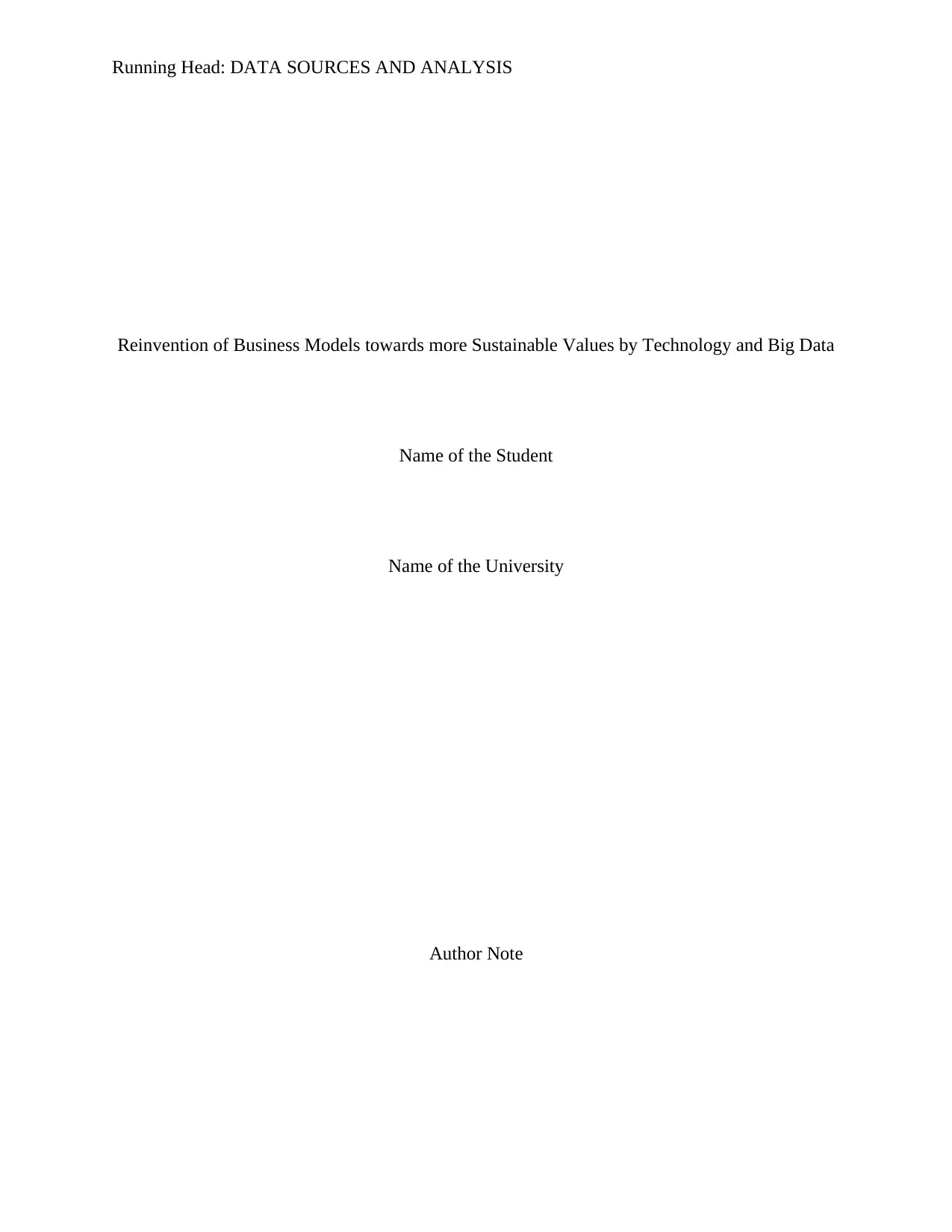
Running Head: DATA SOURCES AND ANALYSIS
Reinvention of Business Models towards more Sustainable Values by Technology and Big Data
Name of the Student
Name of the University
Author Note
Reinvention of Business Models towards more Sustainable Values by Technology and Big Data
Name of the Student
Name of the University
Author Note
Secure Best Marks with AI Grader
Need help grading? Try our AI Grader for instant feedback on your assignments.
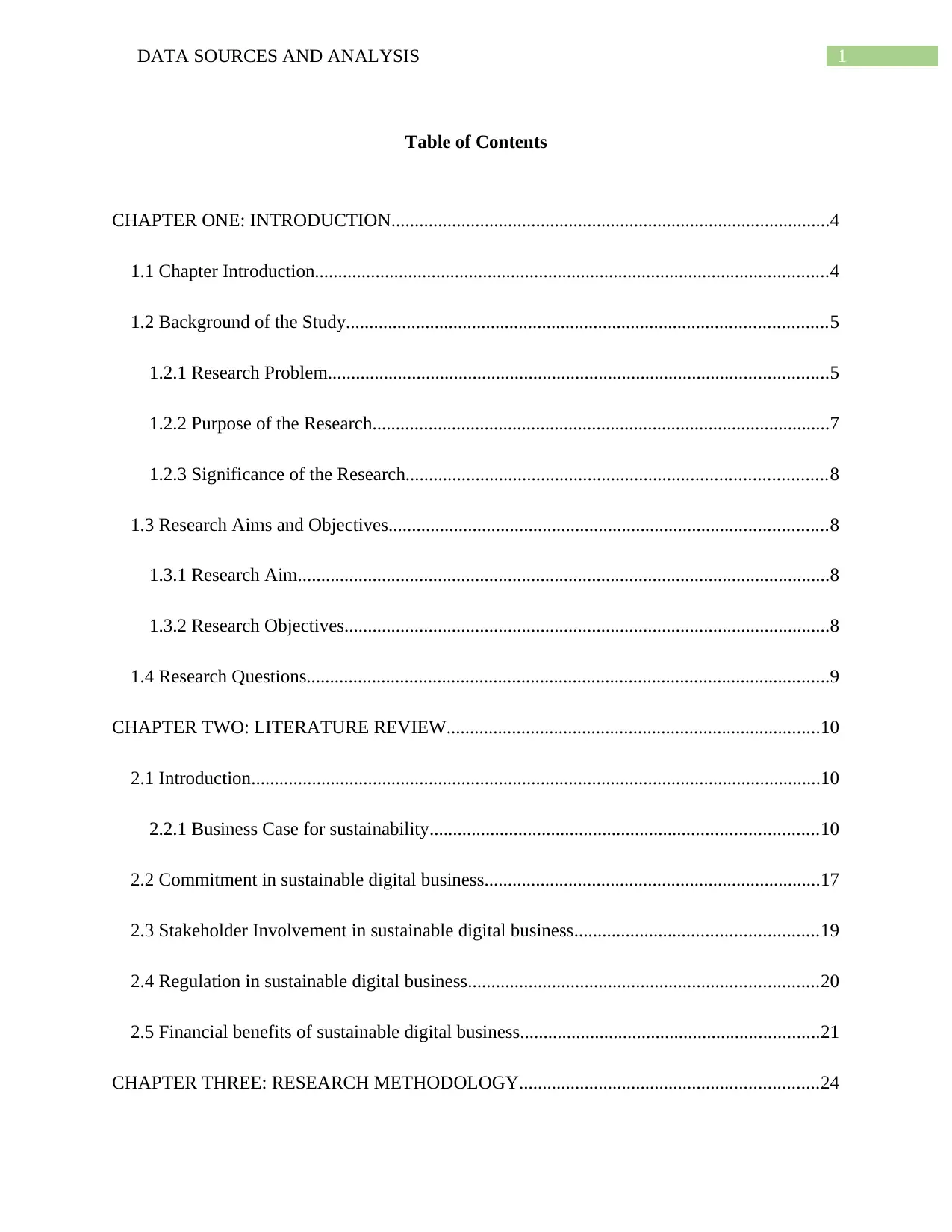
1DATA SOURCES AND ANALYSIS
Table of Contents
CHAPTER ONE: INTRODUCTION..............................................................................................4
1.1 Chapter Introduction..............................................................................................................4
1.2 Background of the Study.......................................................................................................5
1.2.1 Research Problem...........................................................................................................5
1.2.2 Purpose of the Research..................................................................................................7
1.2.3 Significance of the Research..........................................................................................8
1.3 Research Aims and Objectives..............................................................................................8
1.3.1 Research Aim..................................................................................................................8
1.3.2 Research Objectives........................................................................................................8
1.4 Research Questions................................................................................................................9
CHAPTER TWO: LITERATURE REVIEW................................................................................10
2.1 Introduction..........................................................................................................................10
2.2.1 Business Case for sustainability...................................................................................10
2.2 Commitment in sustainable digital business........................................................................17
2.3 Stakeholder Involvement in sustainable digital business....................................................19
2.4 Regulation in sustainable digital business...........................................................................20
2.5 Financial benefits of sustainable digital business................................................................21
CHAPTER THREE: RESEARCH METHODOLOGY................................................................24
Table of Contents
CHAPTER ONE: INTRODUCTION..............................................................................................4
1.1 Chapter Introduction..............................................................................................................4
1.2 Background of the Study.......................................................................................................5
1.2.1 Research Problem...........................................................................................................5
1.2.2 Purpose of the Research..................................................................................................7
1.2.3 Significance of the Research..........................................................................................8
1.3 Research Aims and Objectives..............................................................................................8
1.3.1 Research Aim..................................................................................................................8
1.3.2 Research Objectives........................................................................................................8
1.4 Research Questions................................................................................................................9
CHAPTER TWO: LITERATURE REVIEW................................................................................10
2.1 Introduction..........................................................................................................................10
2.2.1 Business Case for sustainability...................................................................................10
2.2 Commitment in sustainable digital business........................................................................17
2.3 Stakeholder Involvement in sustainable digital business....................................................19
2.4 Regulation in sustainable digital business...........................................................................20
2.5 Financial benefits of sustainable digital business................................................................21
CHAPTER THREE: RESEARCH METHODOLOGY................................................................24
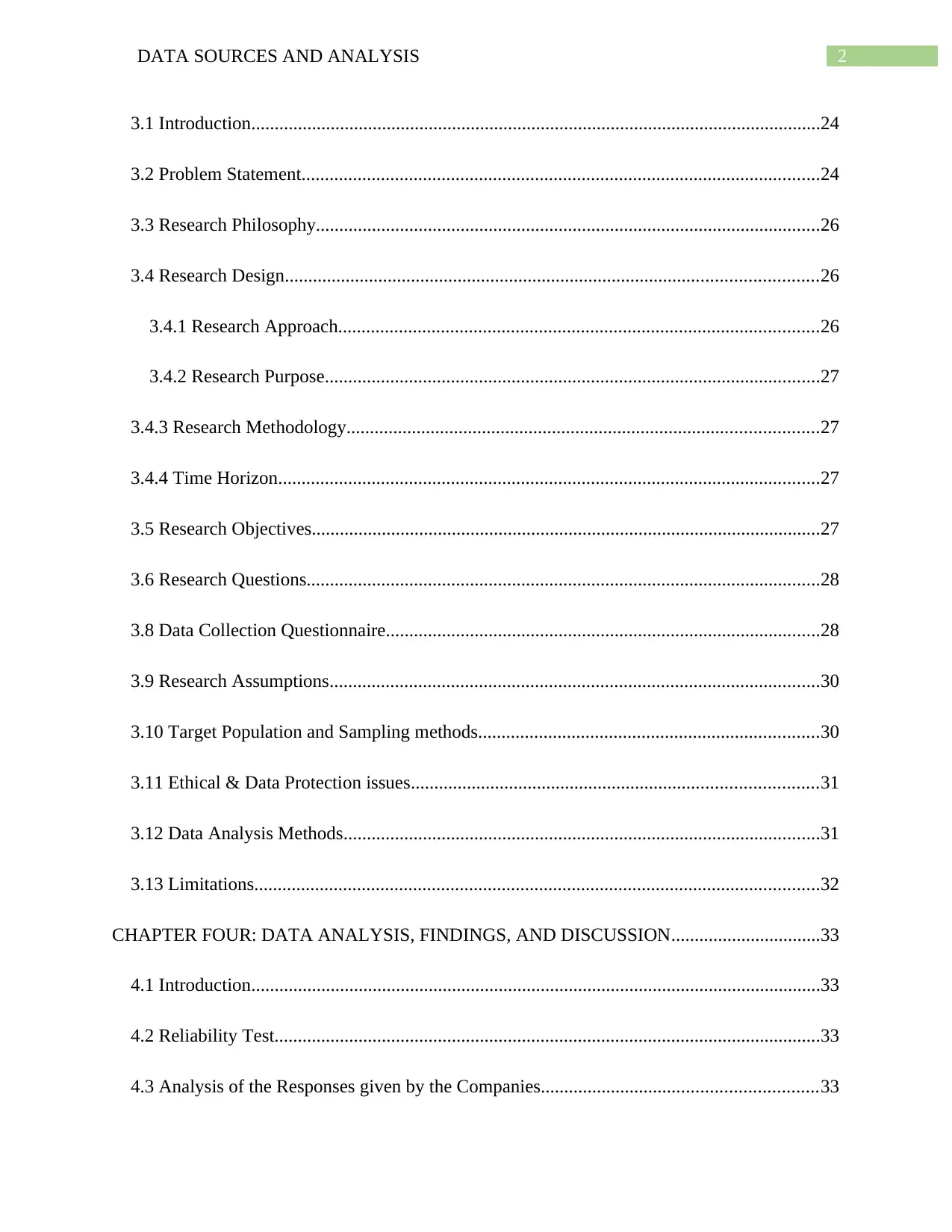
2DATA SOURCES AND ANALYSIS
3.1 Introduction..........................................................................................................................24
3.2 Problem Statement...............................................................................................................24
3.3 Research Philosophy............................................................................................................26
3.4 Research Design..................................................................................................................26
3.4.1 Research Approach.......................................................................................................26
3.4.2 Research Purpose..........................................................................................................27
3.4.3 Research Methodology.....................................................................................................27
3.4.4 Time Horizon....................................................................................................................27
3.5 Research Objectives.............................................................................................................27
3.6 Research Questions..............................................................................................................28
3.8 Data Collection Questionnaire.............................................................................................28
3.9 Research Assumptions.........................................................................................................30
3.10 Target Population and Sampling methods.........................................................................30
3.11 Ethical & Data Protection issues.......................................................................................31
3.12 Data Analysis Methods......................................................................................................31
3.13 Limitations.........................................................................................................................32
CHAPTER FOUR: DATA ANALYSIS, FINDINGS, AND DISCUSSION................................33
4.1 Introduction..........................................................................................................................33
4.2 Reliability Test.....................................................................................................................33
4.3 Analysis of the Responses given by the Companies...........................................................33
3.1 Introduction..........................................................................................................................24
3.2 Problem Statement...............................................................................................................24
3.3 Research Philosophy............................................................................................................26
3.4 Research Design..................................................................................................................26
3.4.1 Research Approach.......................................................................................................26
3.4.2 Research Purpose..........................................................................................................27
3.4.3 Research Methodology.....................................................................................................27
3.4.4 Time Horizon....................................................................................................................27
3.5 Research Objectives.............................................................................................................27
3.6 Research Questions..............................................................................................................28
3.8 Data Collection Questionnaire.............................................................................................28
3.9 Research Assumptions.........................................................................................................30
3.10 Target Population and Sampling methods.........................................................................30
3.11 Ethical & Data Protection issues.......................................................................................31
3.12 Data Analysis Methods......................................................................................................31
3.13 Limitations.........................................................................................................................32
CHAPTER FOUR: DATA ANALYSIS, FINDINGS, AND DISCUSSION................................33
4.1 Introduction..........................................................................................................................33
4.2 Reliability Test.....................................................................................................................33
4.3 Analysis of the Responses given by the Companies...........................................................33
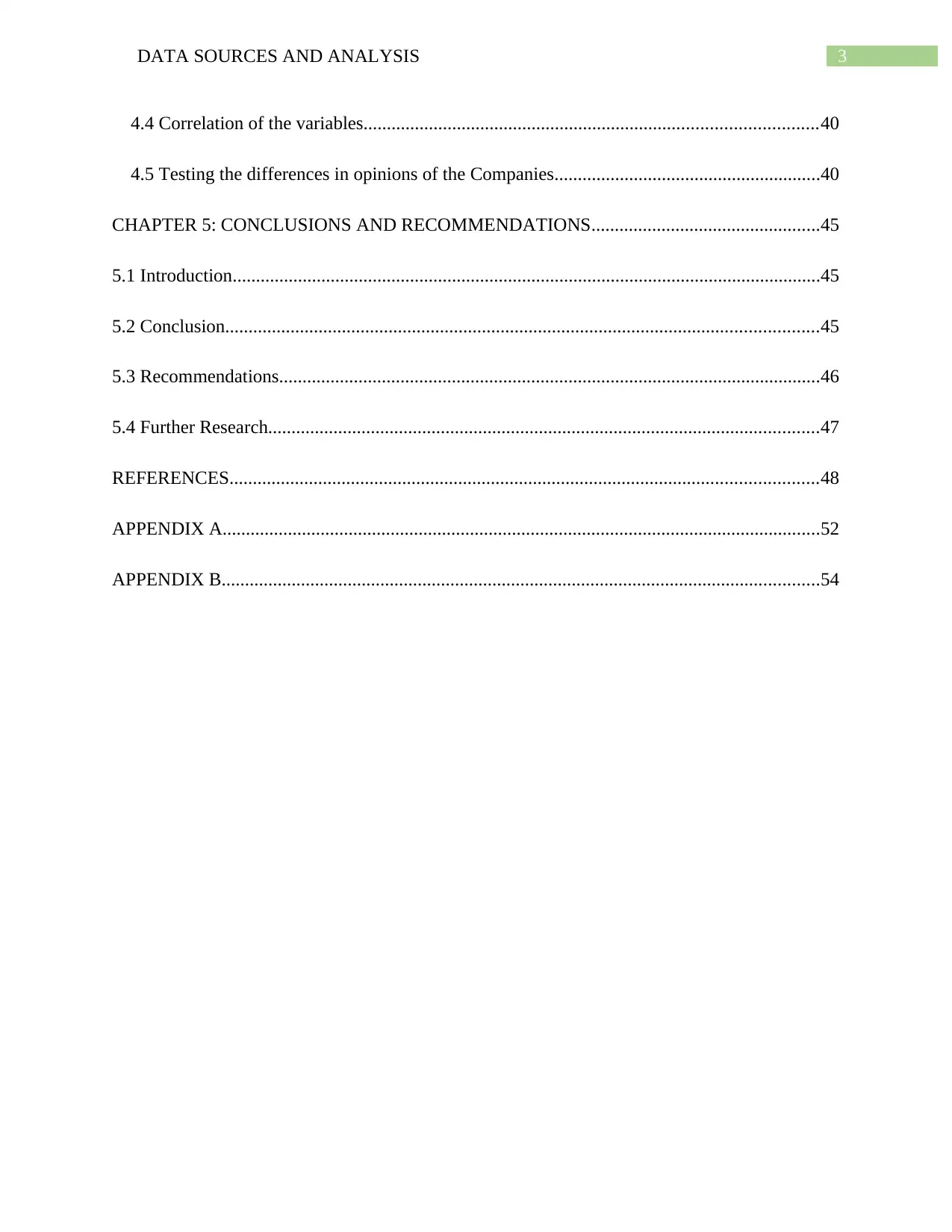
3DATA SOURCES AND ANALYSIS
4.4 Correlation of the variables.................................................................................................40
4.5 Testing the differences in opinions of the Companies.........................................................40
CHAPTER 5: CONCLUSIONS AND RECOMMENDATIONS.................................................45
5.1 Introduction..............................................................................................................................45
5.2 Conclusion...............................................................................................................................45
5.3 Recommendations....................................................................................................................46
5.4 Further Research......................................................................................................................47
REFERENCES..............................................................................................................................48
APPENDIX A................................................................................................................................52
APPENDIX B................................................................................................................................54
4.4 Correlation of the variables.................................................................................................40
4.5 Testing the differences in opinions of the Companies.........................................................40
CHAPTER 5: CONCLUSIONS AND RECOMMENDATIONS.................................................45
5.1 Introduction..............................................................................................................................45
5.2 Conclusion...............................................................................................................................45
5.3 Recommendations....................................................................................................................46
5.4 Further Research......................................................................................................................47
REFERENCES..............................................................................................................................48
APPENDIX A................................................................................................................................52
APPENDIX B................................................................................................................................54
Secure Best Marks with AI Grader
Need help grading? Try our AI Grader for instant feedback on your assignments.
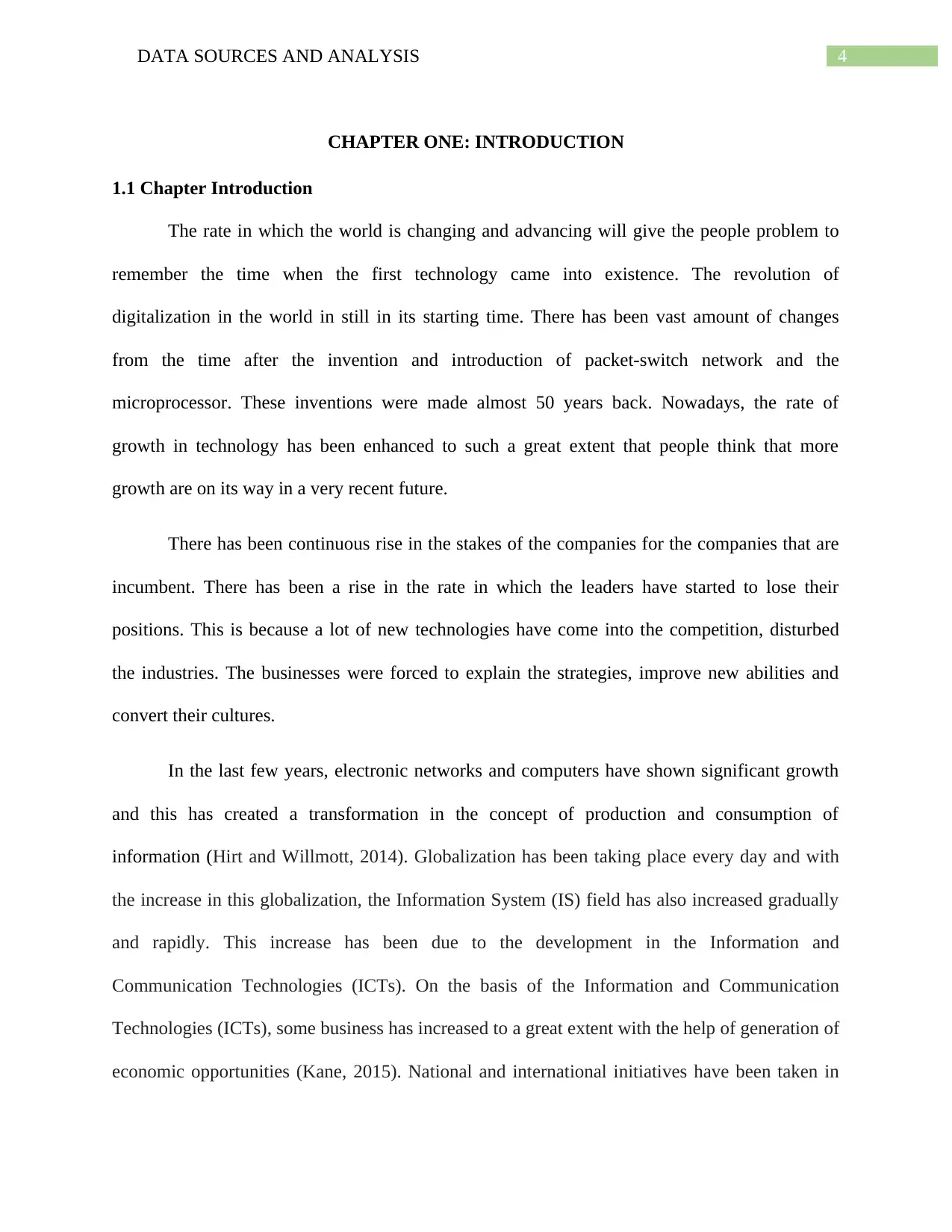
4DATA SOURCES AND ANALYSIS
CHAPTER ONE: INTRODUCTION
1.1 Chapter Introduction
The rate in which the world is changing and advancing will give the people problem to
remember the time when the first technology came into existence. The revolution of
digitalization in the world in still in its starting time. There has been vast amount of changes
from the time after the invention and introduction of packet-switch network and the
microprocessor. These inventions were made almost 50 years back. Nowadays, the rate of
growth in technology has been enhanced to such a great extent that people think that more
growth are on its way in a very recent future.
There has been continuous rise in the stakes of the companies for the companies that are
incumbent. There has been a rise in the rate in which the leaders have started to lose their
positions. This is because a lot of new technologies have come into the competition, disturbed
the industries. The businesses were forced to explain the strategies, improve new abilities and
convert their cultures.
In the last few years, electronic networks and computers have shown significant growth
and this has created a transformation in the concept of production and consumption of
information (Hirt and Willmott, 2014). Globalization has been taking place every day and with
the increase in this globalization, the Information System (IS) field has also increased gradually
and rapidly. This increase has been due to the development in the Information and
Communication Technologies (ICTs). On the basis of the Information and Communication
Technologies (ICTs), some business has increased to a great extent with the help of generation of
economic opportunities (Kane, 2015). National and international initiatives have been taken in
CHAPTER ONE: INTRODUCTION
1.1 Chapter Introduction
The rate in which the world is changing and advancing will give the people problem to
remember the time when the first technology came into existence. The revolution of
digitalization in the world in still in its starting time. There has been vast amount of changes
from the time after the invention and introduction of packet-switch network and the
microprocessor. These inventions were made almost 50 years back. Nowadays, the rate of
growth in technology has been enhanced to such a great extent that people think that more
growth are on its way in a very recent future.
There has been continuous rise in the stakes of the companies for the companies that are
incumbent. There has been a rise in the rate in which the leaders have started to lose their
positions. This is because a lot of new technologies have come into the competition, disturbed
the industries. The businesses were forced to explain the strategies, improve new abilities and
convert their cultures.
In the last few years, electronic networks and computers have shown significant growth
and this has created a transformation in the concept of production and consumption of
information (Hirt and Willmott, 2014). Globalization has been taking place every day and with
the increase in this globalization, the Information System (IS) field has also increased gradually
and rapidly. This increase has been due to the development in the Information and
Communication Technologies (ICTs). On the basis of the Information and Communication
Technologies (ICTs), some business has increased to a great extent with the help of generation of
economic opportunities (Kane, 2015). National and international initiatives have been taken in
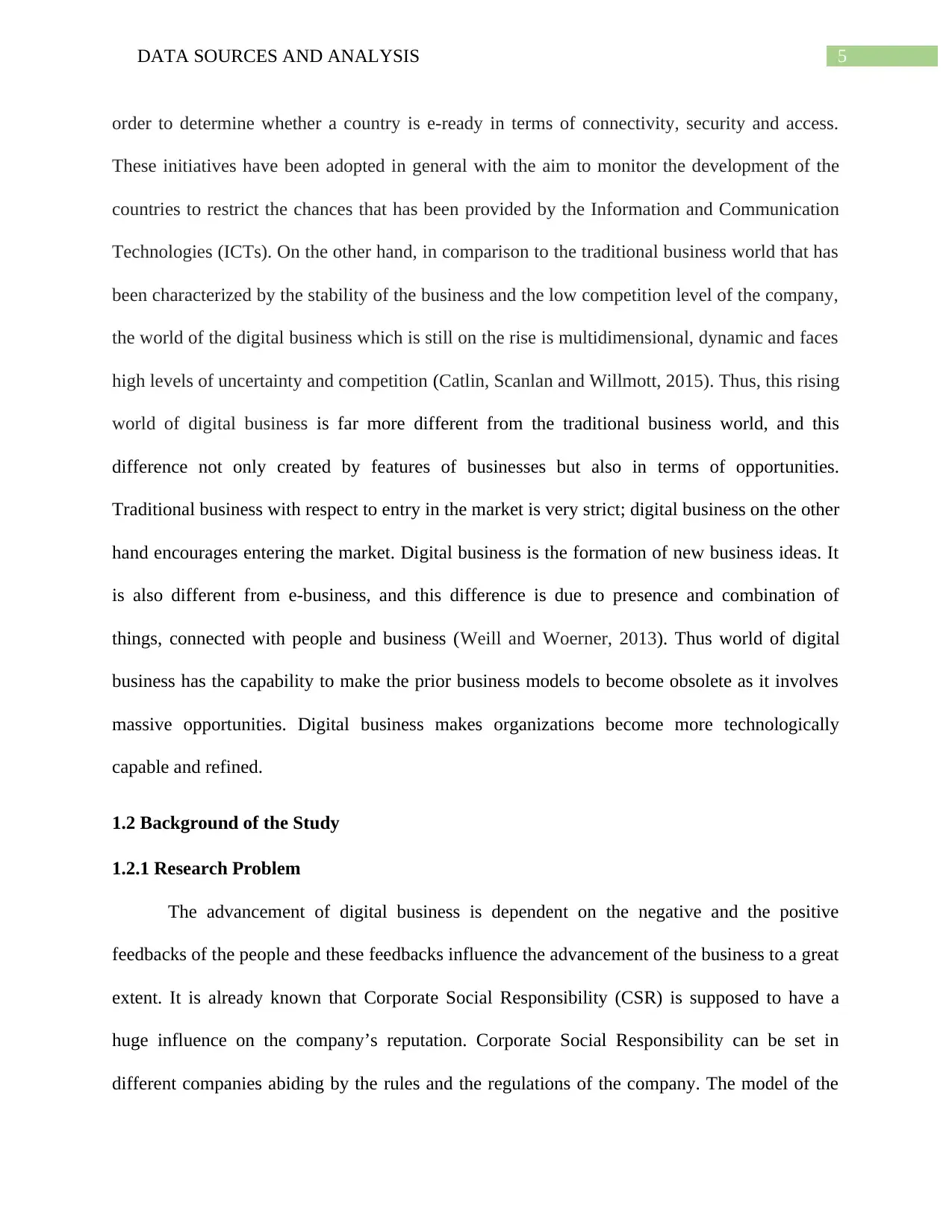
5DATA SOURCES AND ANALYSIS
order to determine whether a country is e-ready in terms of connectivity, security and access.
These initiatives have been adopted in general with the aim to monitor the development of the
countries to restrict the chances that has been provided by the Information and Communication
Technologies (ICTs). On the other hand, in comparison to the traditional business world that has
been characterized by the stability of the business and the low competition level of the company,
the world of the digital business which is still on the rise is multidimensional, dynamic and faces
high levels of uncertainty and competition (Catlin, Scanlan and Willmott, 2015). Thus, this rising
world of digital business is far more different from the traditional business world, and this
difference not only created by features of businesses but also in terms of opportunities.
Traditional business with respect to entry in the market is very strict; digital business on the other
hand encourages entering the market. Digital business is the formation of new business ideas. It
is also different from e-business, and this difference is due to presence and combination of
things, connected with people and business (Weill and Woerner, 2013). Thus world of digital
business has the capability to make the prior business models to become obsolete as it involves
massive opportunities. Digital business makes organizations become more technologically
capable and refined.
1.2 Background of the Study
1.2.1 Research Problem
The advancement of digital business is dependent on the negative and the positive
feedbacks of the people and these feedbacks influence the advancement of the business to a great
extent. It is already known that Corporate Social Responsibility (CSR) is supposed to have a
huge influence on the company’s reputation. Corporate Social Responsibility can be set in
different companies abiding by the rules and the regulations of the company. The model of the
order to determine whether a country is e-ready in terms of connectivity, security and access.
These initiatives have been adopted in general with the aim to monitor the development of the
countries to restrict the chances that has been provided by the Information and Communication
Technologies (ICTs). On the other hand, in comparison to the traditional business world that has
been characterized by the stability of the business and the low competition level of the company,
the world of the digital business which is still on the rise is multidimensional, dynamic and faces
high levels of uncertainty and competition (Catlin, Scanlan and Willmott, 2015). Thus, this rising
world of digital business is far more different from the traditional business world, and this
difference not only created by features of businesses but also in terms of opportunities.
Traditional business with respect to entry in the market is very strict; digital business on the other
hand encourages entering the market. Digital business is the formation of new business ideas. It
is also different from e-business, and this difference is due to presence and combination of
things, connected with people and business (Weill and Woerner, 2013). Thus world of digital
business has the capability to make the prior business models to become obsolete as it involves
massive opportunities. Digital business makes organizations become more technologically
capable and refined.
1.2 Background of the Study
1.2.1 Research Problem
The advancement of digital business is dependent on the negative and the positive
feedbacks of the people and these feedbacks influence the advancement of the business to a great
extent. It is already known that Corporate Social Responsibility (CSR) is supposed to have a
huge influence on the company’s reputation. Corporate Social Responsibility can be set in
different companies abiding by the rules and the regulations of the company. The model of the
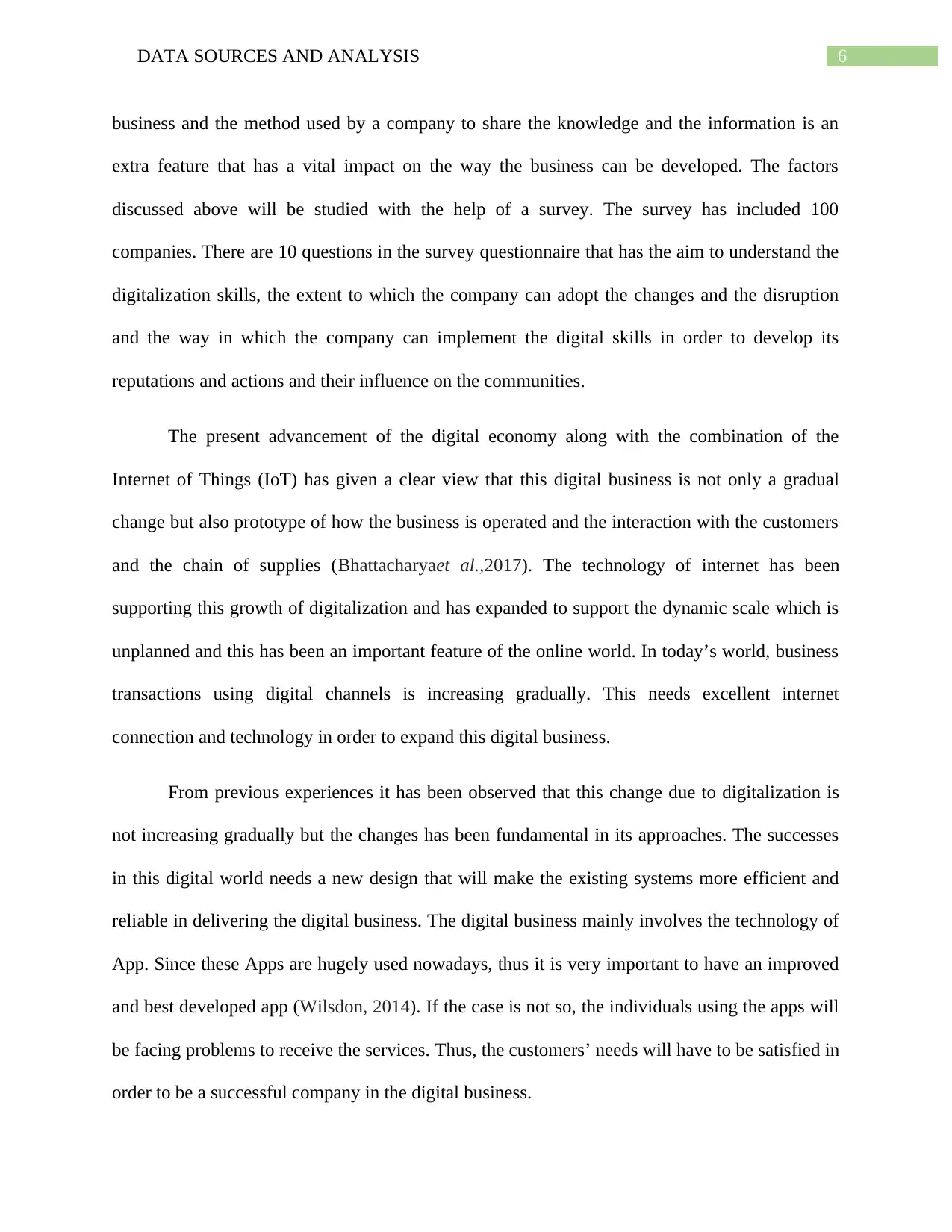
6DATA SOURCES AND ANALYSIS
business and the method used by a company to share the knowledge and the information is an
extra feature that has a vital impact on the way the business can be developed. The factors
discussed above will be studied with the help of a survey. The survey has included 100
companies. There are 10 questions in the survey questionnaire that has the aim to understand the
digitalization skills, the extent to which the company can adopt the changes and the disruption
and the way in which the company can implement the digital skills in order to develop its
reputations and actions and their influence on the communities.
The present advancement of the digital economy along with the combination of the
Internet of Things (IoT) has given a clear view that this digital business is not only a gradual
change but also prototype of how the business is operated and the interaction with the customers
and the chain of supplies (Bhattacharyaet al.,2017). The technology of internet has been
supporting this growth of digitalization and has expanded to support the dynamic scale which is
unplanned and this has been an important feature of the online world. In today’s world, business
transactions using digital channels is increasing gradually. This needs excellent internet
connection and technology in order to expand this digital business.
From previous experiences it has been observed that this change due to digitalization is
not increasing gradually but the changes has been fundamental in its approaches. The successes
in this digital world needs a new design that will make the existing systems more efficient and
reliable in delivering the digital business. The digital business mainly involves the technology of
App. Since these Apps are hugely used nowadays, thus it is very important to have an improved
and best developed app (Wilsdon, 2014). If the case is not so, the individuals using the apps will
be facing problems to receive the services. Thus, the customers’ needs will have to be satisfied in
order to be a successful company in the digital business.
business and the method used by a company to share the knowledge and the information is an
extra feature that has a vital impact on the way the business can be developed. The factors
discussed above will be studied with the help of a survey. The survey has included 100
companies. There are 10 questions in the survey questionnaire that has the aim to understand the
digitalization skills, the extent to which the company can adopt the changes and the disruption
and the way in which the company can implement the digital skills in order to develop its
reputations and actions and their influence on the communities.
The present advancement of the digital economy along with the combination of the
Internet of Things (IoT) has given a clear view that this digital business is not only a gradual
change but also prototype of how the business is operated and the interaction with the customers
and the chain of supplies (Bhattacharyaet al.,2017). The technology of internet has been
supporting this growth of digitalization and has expanded to support the dynamic scale which is
unplanned and this has been an important feature of the online world. In today’s world, business
transactions using digital channels is increasing gradually. This needs excellent internet
connection and technology in order to expand this digital business.
From previous experiences it has been observed that this change due to digitalization is
not increasing gradually but the changes has been fundamental in its approaches. The successes
in this digital world needs a new design that will make the existing systems more efficient and
reliable in delivering the digital business. The digital business mainly involves the technology of
App. Since these Apps are hugely used nowadays, thus it is very important to have an improved
and best developed app (Wilsdon, 2014). If the case is not so, the individuals using the apps will
be facing problems to receive the services. Thus, the customers’ needs will have to be satisfied in
order to be a successful company in the digital business.
Paraphrase This Document
Need a fresh take? Get an instant paraphrase of this document with our AI Paraphraser
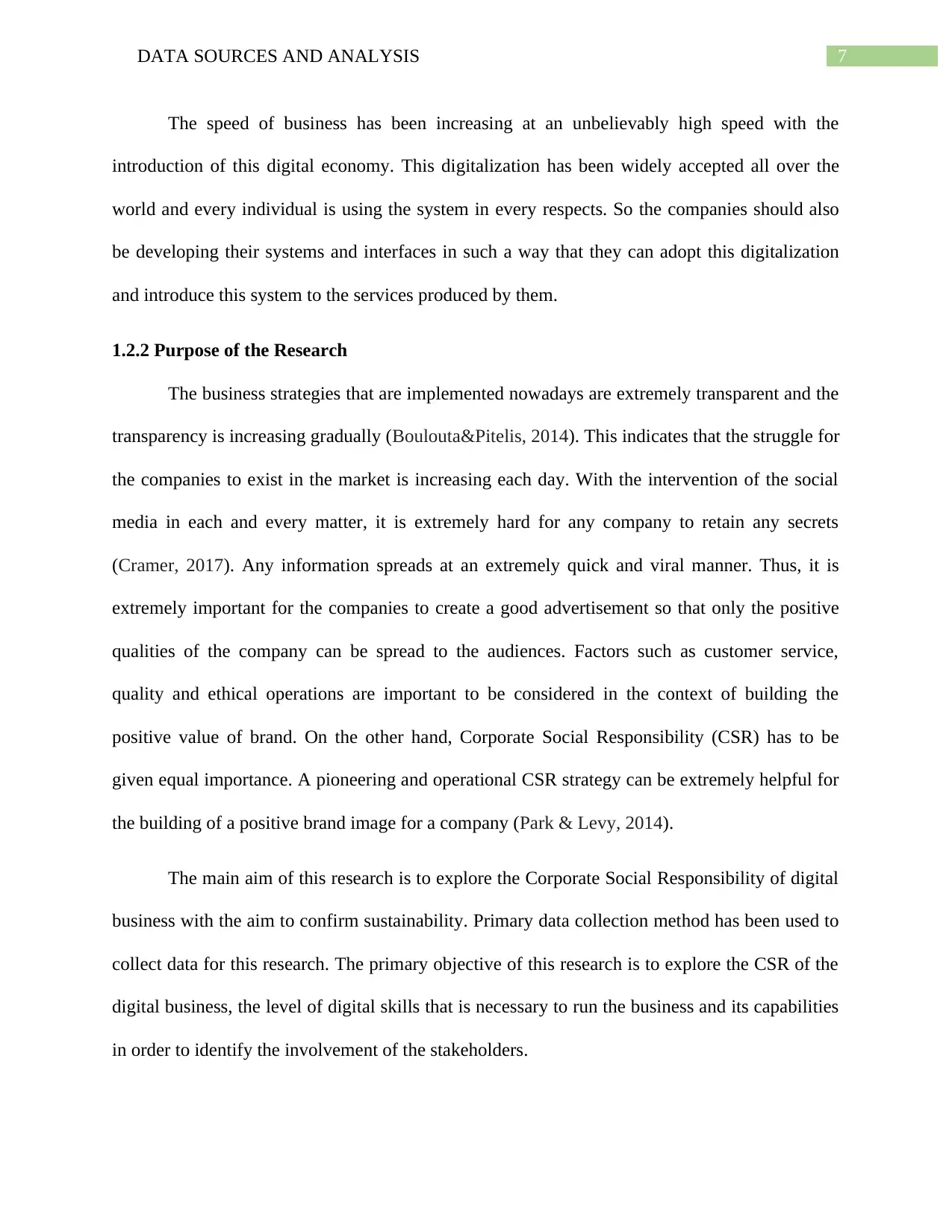
7DATA SOURCES AND ANALYSIS
The speed of business has been increasing at an unbelievably high speed with the
introduction of this digital economy. This digitalization has been widely accepted all over the
world and every individual is using the system in every respects. So the companies should also
be developing their systems and interfaces in such a way that they can adopt this digitalization
and introduce this system to the services produced by them.
1.2.2 Purpose of the Research
The business strategies that are implemented nowadays are extremely transparent and the
transparency is increasing gradually (Boulouta&Pitelis, 2014). This indicates that the struggle for
the companies to exist in the market is increasing each day. With the intervention of the social
media in each and every matter, it is extremely hard for any company to retain any secrets
(Cramer, 2017). Any information spreads at an extremely quick and viral manner. Thus, it is
extremely important for the companies to create a good advertisement so that only the positive
qualities of the company can be spread to the audiences. Factors such as customer service,
quality and ethical operations are important to be considered in the context of building the
positive value of brand. On the other hand, Corporate Social Responsibility (CSR) has to be
given equal importance. A pioneering and operational CSR strategy can be extremely helpful for
the building of a positive brand image for a company (Park & Levy, 2014).
The main aim of this research is to explore the Corporate Social Responsibility of digital
business with the aim to confirm sustainability. Primary data collection method has been used to
collect data for this research. The primary objective of this research is to explore the CSR of the
digital business, the level of digital skills that is necessary to run the business and its capabilities
in order to identify the involvement of the stakeholders.
The speed of business has been increasing at an unbelievably high speed with the
introduction of this digital economy. This digitalization has been widely accepted all over the
world and every individual is using the system in every respects. So the companies should also
be developing their systems and interfaces in such a way that they can adopt this digitalization
and introduce this system to the services produced by them.
1.2.2 Purpose of the Research
The business strategies that are implemented nowadays are extremely transparent and the
transparency is increasing gradually (Boulouta&Pitelis, 2014). This indicates that the struggle for
the companies to exist in the market is increasing each day. With the intervention of the social
media in each and every matter, it is extremely hard for any company to retain any secrets
(Cramer, 2017). Any information spreads at an extremely quick and viral manner. Thus, it is
extremely important for the companies to create a good advertisement so that only the positive
qualities of the company can be spread to the audiences. Factors such as customer service,
quality and ethical operations are important to be considered in the context of building the
positive value of brand. On the other hand, Corporate Social Responsibility (CSR) has to be
given equal importance. A pioneering and operational CSR strategy can be extremely helpful for
the building of a positive brand image for a company (Park & Levy, 2014).
The main aim of this research is to explore the Corporate Social Responsibility of digital
business with the aim to confirm sustainability. Primary data collection method has been used to
collect data for this research. The primary objective of this research is to explore the CSR of the
digital business, the level of digital skills that is necessary to run the business and its capabilities
in order to identify the involvement of the stakeholders.
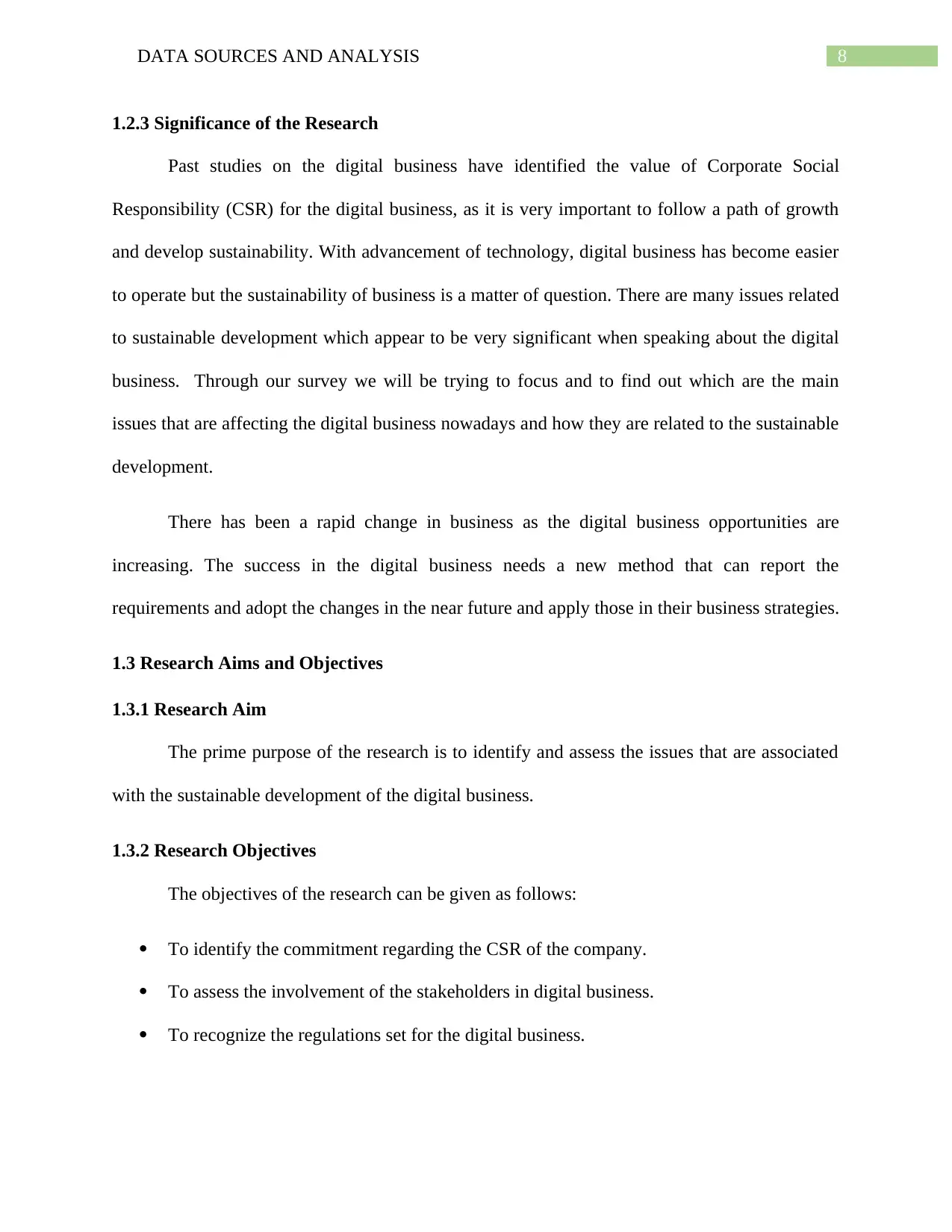
8DATA SOURCES AND ANALYSIS
1.2.3 Significance of the Research
Past studies on the digital business have identified the value of Corporate Social
Responsibility (CSR) for the digital business, as it is very important to follow a path of growth
and develop sustainability. With advancement of technology, digital business has become easier
to operate but the sustainability of business is a matter of question. There are many issues related
to sustainable development which appear to be very significant when speaking about the digital
business. Through our survey we will be trying to focus and to find out which are the main
issues that are affecting the digital business nowadays and how they are related to the sustainable
development.
There has been a rapid change in business as the digital business opportunities are
increasing. The success in the digital business needs a new method that can report the
requirements and adopt the changes in the near future and apply those in their business strategies.
1.3 Research Aims and Objectives
1.3.1 Research Aim
The prime purpose of the research is to identify and assess the issues that are associated
with the sustainable development of the digital business.
1.3.2 Research Objectives
The objectives of the research can be given as follows:
To identify the commitment regarding the CSR of the company.
To assess the involvement of the stakeholders in digital business.
To recognize the regulations set for the digital business.
1.2.3 Significance of the Research
Past studies on the digital business have identified the value of Corporate Social
Responsibility (CSR) for the digital business, as it is very important to follow a path of growth
and develop sustainability. With advancement of technology, digital business has become easier
to operate but the sustainability of business is a matter of question. There are many issues related
to sustainable development which appear to be very significant when speaking about the digital
business. Through our survey we will be trying to focus and to find out which are the main
issues that are affecting the digital business nowadays and how they are related to the sustainable
development.
There has been a rapid change in business as the digital business opportunities are
increasing. The success in the digital business needs a new method that can report the
requirements and adopt the changes in the near future and apply those in their business strategies.
1.3 Research Aims and Objectives
1.3.1 Research Aim
The prime purpose of the research is to identify and assess the issues that are associated
with the sustainable development of the digital business.
1.3.2 Research Objectives
The objectives of the research can be given as follows:
To identify the commitment regarding the CSR of the company.
To assess the involvement of the stakeholders in digital business.
To recognize the regulations set for the digital business.
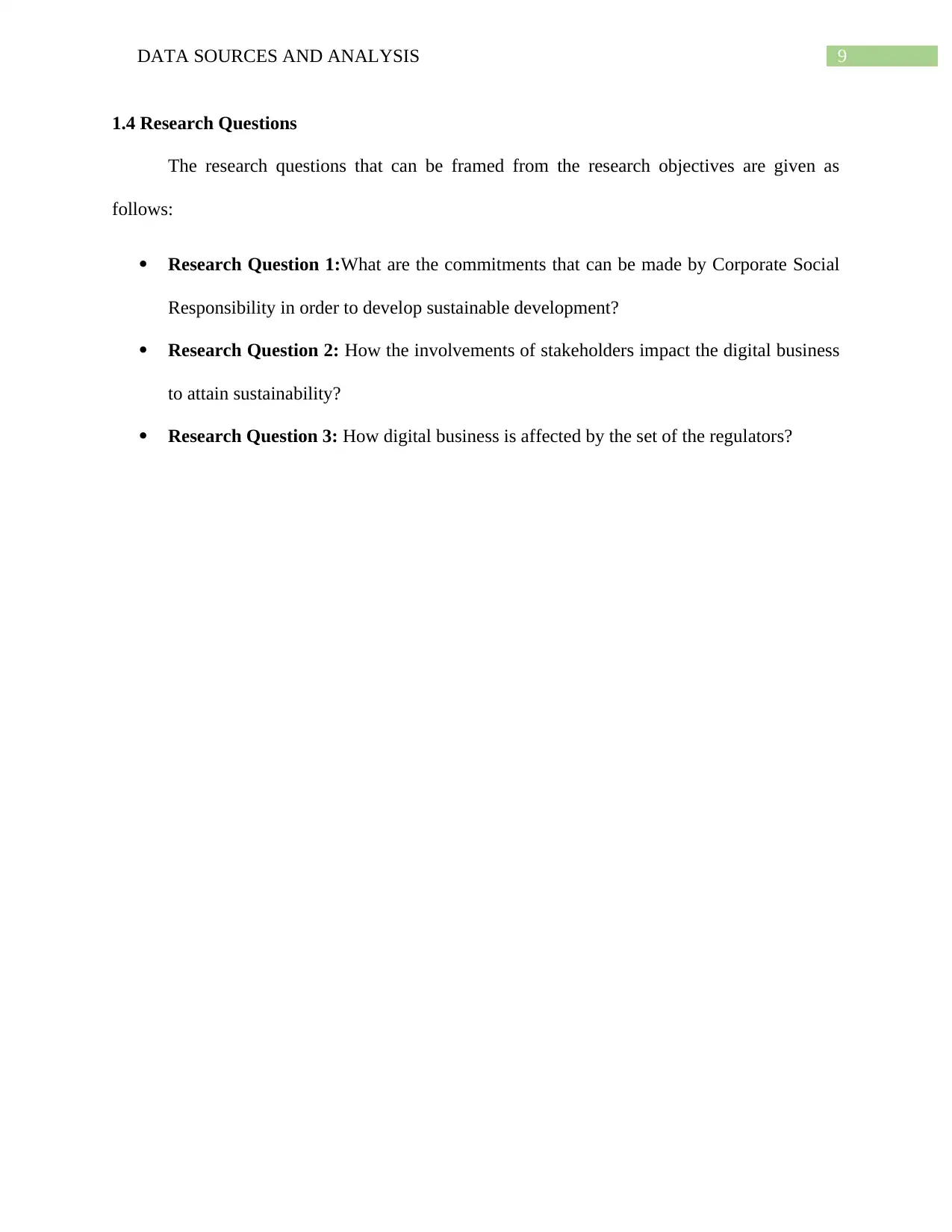
9DATA SOURCES AND ANALYSIS
1.4 Research Questions
The research questions that can be framed from the research objectives are given as
follows:
Research Question 1:What are the commitments that can be made by Corporate Social
Responsibility in order to develop sustainable development?
Research Question 2: How the involvements of stakeholders impact the digital business
to attain sustainability?
Research Question 3: How digital business is affected by the set of the regulators?
1.4 Research Questions
The research questions that can be framed from the research objectives are given as
follows:
Research Question 1:What are the commitments that can be made by Corporate Social
Responsibility in order to develop sustainable development?
Research Question 2: How the involvements of stakeholders impact the digital business
to attain sustainability?
Research Question 3: How digital business is affected by the set of the regulators?
Secure Best Marks with AI Grader
Need help grading? Try our AI Grader for instant feedback on your assignments.
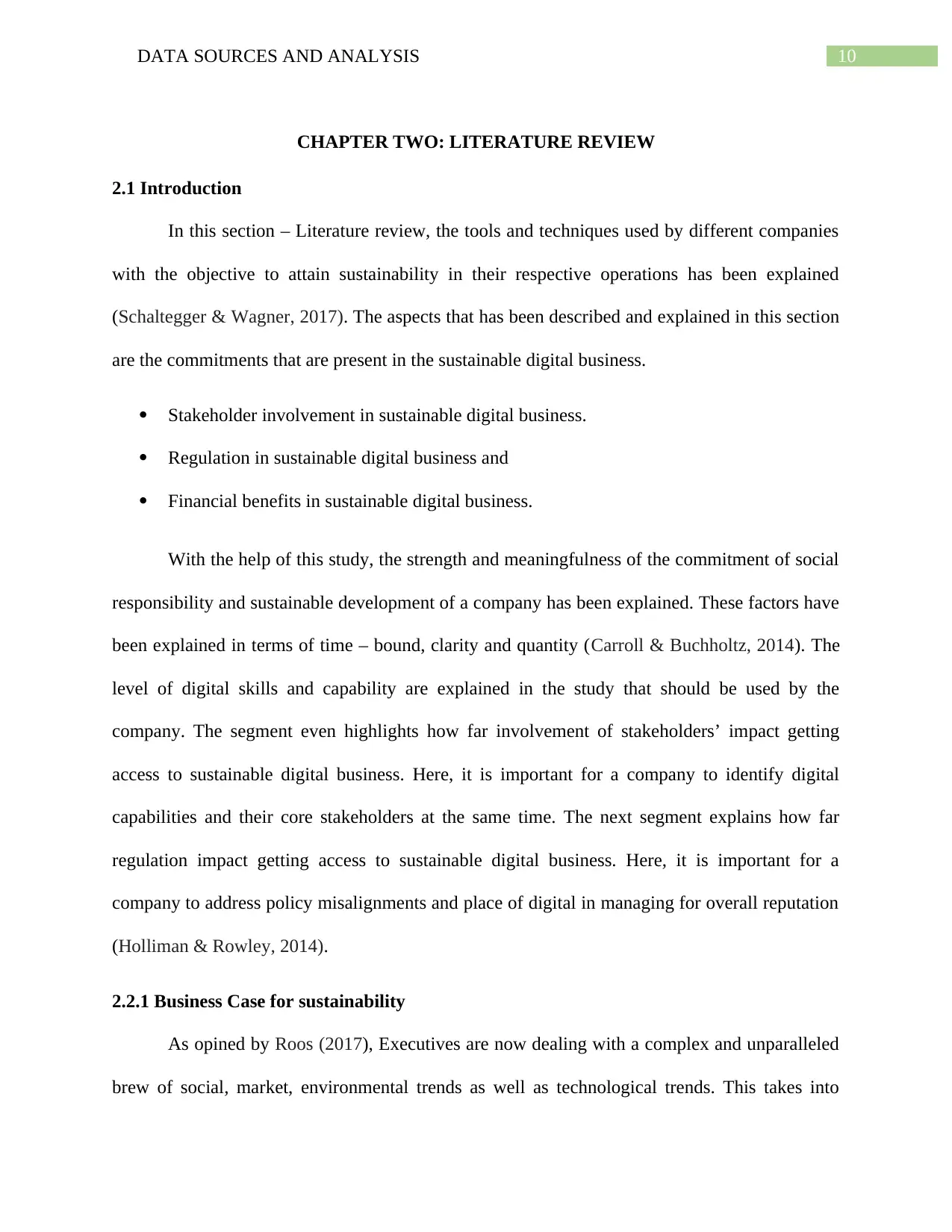
10DATA SOURCES AND ANALYSIS
CHAPTER TWO: LITERATURE REVIEW
2.1 Introduction
In this section – Literature review, the tools and techniques used by different companies
with the objective to attain sustainability in their respective operations has been explained
(Schaltegger & Wagner, 2017). The aspects that has been described and explained in this section
are the commitments that are present in the sustainable digital business.
Stakeholder involvement in sustainable digital business.
Regulation in sustainable digital business and
Financial benefits in sustainable digital business.
With the help of this study, the strength and meaningfulness of the commitment of social
responsibility and sustainable development of a company has been explained. These factors have
been explained in terms of time – bound, clarity and quantity (Carroll & Buchholtz, 2014). The
level of digital skills and capability are explained in the study that should be used by the
company. The segment even highlights how far involvement of stakeholders’ impact getting
access to sustainable digital business. Here, it is important for a company to identify digital
capabilities and their core stakeholders at the same time. The next segment explains how far
regulation impact getting access to sustainable digital business. Here, it is important for a
company to address policy misalignments and place of digital in managing for overall reputation
(Holliman & Rowley, 2014).
2.2.1 Business Case for sustainability
As opined by Roos (2017), Executives are now dealing with a complex and unparalleled
brew of social, market, environmental trends as well as technological trends. This takes into
CHAPTER TWO: LITERATURE REVIEW
2.1 Introduction
In this section – Literature review, the tools and techniques used by different companies
with the objective to attain sustainability in their respective operations has been explained
(Schaltegger & Wagner, 2017). The aspects that has been described and explained in this section
are the commitments that are present in the sustainable digital business.
Stakeholder involvement in sustainable digital business.
Regulation in sustainable digital business and
Financial benefits in sustainable digital business.
With the help of this study, the strength and meaningfulness of the commitment of social
responsibility and sustainable development of a company has been explained. These factors have
been explained in terms of time – bound, clarity and quantity (Carroll & Buchholtz, 2014). The
level of digital skills and capability are explained in the study that should be used by the
company. The segment even highlights how far involvement of stakeholders’ impact getting
access to sustainable digital business. Here, it is important for a company to identify digital
capabilities and their core stakeholders at the same time. The next segment explains how far
regulation impact getting access to sustainable digital business. Here, it is important for a
company to address policy misalignments and place of digital in managing for overall reputation
(Holliman & Rowley, 2014).
2.2.1 Business Case for sustainability
As opined by Roos (2017), Executives are now dealing with a complex and unparalleled
brew of social, market, environmental trends as well as technological trends. This takes into
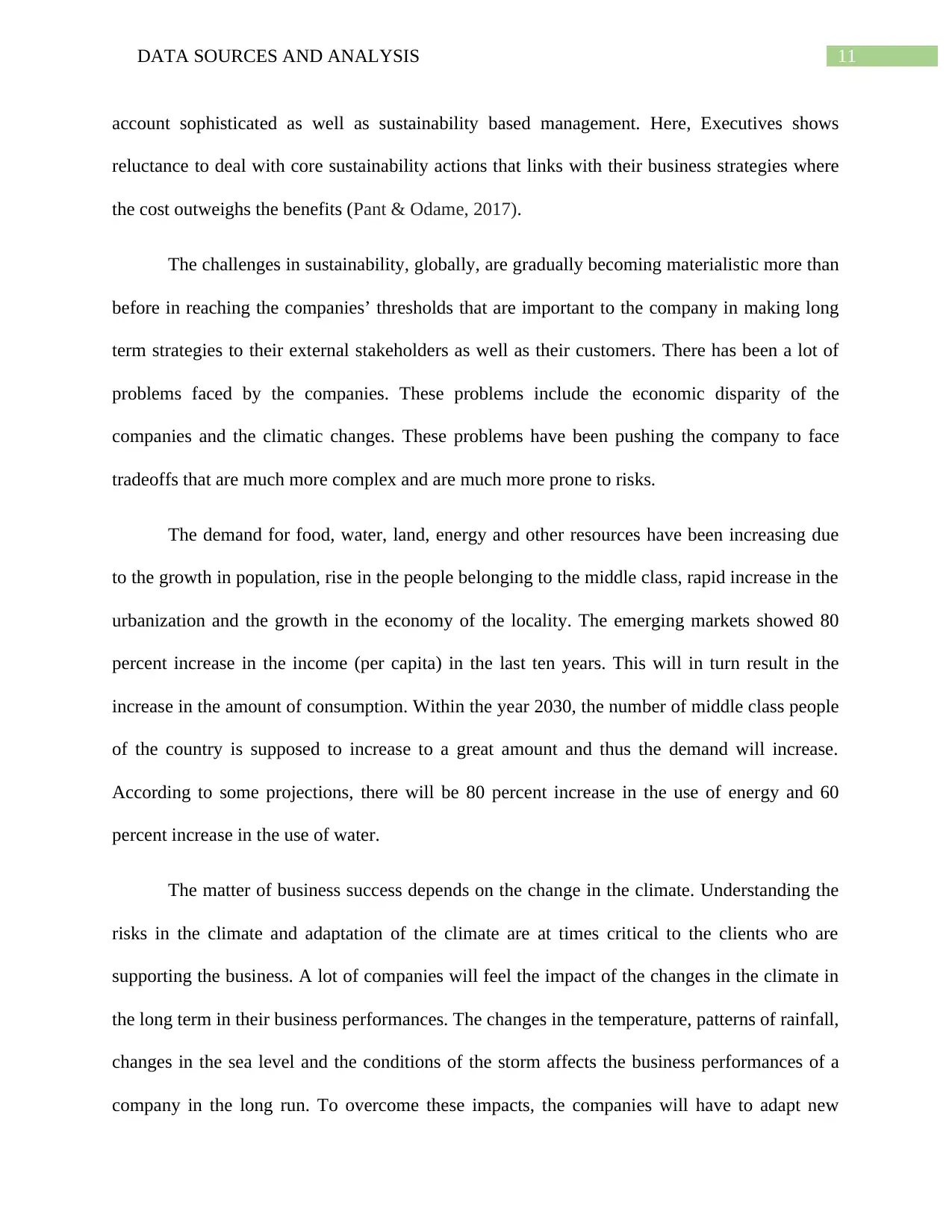
11DATA SOURCES AND ANALYSIS
account sophisticated as well as sustainability based management. Here, Executives shows
reluctance to deal with core sustainability actions that links with their business strategies where
the cost outweighs the benefits (Pant & Odame, 2017).
The challenges in sustainability, globally, are gradually becoming materialistic more than
before in reaching the companies’ thresholds that are important to the company in making long
term strategies to their external stakeholders as well as their customers. There has been a lot of
problems faced by the companies. These problems include the economic disparity of the
companies and the climatic changes. These problems have been pushing the company to face
tradeoffs that are much more complex and are much more prone to risks.
The demand for food, water, land, energy and other resources have been increasing due
to the growth in population, rise in the people belonging to the middle class, rapid increase in the
urbanization and the growth in the economy of the locality. The emerging markets showed 80
percent increase in the income (per capita) in the last ten years. This will in turn result in the
increase in the amount of consumption. Within the year 2030, the number of middle class people
of the country is supposed to increase to a great amount and thus the demand will increase.
According to some projections, there will be 80 percent increase in the use of energy and 60
percent increase in the use of water.
The matter of business success depends on the change in the climate. Understanding the
risks in the climate and adaptation of the climate are at times critical to the clients who are
supporting the business. A lot of companies will feel the impact of the changes in the climate in
the long term in their business performances. The changes in the temperature, patterns of rainfall,
changes in the sea level and the conditions of the storm affects the business performances of a
company in the long run. To overcome these impacts, the companies will have to adapt new
account sophisticated as well as sustainability based management. Here, Executives shows
reluctance to deal with core sustainability actions that links with their business strategies where
the cost outweighs the benefits (Pant & Odame, 2017).
The challenges in sustainability, globally, are gradually becoming materialistic more than
before in reaching the companies’ thresholds that are important to the company in making long
term strategies to their external stakeholders as well as their customers. There has been a lot of
problems faced by the companies. These problems include the economic disparity of the
companies and the climatic changes. These problems have been pushing the company to face
tradeoffs that are much more complex and are much more prone to risks.
The demand for food, water, land, energy and other resources have been increasing due
to the growth in population, rise in the people belonging to the middle class, rapid increase in the
urbanization and the growth in the economy of the locality. The emerging markets showed 80
percent increase in the income (per capita) in the last ten years. This will in turn result in the
increase in the amount of consumption. Within the year 2030, the number of middle class people
of the country is supposed to increase to a great amount and thus the demand will increase.
According to some projections, there will be 80 percent increase in the use of energy and 60
percent increase in the use of water.
The matter of business success depends on the change in the climate. Understanding the
risks in the climate and adaptation of the climate are at times critical to the clients who are
supporting the business. A lot of companies will feel the impact of the changes in the climate in
the long term in their business performances. The changes in the temperature, patterns of rainfall,
changes in the sea level and the conditions of the storm affects the business performances of a
company in the long run. To overcome these impacts, the companies will have to adapt new

12DATA SOURCES AND ANALYSIS
business strategies. The public of the locality also forces the companies to decrease the amount
of emission of greenhouse gases. The emission of greenhouse gases has increased to an amount
of 6 percent in 2010. This increase is the highest in all these years. A lot of companies are
changing their strategies to cope up with the situation of climatic changes. The companies are
also evaluating their emissions of internal and supply chain and also examines the approach the
companies take towards the change in the climate throughout the operations they are providing
and their value chain.
The uncertainty and the volatility of the companies will definitely have an impact on the
private sector as well as the consumers. In a lot of countries, the price of food has risen
significantly. This has increased the people in poverty and the vulnerable people has become
even more vulnerable. On the other hand, there can be civil unrest in the growing markets due
the price of the resources which is high. These resources include food, water and energy. The
private sectors face uncertainty when there is volatility in the price of the resources. This creates
some specific risks that are related to the investments of the productivity and distorts the
efficiency of the supply chain potentially.
Challenges Creating Business Values
One of the important factors that can affect the business strategies is sustainability.
Managing the risks of the environment and the social risks is very important. The mid-sized
companies and the large multinational companies have started to think of long term ways which
will help them to manage the risks of the situation. A lot of companies have understood the fact
that they can grow a lot better and have a good savings on the cost, their brand values and
reputations can be increased, their relationship with the stakeholders can be strengthened and the
bottom line of the business can be boosted if the companies can manage the environmental and
business strategies. The public of the locality also forces the companies to decrease the amount
of emission of greenhouse gases. The emission of greenhouse gases has increased to an amount
of 6 percent in 2010. This increase is the highest in all these years. A lot of companies are
changing their strategies to cope up with the situation of climatic changes. The companies are
also evaluating their emissions of internal and supply chain and also examines the approach the
companies take towards the change in the climate throughout the operations they are providing
and their value chain.
The uncertainty and the volatility of the companies will definitely have an impact on the
private sector as well as the consumers. In a lot of countries, the price of food has risen
significantly. This has increased the people in poverty and the vulnerable people has become
even more vulnerable. On the other hand, there can be civil unrest in the growing markets due
the price of the resources which is high. These resources include food, water and energy. The
private sectors face uncertainty when there is volatility in the price of the resources. This creates
some specific risks that are related to the investments of the productivity and distorts the
efficiency of the supply chain potentially.
Challenges Creating Business Values
One of the important factors that can affect the business strategies is sustainability.
Managing the risks of the environment and the social risks is very important. The mid-sized
companies and the large multinational companies have started to think of long term ways which
will help them to manage the risks of the situation. A lot of companies have understood the fact
that they can grow a lot better and have a good savings on the cost, their brand values and
reputations can be increased, their relationship with the stakeholders can be strengthened and the
bottom line of the business can be boosted if the companies can manage the environmental and
Paraphrase This Document
Need a fresh take? Get an instant paraphrase of this document with our AI Paraphraser
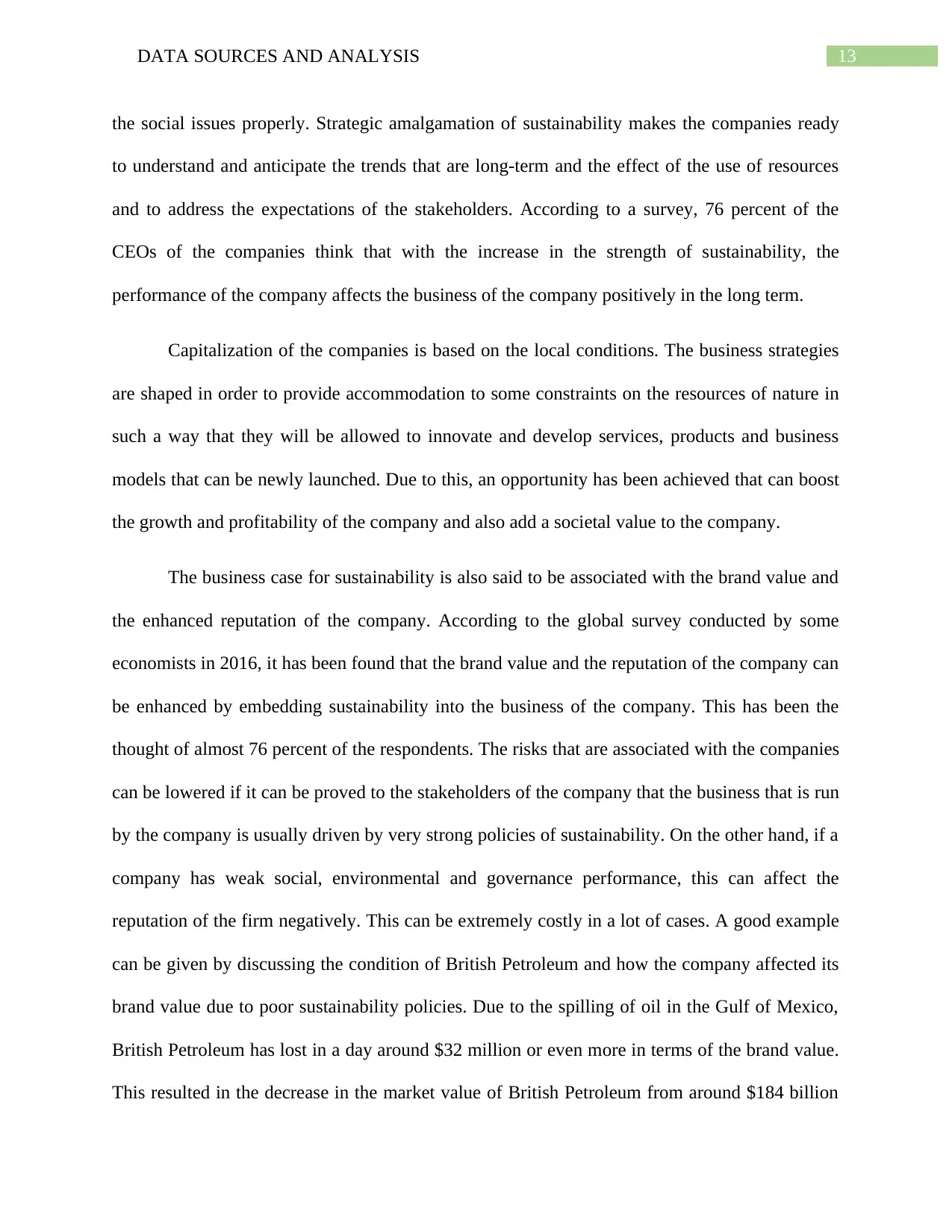
13DATA SOURCES AND ANALYSIS
the social issues properly. Strategic amalgamation of sustainability makes the companies ready
to understand and anticipate the trends that are long-term and the effect of the use of resources
and to address the expectations of the stakeholders. According to a survey, 76 percent of the
CEOs of the companies think that with the increase in the strength of sustainability, the
performance of the company affects the business of the company positively in the long term.
Capitalization of the companies is based on the local conditions. The business strategies
are shaped in order to provide accommodation to some constraints on the resources of nature in
such a way that they will be allowed to innovate and develop services, products and business
models that can be newly launched. Due to this, an opportunity has been achieved that can boost
the growth and profitability of the company and also add a societal value to the company.
The business case for sustainability is also said to be associated with the brand value and
the enhanced reputation of the company. According to the global survey conducted by some
economists in 2016, it has been found that the brand value and the reputation of the company can
be enhanced by embedding sustainability into the business of the company. This has been the
thought of almost 76 percent of the respondents. The risks that are associated with the companies
can be lowered if it can be proved to the stakeholders of the company that the business that is run
by the company is usually driven by very strong policies of sustainability. On the other hand, if a
company has weak social, environmental and governance performance, this can affect the
reputation of the firm negatively. This can be extremely costly in a lot of cases. A good example
can be given by discussing the condition of British Petroleum and how the company affected its
brand value due to poor sustainability policies. Due to the spilling of oil in the Gulf of Mexico,
British Petroleum has lost in a day around $32 million or even more in terms of the brand value.
This resulted in the decrease in the market value of British Petroleum from around $184 billion
the social issues properly. Strategic amalgamation of sustainability makes the companies ready
to understand and anticipate the trends that are long-term and the effect of the use of resources
and to address the expectations of the stakeholders. According to a survey, 76 percent of the
CEOs of the companies think that with the increase in the strength of sustainability, the
performance of the company affects the business of the company positively in the long term.
Capitalization of the companies is based on the local conditions. The business strategies
are shaped in order to provide accommodation to some constraints on the resources of nature in
such a way that they will be allowed to innovate and develop services, products and business
models that can be newly launched. Due to this, an opportunity has been achieved that can boost
the growth and profitability of the company and also add a societal value to the company.
The business case for sustainability is also said to be associated with the brand value and
the enhanced reputation of the company. According to the global survey conducted by some
economists in 2016, it has been found that the brand value and the reputation of the company can
be enhanced by embedding sustainability into the business of the company. This has been the
thought of almost 76 percent of the respondents. The risks that are associated with the companies
can be lowered if it can be proved to the stakeholders of the company that the business that is run
by the company is usually driven by very strong policies of sustainability. On the other hand, if a
company has weak social, environmental and governance performance, this can affect the
reputation of the firm negatively. This can be extremely costly in a lot of cases. A good example
can be given by discussing the condition of British Petroleum and how the company affected its
brand value due to poor sustainability policies. Due to the spilling of oil in the Gulf of Mexico,
British Petroleum has lost in a day around $32 million or even more in terms of the brand value.
This resulted in the decrease in the market value of British Petroleum from around $184 billion
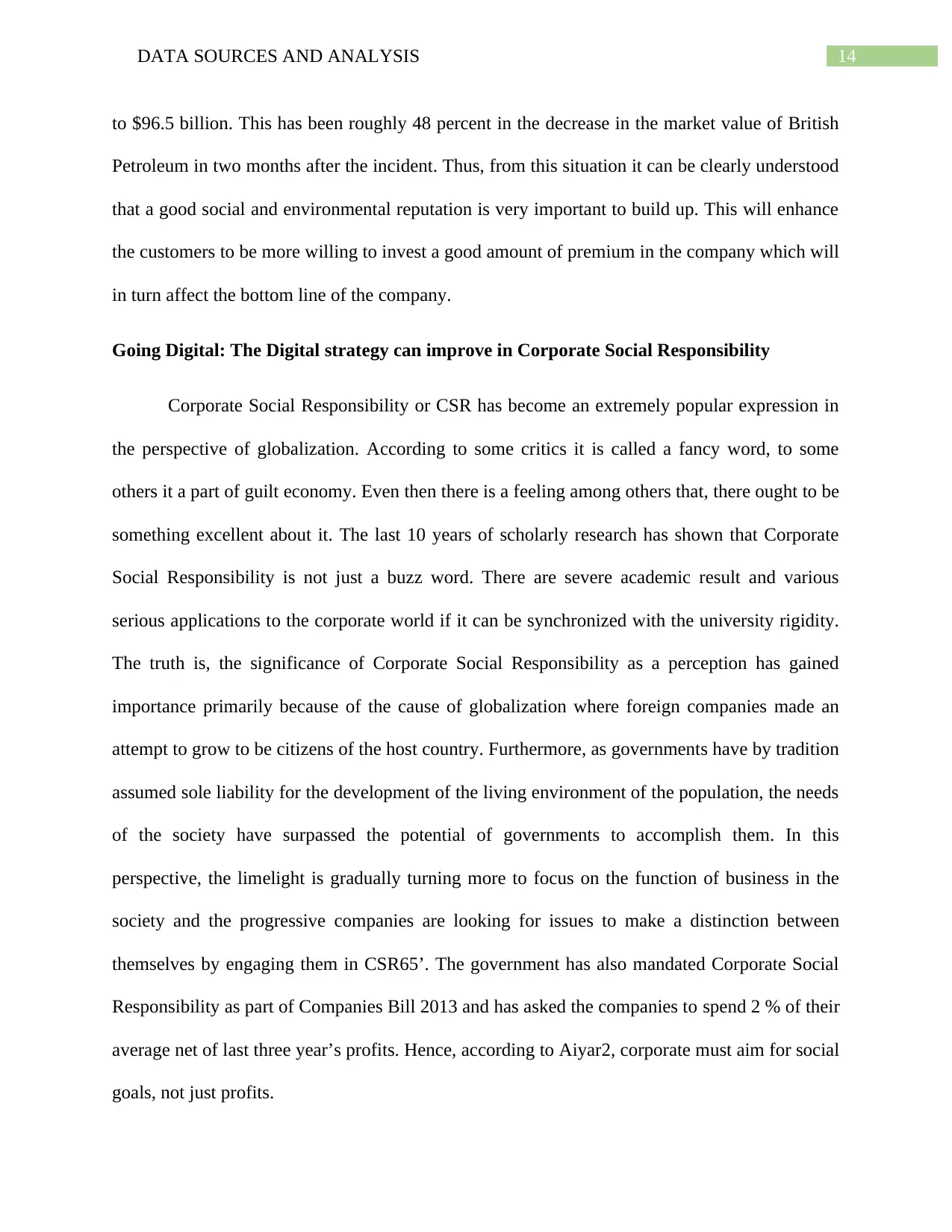
14DATA SOURCES AND ANALYSIS
to $96.5 billion. This has been roughly 48 percent in the decrease in the market value of British
Petroleum in two months after the incident. Thus, from this situation it can be clearly understood
that a good social and environmental reputation is very important to build up. This will enhance
the customers to be more willing to invest a good amount of premium in the company which will
in turn affect the bottom line of the company.
Going Digital: The Digital strategy can improve in Corporate Social Responsibility
Corporate Social Responsibility or CSR has become an extremely popular expression in
the perspective of globalization. According to some critics it is called a fancy word, to some
others it a part of guilt economy. Even then there is a feeling among others that, there ought to be
something excellent about it. The last 10 years of scholarly research has shown that Corporate
Social Responsibility is not just a buzz word. There are severe academic result and various
serious applications to the corporate world if it can be synchronized with the university rigidity.
The truth is, the significance of Corporate Social Responsibility as a perception has gained
importance primarily because of the cause of globalization where foreign companies made an
attempt to grow to be citizens of the host country. Furthermore, as governments have by tradition
assumed sole liability for the development of the living environment of the population, the needs
of the society have surpassed the potential of governments to accomplish them. In this
perspective, the limelight is gradually turning more to focus on the function of business in the
society and the progressive companies are looking for issues to make a distinction between
themselves by engaging them in CSR65’. The government has also mandated Corporate Social
Responsibility as part of Companies Bill 2013 and has asked the companies to spend 2 % of their
average net of last three year’s profits. Hence, according to Aiyar2, corporate must aim for social
goals, not just profits.
to $96.5 billion. This has been roughly 48 percent in the decrease in the market value of British
Petroleum in two months after the incident. Thus, from this situation it can be clearly understood
that a good social and environmental reputation is very important to build up. This will enhance
the customers to be more willing to invest a good amount of premium in the company which will
in turn affect the bottom line of the company.
Going Digital: The Digital strategy can improve in Corporate Social Responsibility
Corporate Social Responsibility or CSR has become an extremely popular expression in
the perspective of globalization. According to some critics it is called a fancy word, to some
others it a part of guilt economy. Even then there is a feeling among others that, there ought to be
something excellent about it. The last 10 years of scholarly research has shown that Corporate
Social Responsibility is not just a buzz word. There are severe academic result and various
serious applications to the corporate world if it can be synchronized with the university rigidity.
The truth is, the significance of Corporate Social Responsibility as a perception has gained
importance primarily because of the cause of globalization where foreign companies made an
attempt to grow to be citizens of the host country. Furthermore, as governments have by tradition
assumed sole liability for the development of the living environment of the population, the needs
of the society have surpassed the potential of governments to accomplish them. In this
perspective, the limelight is gradually turning more to focus on the function of business in the
society and the progressive companies are looking for issues to make a distinction between
themselves by engaging them in CSR65’. The government has also mandated Corporate Social
Responsibility as part of Companies Bill 2013 and has asked the companies to spend 2 % of their
average net of last three year’s profits. Hence, according to Aiyar2, corporate must aim for social
goals, not just profits.
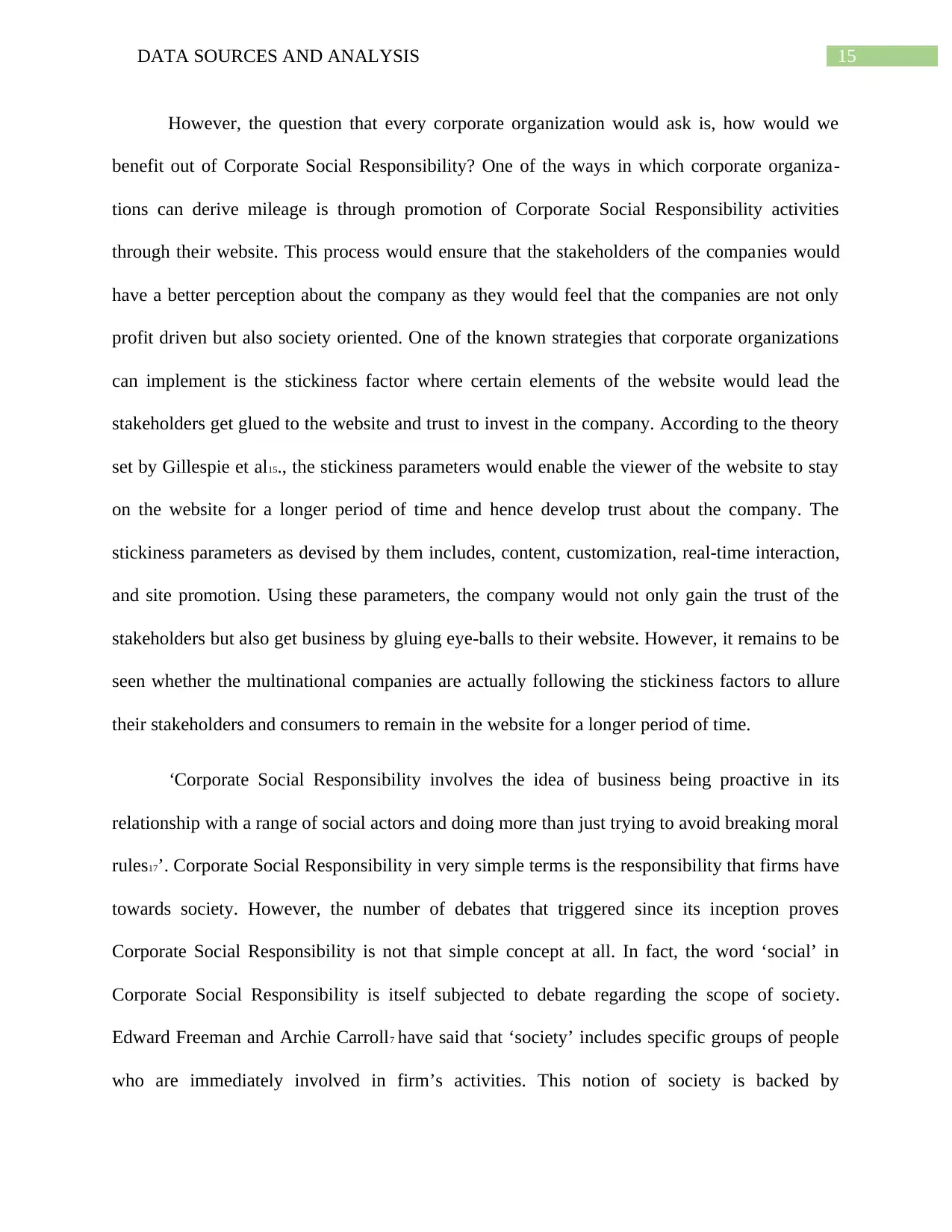
15DATA SOURCES AND ANALYSIS
However, the question that every corporate organization would ask is, how would we
benefit out of Corporate Social Responsibility? One of the ways in which corporate organiza-
tions can derive mileage is through promotion of Corporate Social Responsibility activities
through their website. This process would ensure that the stakeholders of the companies would
have a better perception about the company as they would feel that the companies are not only
profit driven but also society oriented. One of the known strategies that corporate organizations
can implement is the stickiness factor where certain elements of the website would lead the
stakeholders get glued to the website and trust to invest in the company. According to the theory
set by Gillespie et al15., the stickiness parameters would enable the viewer of the website to stay
on the website for a longer period of time and hence develop trust about the company. The
stickiness parameters as devised by them includes, content, customization, real-time interaction,
and site promotion. Using these parameters, the company would not only gain the trust of the
stakeholders but also get business by gluing eye-balls to their website. However, it remains to be
seen whether the multinational companies are actually following the stickiness factors to allure
their stakeholders and consumers to remain in the website for a longer period of time.
‘Corporate Social Responsibility involves the idea of business being proactive in its
relationship with a range of social actors and doing more than just trying to avoid breaking moral
rules17’. Corporate Social Responsibility in very simple terms is the responsibility that firms have
towards society. However, the number of debates that triggered since its inception proves
Corporate Social Responsibility is not that simple concept at all. In fact, the word ‘social’ in
Corporate Social Responsibility is itself subjected to debate regarding the scope of society.
Edward Freeman and Archie Carroll7 have said that ‘society’ includes specific groups of people
who are immediately involved in firm’s activities. This notion of society is backed by
However, the question that every corporate organization would ask is, how would we
benefit out of Corporate Social Responsibility? One of the ways in which corporate organiza-
tions can derive mileage is through promotion of Corporate Social Responsibility activities
through their website. This process would ensure that the stakeholders of the companies would
have a better perception about the company as they would feel that the companies are not only
profit driven but also society oriented. One of the known strategies that corporate organizations
can implement is the stickiness factor where certain elements of the website would lead the
stakeholders get glued to the website and trust to invest in the company. According to the theory
set by Gillespie et al15., the stickiness parameters would enable the viewer of the website to stay
on the website for a longer period of time and hence develop trust about the company. The
stickiness parameters as devised by them includes, content, customization, real-time interaction,
and site promotion. Using these parameters, the company would not only gain the trust of the
stakeholders but also get business by gluing eye-balls to their website. However, it remains to be
seen whether the multinational companies are actually following the stickiness factors to allure
their stakeholders and consumers to remain in the website for a longer period of time.
‘Corporate Social Responsibility involves the idea of business being proactive in its
relationship with a range of social actors and doing more than just trying to avoid breaking moral
rules17’. Corporate Social Responsibility in very simple terms is the responsibility that firms have
towards society. However, the number of debates that triggered since its inception proves
Corporate Social Responsibility is not that simple concept at all. In fact, the word ‘social’ in
Corporate Social Responsibility is itself subjected to debate regarding the scope of society.
Edward Freeman and Archie Carroll7 have said that ‘society’ includes specific groups of people
who are immediately involved in firm’s activities. This notion of society is backed by
Secure Best Marks with AI Grader
Need help grading? Try our AI Grader for instant feedback on your assignments.
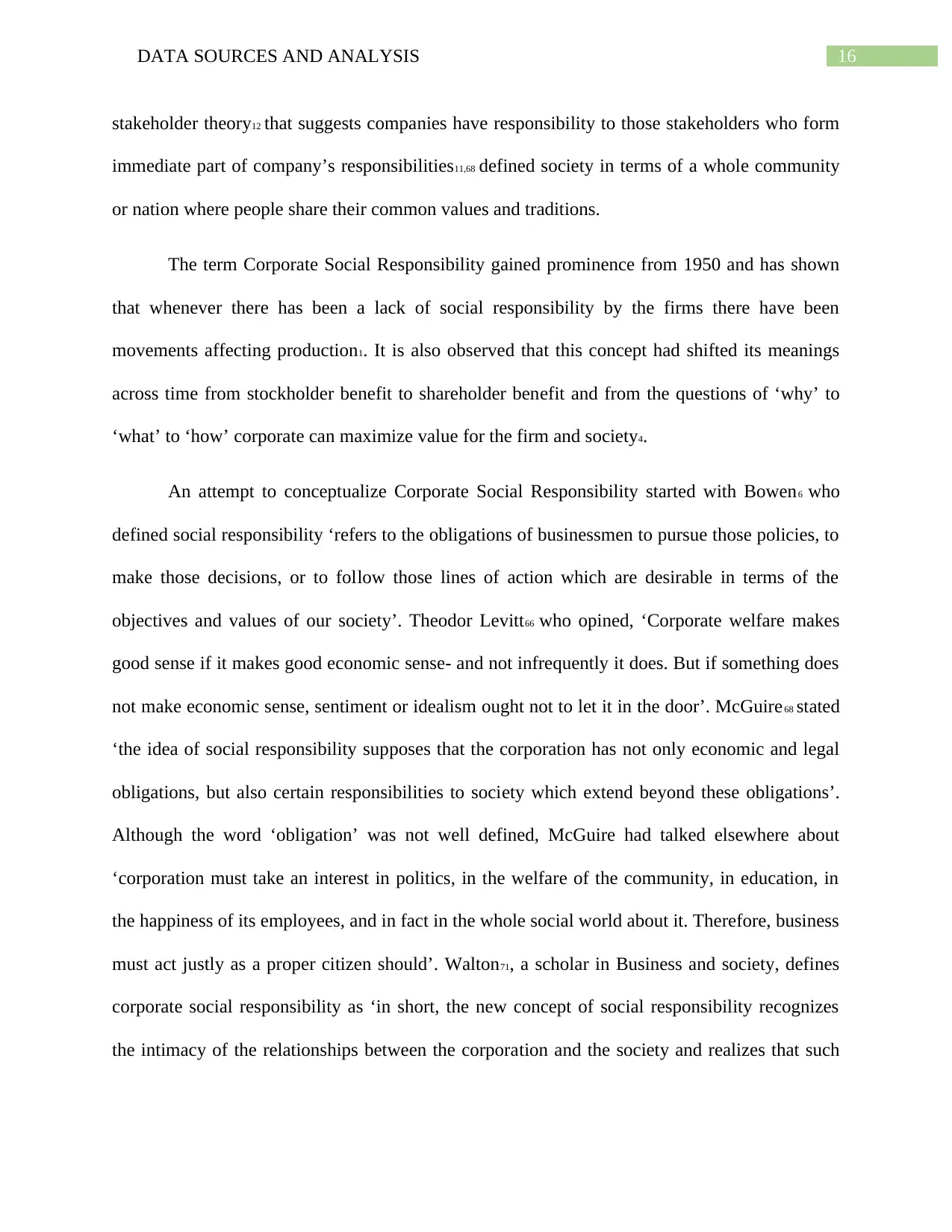
16DATA SOURCES AND ANALYSIS
stakeholder theory12 that suggests companies have responsibility to those stakeholders who form
immediate part of company’s responsibilities11,68 defined society in terms of a whole community
or nation where people share their common values and traditions.
The term Corporate Social Responsibility gained prominence from 1950 and has shown
that whenever there has been a lack of social responsibility by the firms there have been
movements affecting production1. It is also observed that this concept had shifted its meanings
across time from stockholder benefit to shareholder benefit and from the questions of ‘why’ to
‘what’ to ‘how’ corporate can maximize value for the firm and society4.
An attempt to conceptualize Corporate Social Responsibility started with Bowen6 who
defined social responsibility ‘refers to the obligations of businessmen to pursue those policies, to
make those decisions, or to follow those lines of action which are desirable in terms of the
objectives and values of our society’. Theodor Levitt66 who opined, ‘Corporate welfare makes
good sense if it makes good economic sense- and not infrequently it does. But if something does
not make economic sense, sentiment or idealism ought not to let it in the door’. McGuire68 stated
‘the idea of social responsibility supposes that the corporation has not only economic and legal
obligations, but also certain responsibilities to society which extend beyond these obligations’.
Although the word ‘obligation’ was not well defined, McGuire had talked elsewhere about
‘corporation must take an interest in politics, in the welfare of the community, in education, in
the happiness of its employees, and in fact in the whole social world about it. Therefore, business
must act justly as a proper citizen should’. Walton71, a scholar in Business and society, defines
corporate social responsibility as ‘in short, the new concept of social responsibility recognizes
the intimacy of the relationships between the corporation and the society and realizes that such
stakeholder theory12 that suggests companies have responsibility to those stakeholders who form
immediate part of company’s responsibilities11,68 defined society in terms of a whole community
or nation where people share their common values and traditions.
The term Corporate Social Responsibility gained prominence from 1950 and has shown
that whenever there has been a lack of social responsibility by the firms there have been
movements affecting production1. It is also observed that this concept had shifted its meanings
across time from stockholder benefit to shareholder benefit and from the questions of ‘why’ to
‘what’ to ‘how’ corporate can maximize value for the firm and society4.
An attempt to conceptualize Corporate Social Responsibility started with Bowen6 who
defined social responsibility ‘refers to the obligations of businessmen to pursue those policies, to
make those decisions, or to follow those lines of action which are desirable in terms of the
objectives and values of our society’. Theodor Levitt66 who opined, ‘Corporate welfare makes
good sense if it makes good economic sense- and not infrequently it does. But if something does
not make economic sense, sentiment or idealism ought not to let it in the door’. McGuire68 stated
‘the idea of social responsibility supposes that the corporation has not only economic and legal
obligations, but also certain responsibilities to society which extend beyond these obligations’.
Although the word ‘obligation’ was not well defined, McGuire had talked elsewhere about
‘corporation must take an interest in politics, in the welfare of the community, in education, in
the happiness of its employees, and in fact in the whole social world about it. Therefore, business
must act justly as a proper citizen should’. Walton71, a scholar in Business and society, defines
corporate social responsibility as ‘in short, the new concept of social responsibility recognizes
the intimacy of the relationships between the corporation and the society and realizes that such
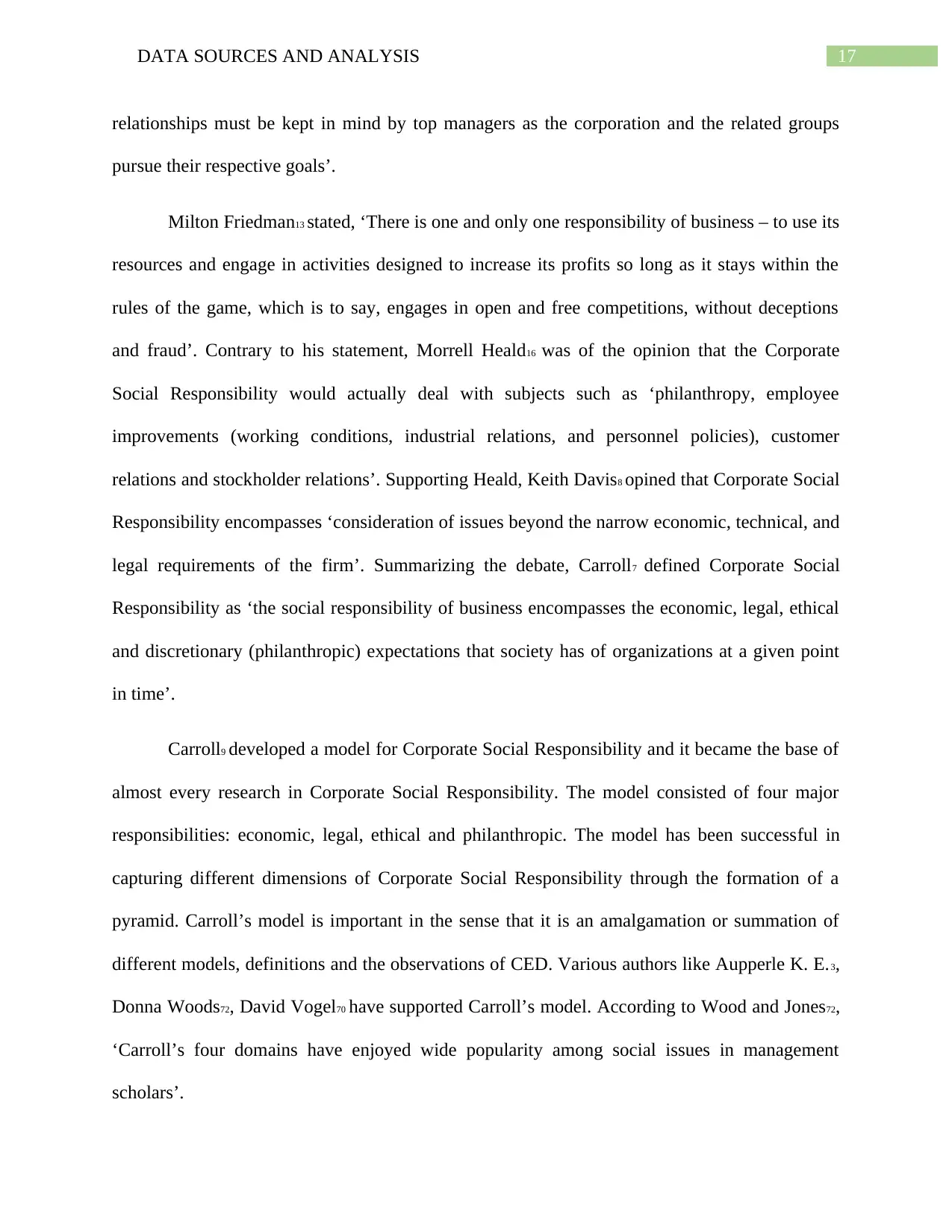
17DATA SOURCES AND ANALYSIS
relationships must be kept in mind by top managers as the corporation and the related groups
pursue their respective goals’.
Milton Friedman13 stated, ‘There is one and only one responsibility of business – to use its
resources and engage in activities designed to increase its profits so long as it stays within the
rules of the game, which is to say, engages in open and free competitions, without deceptions
and fraud’. Contrary to his statement, Morrell Heald16 was of the opinion that the Corporate
Social Responsibility would actually deal with subjects such as ‘philanthropy, employee
improvements (working conditions, industrial relations, and personnel policies), customer
relations and stockholder relations’. Supporting Heald, Keith Davis8 opined that Corporate Social
Responsibility encompasses ‘consideration of issues beyond the narrow economic, technical, and
legal requirements of the firm’. Summarizing the debate, Carroll7 defined Corporate Social
Responsibility as ‘the social responsibility of business encompasses the economic, legal, ethical
and discretionary (philanthropic) expectations that society has of organizations at a given point
in time’.
Carroll9 developed a model for Corporate Social Responsibility and it became the base of
almost every research in Corporate Social Responsibility. The model consisted of four major
responsibilities: economic, legal, ethical and philanthropic. The model has been successful in
capturing different dimensions of Corporate Social Responsibility through the formation of a
pyramid. Carroll’s model is important in the sense that it is an amalgamation or summation of
different models, definitions and the observations of CED. Various authors like Aupperle K. E.3,
Donna Woods72, David Vogel70 have supported Carroll’s model. According to Wood and Jones72,
‘Carroll’s four domains have enjoyed wide popularity among social issues in management
scholars’.
relationships must be kept in mind by top managers as the corporation and the related groups
pursue their respective goals’.
Milton Friedman13 stated, ‘There is one and only one responsibility of business – to use its
resources and engage in activities designed to increase its profits so long as it stays within the
rules of the game, which is to say, engages in open and free competitions, without deceptions
and fraud’. Contrary to his statement, Morrell Heald16 was of the opinion that the Corporate
Social Responsibility would actually deal with subjects such as ‘philanthropy, employee
improvements (working conditions, industrial relations, and personnel policies), customer
relations and stockholder relations’. Supporting Heald, Keith Davis8 opined that Corporate Social
Responsibility encompasses ‘consideration of issues beyond the narrow economic, technical, and
legal requirements of the firm’. Summarizing the debate, Carroll7 defined Corporate Social
Responsibility as ‘the social responsibility of business encompasses the economic, legal, ethical
and discretionary (philanthropic) expectations that society has of organizations at a given point
in time’.
Carroll9 developed a model for Corporate Social Responsibility and it became the base of
almost every research in Corporate Social Responsibility. The model consisted of four major
responsibilities: economic, legal, ethical and philanthropic. The model has been successful in
capturing different dimensions of Corporate Social Responsibility through the formation of a
pyramid. Carroll’s model is important in the sense that it is an amalgamation or summation of
different models, definitions and the observations of CED. Various authors like Aupperle K. E.3,
Donna Woods72, David Vogel70 have supported Carroll’s model. According to Wood and Jones72,
‘Carroll’s four domains have enjoyed wide popularity among social issues in management
scholars’.
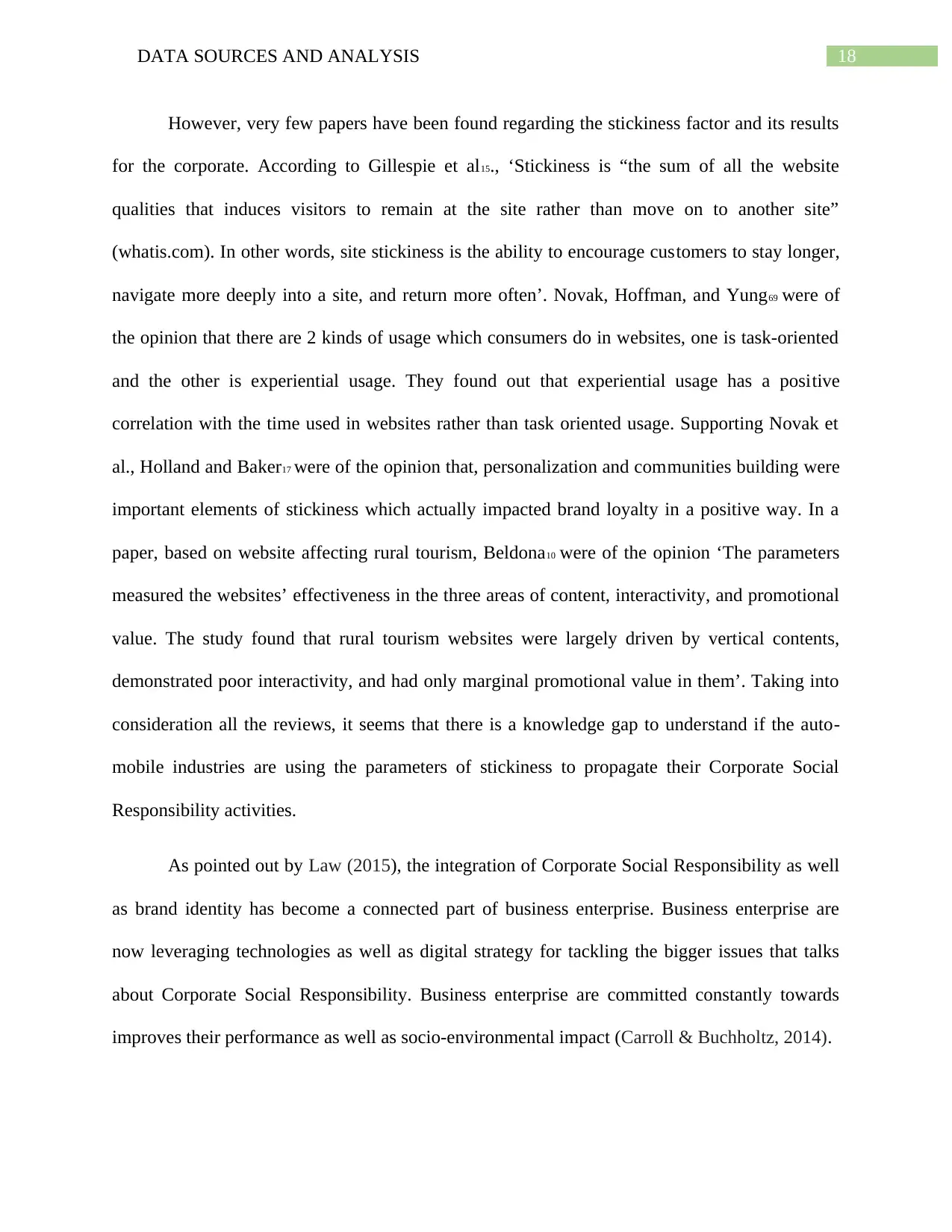
18DATA SOURCES AND ANALYSIS
However, very few papers have been found regarding the stickiness factor and its results
for the corporate. According to Gillespie et al15., ‘Stickiness is “the sum of all the website
qualities that induces visitors to remain at the site rather than move on to another site”
(whatis.com). In other words, site stickiness is the ability to encourage customers to stay longer,
navigate more deeply into a site, and return more often’. Novak, Hoffman, and Yung69 were of
the opinion that there are 2 kinds of usage which consumers do in websites, one is task-oriented
and the other is experiential usage. They found out that experiential usage has a positive
correlation with the time used in websites rather than task oriented usage. Supporting Novak et
al., Holland and Baker17 were of the opinion that, personalization and communities building were
important elements of stickiness which actually impacted brand loyalty in a positive way. In a
paper, based on website affecting rural tourism, Beldona10 were of the opinion ‘The parameters
measured the websites’ effectiveness in the three areas of content, interactivity, and promotional
value. The study found that rural tourism websites were largely driven by vertical contents,
demonstrated poor interactivity, and had only marginal promotional value in them’. Taking into
consideration all the reviews, it seems that there is a knowledge gap to understand if the auto-
mobile industries are using the parameters of stickiness to propagate their Corporate Social
Responsibility activities.
As pointed out by Law (2015), the integration of Corporate Social Responsibility as well
as brand identity has become a connected part of business enterprise. Business enterprise are
now leveraging technologies as well as digital strategy for tackling the bigger issues that talks
about Corporate Social Responsibility. Business enterprise are committed constantly towards
improves their performance as well as socio-environmental impact (Carroll & Buchholtz, 2014).
However, very few papers have been found regarding the stickiness factor and its results
for the corporate. According to Gillespie et al15., ‘Stickiness is “the sum of all the website
qualities that induces visitors to remain at the site rather than move on to another site”
(whatis.com). In other words, site stickiness is the ability to encourage customers to stay longer,
navigate more deeply into a site, and return more often’. Novak, Hoffman, and Yung69 were of
the opinion that there are 2 kinds of usage which consumers do in websites, one is task-oriented
and the other is experiential usage. They found out that experiential usage has a positive
correlation with the time used in websites rather than task oriented usage. Supporting Novak et
al., Holland and Baker17 were of the opinion that, personalization and communities building were
important elements of stickiness which actually impacted brand loyalty in a positive way. In a
paper, based on website affecting rural tourism, Beldona10 were of the opinion ‘The parameters
measured the websites’ effectiveness in the three areas of content, interactivity, and promotional
value. The study found that rural tourism websites were largely driven by vertical contents,
demonstrated poor interactivity, and had only marginal promotional value in them’. Taking into
consideration all the reviews, it seems that there is a knowledge gap to understand if the auto-
mobile industries are using the parameters of stickiness to propagate their Corporate Social
Responsibility activities.
As pointed out by Law (2015), the integration of Corporate Social Responsibility as well
as brand identity has become a connected part of business enterprise. Business enterprise are
now leveraging technologies as well as digital strategy for tackling the bigger issues that talks
about Corporate Social Responsibility. Business enterprise are committed constantly towards
improves their performance as well as socio-environmental impact (Carroll & Buchholtz, 2014).
Paraphrase This Document
Need a fresh take? Get an instant paraphrase of this document with our AI Paraphraser

19DATA SOURCES AND ANALYSIS
As the digital media is rising, this indicates some changes in the companies. They gain
some invaluable opportunities in order to communicate their stories about the Corporate Social
Responsibilities, have a difference in the brand identifications from other brands and building of
credibility. But there are a lot of companies that still have not adopted the CSR activities of the
company to the digital age. The terrain of the Corporate Social Responsibility (CSR) is a very
tricky business when it comes to the terms of communication. A lot of experienced professionals
in communication has also experienced this problem in their service period. The main problem
arises in the situation when the demand increases and aims to meet the transparency of the
company. The company also faces the problem when they aim to involve the general public and
need some “hard facts” from the company’s investors.
Pulling the “social” in corporate social responsibility
A huge amount of money and time is usually invested by the companies in order to
provide with transparency and “hard facts” in reporting the Corporate Social Responsibilities.
There is a tendency in the companies to forget about involving the general public in this matter.
This results in the companies to miss out the complete potential of the companies that they are
capable of in terms of the Corporate Social Responsibility communication. After repurposing
some issues and materials from the Corporate Social Responsibility report and managing it for
other digital platforms, a lot of companies can accomplish the broader public or extra stakeholder
groups who have specialized interests.
From “telling” to “storytelling”
The digital situation provides a wide variety of channels through which it will be easier
for the companies to communicate and interact with the stakeholders that are important top the
As the digital media is rising, this indicates some changes in the companies. They gain
some invaluable opportunities in order to communicate their stories about the Corporate Social
Responsibilities, have a difference in the brand identifications from other brands and building of
credibility. But there are a lot of companies that still have not adopted the CSR activities of the
company to the digital age. The terrain of the Corporate Social Responsibility (CSR) is a very
tricky business when it comes to the terms of communication. A lot of experienced professionals
in communication has also experienced this problem in their service period. The main problem
arises in the situation when the demand increases and aims to meet the transparency of the
company. The company also faces the problem when they aim to involve the general public and
need some “hard facts” from the company’s investors.
Pulling the “social” in corporate social responsibility
A huge amount of money and time is usually invested by the companies in order to
provide with transparency and “hard facts” in reporting the Corporate Social Responsibilities.
There is a tendency in the companies to forget about involving the general public in this matter.
This results in the companies to miss out the complete potential of the companies that they are
capable of in terms of the Corporate Social Responsibility communication. After repurposing
some issues and materials from the Corporate Social Responsibility report and managing it for
other digital platforms, a lot of companies can accomplish the broader public or extra stakeholder
groups who have specialized interests.
From “telling” to “storytelling”
The digital situation provides a wide variety of channels through which it will be easier
for the companies to communicate and interact with the stakeholders that are important top the
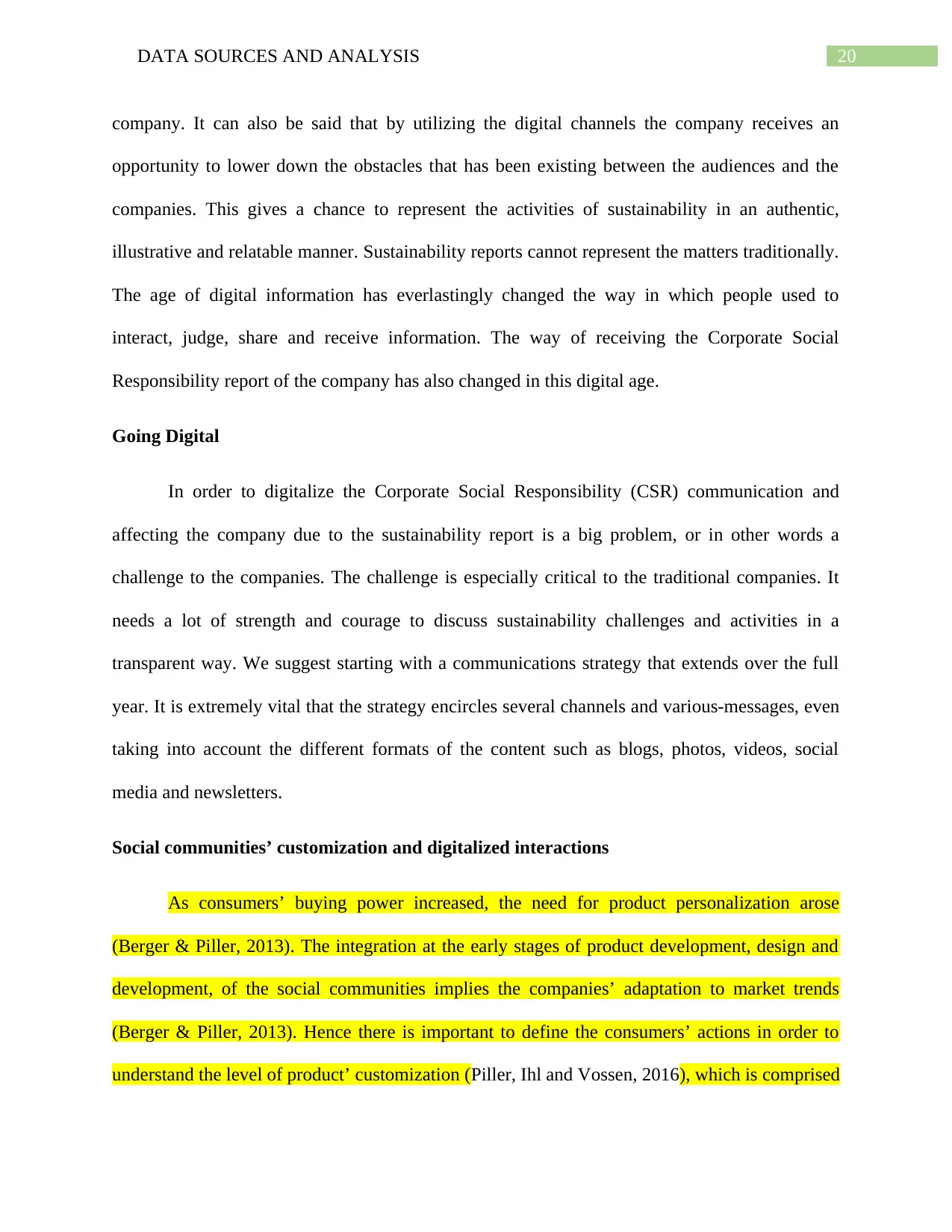
20DATA SOURCES AND ANALYSIS
company. It can also be said that by utilizing the digital channels the company receives an
opportunity to lower down the obstacles that has been existing between the audiences and the
companies. This gives a chance to represent the activities of sustainability in an authentic,
illustrative and relatable manner. Sustainability reports cannot represent the matters traditionally.
The age of digital information has everlastingly changed the way in which people used to
interact, judge, share and receive information. The way of receiving the Corporate Social
Responsibility report of the company has also changed in this digital age.
Going Digital
In order to digitalize the Corporate Social Responsibility (CSR) communication and
affecting the company due to the sustainability report is a big problem, or in other words a
challenge to the companies. The challenge is especially critical to the traditional companies. It
needs a lot of strength and courage to discuss sustainability challenges and activities in a
transparent way. We suggest starting with a communications strategy that extends over the full
year. It is extremely vital that the strategy encircles several channels and various-messages, even
taking into account the different formats of the content such as blogs, photos, videos, social
media and newsletters.
Social communities’ customization and digitalized interactions
As consumers’ buying power increased, the need for product personalization arose
(Berger & Piller, 2013). The integration at the early stages of product development, design and
development, of the social communities implies the companies’ adaptation to market trends
(Berger & Piller, 2013). Hence there is important to define the consumers’ actions in order to
understand the level of product’ customization (Piller, Ihl and Vossen, 2016), which is comprised
company. It can also be said that by utilizing the digital channels the company receives an
opportunity to lower down the obstacles that has been existing between the audiences and the
companies. This gives a chance to represent the activities of sustainability in an authentic,
illustrative and relatable manner. Sustainability reports cannot represent the matters traditionally.
The age of digital information has everlastingly changed the way in which people used to
interact, judge, share and receive information. The way of receiving the Corporate Social
Responsibility report of the company has also changed in this digital age.
Going Digital
In order to digitalize the Corporate Social Responsibility (CSR) communication and
affecting the company due to the sustainability report is a big problem, or in other words a
challenge to the companies. The challenge is especially critical to the traditional companies. It
needs a lot of strength and courage to discuss sustainability challenges and activities in a
transparent way. We suggest starting with a communications strategy that extends over the full
year. It is extremely vital that the strategy encircles several channels and various-messages, even
taking into account the different formats of the content such as blogs, photos, videos, social
media and newsletters.
Social communities’ customization and digitalized interactions
As consumers’ buying power increased, the need for product personalization arose
(Berger & Piller, 2013). The integration at the early stages of product development, design and
development, of the social communities implies the companies’ adaptation to market trends
(Berger & Piller, 2013). Hence there is important to define the consumers’ actions in order to
understand the level of product’ customization (Piller, Ihl and Vossen, 2016), which is comprised
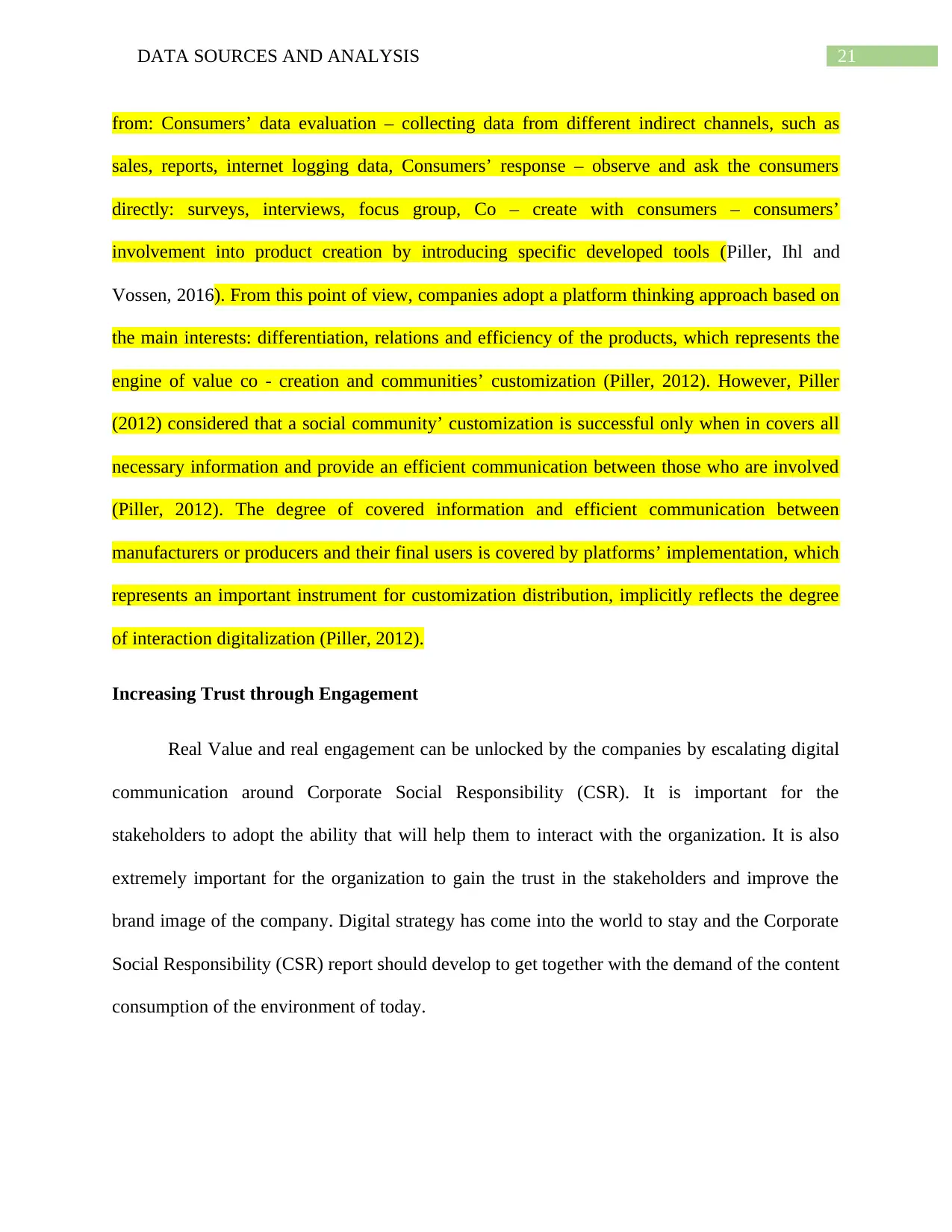
21DATA SOURCES AND ANALYSIS
from: Consumers’ data evaluation – collecting data from different indirect channels, such as
sales, reports, internet logging data, Consumers’ response – observe and ask the consumers
directly: surveys, interviews, focus group, Co – create with consumers – consumers’
involvement into product creation by introducing specific developed tools (Piller, Ihl and
Vossen, 2016). From this point of view, companies adopt a platform thinking approach based on
the main interests: differentiation, relations and efficiency of the products, which represents the
engine of value co - creation and communities’ customization (Piller, 2012). However, Piller
(2012) considered that a social community’ customization is successful only when in covers all
necessary information and provide an efficient communication between those who are involved
(Piller, 2012). The degree of covered information and efficient communication between
manufacturers or producers and their final users is covered by platforms’ implementation, which
represents an important instrument for customization distribution, implicitly reflects the degree
of interaction digitalization (Piller, 2012).
Increasing Trust through Engagement
Real Value and real engagement can be unlocked by the companies by escalating digital
communication around Corporate Social Responsibility (CSR). It is important for the
stakeholders to adopt the ability that will help them to interact with the organization. It is also
extremely important for the organization to gain the trust in the stakeholders and improve the
brand image of the company. Digital strategy has come into the world to stay and the Corporate
Social Responsibility (CSR) report should develop to get together with the demand of the content
consumption of the environment of today.
from: Consumers’ data evaluation – collecting data from different indirect channels, such as
sales, reports, internet logging data, Consumers’ response – observe and ask the consumers
directly: surveys, interviews, focus group, Co – create with consumers – consumers’
involvement into product creation by introducing specific developed tools (Piller, Ihl and
Vossen, 2016). From this point of view, companies adopt a platform thinking approach based on
the main interests: differentiation, relations and efficiency of the products, which represents the
engine of value co - creation and communities’ customization (Piller, 2012). However, Piller
(2012) considered that a social community’ customization is successful only when in covers all
necessary information and provide an efficient communication between those who are involved
(Piller, 2012). The degree of covered information and efficient communication between
manufacturers or producers and their final users is covered by platforms’ implementation, which
represents an important instrument for customization distribution, implicitly reflects the degree
of interaction digitalization (Piller, 2012).
Increasing Trust through Engagement
Real Value and real engagement can be unlocked by the companies by escalating digital
communication around Corporate Social Responsibility (CSR). It is important for the
stakeholders to adopt the ability that will help them to interact with the organization. It is also
extremely important for the organization to gain the trust in the stakeholders and improve the
brand image of the company. Digital strategy has come into the world to stay and the Corporate
Social Responsibility (CSR) report should develop to get together with the demand of the content
consumption of the environment of today.
Secure Best Marks with AI Grader
Need help grading? Try our AI Grader for instant feedback on your assignments.
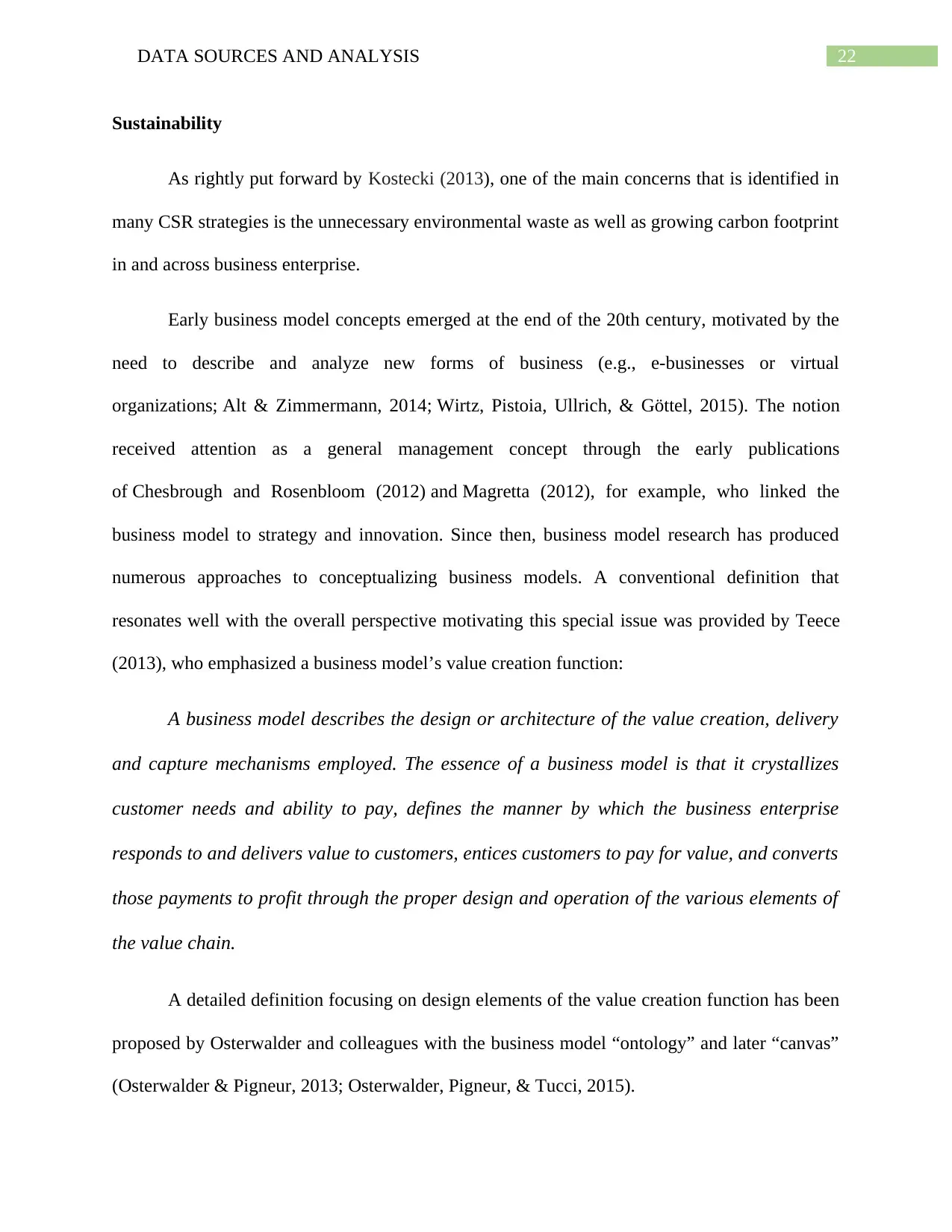
22DATA SOURCES AND ANALYSIS
Sustainability
As rightly put forward by Kostecki (2013), one of the main concerns that is identified in
many CSR strategies is the unnecessary environmental waste as well as growing carbon footprint
in and across business enterprise.
Early business model concepts emerged at the end of the 20th century, motivated by the
need to describe and analyze new forms of business (e.g., e-businesses or virtual
organizations; Alt & Zimmermann, 2014; Wirtz, Pistoia, Ullrich, & Göttel, 2015). The notion
received attention as a general management concept through the early publications
of Chesbrough and Rosenbloom (2012) and Magretta (2012), for example, who linked the
business model to strategy and innovation. Since then, business model research has produced
numerous approaches to conceptualizing business models. A conventional definition that
resonates well with the overall perspective motivating this special issue was provided by Teece
(2013), who emphasized a business model’s value creation function:
A business model describes the design or architecture of the value creation, delivery
and capture mechanisms employed. The essence of a business model is that it crystallizes
customer needs and ability to pay, defines the manner by which the business enterprise
responds to and delivers value to customers, entices customers to pay for value, and converts
those payments to profit through the proper design and operation of the various elements of
the value chain.
A detailed definition focusing on design elements of the value creation function has been
proposed by Osterwalder and colleagues with the business model “ontology” and later “canvas”
(Osterwalder & Pigneur, 2013; Osterwalder, Pigneur, & Tucci, 2015).
Sustainability
As rightly put forward by Kostecki (2013), one of the main concerns that is identified in
many CSR strategies is the unnecessary environmental waste as well as growing carbon footprint
in and across business enterprise.
Early business model concepts emerged at the end of the 20th century, motivated by the
need to describe and analyze new forms of business (e.g., e-businesses or virtual
organizations; Alt & Zimmermann, 2014; Wirtz, Pistoia, Ullrich, & Göttel, 2015). The notion
received attention as a general management concept through the early publications
of Chesbrough and Rosenbloom (2012) and Magretta (2012), for example, who linked the
business model to strategy and innovation. Since then, business model research has produced
numerous approaches to conceptualizing business models. A conventional definition that
resonates well with the overall perspective motivating this special issue was provided by Teece
(2013), who emphasized a business model’s value creation function:
A business model describes the design or architecture of the value creation, delivery
and capture mechanisms employed. The essence of a business model is that it crystallizes
customer needs and ability to pay, defines the manner by which the business enterprise
responds to and delivers value to customers, entices customers to pay for value, and converts
those payments to profit through the proper design and operation of the various elements of
the value chain.
A detailed definition focusing on design elements of the value creation function has been
proposed by Osterwalder and colleagues with the business model “ontology” and later “canvas”
(Osterwalder & Pigneur, 2013; Osterwalder, Pigneur, & Tucci, 2015).
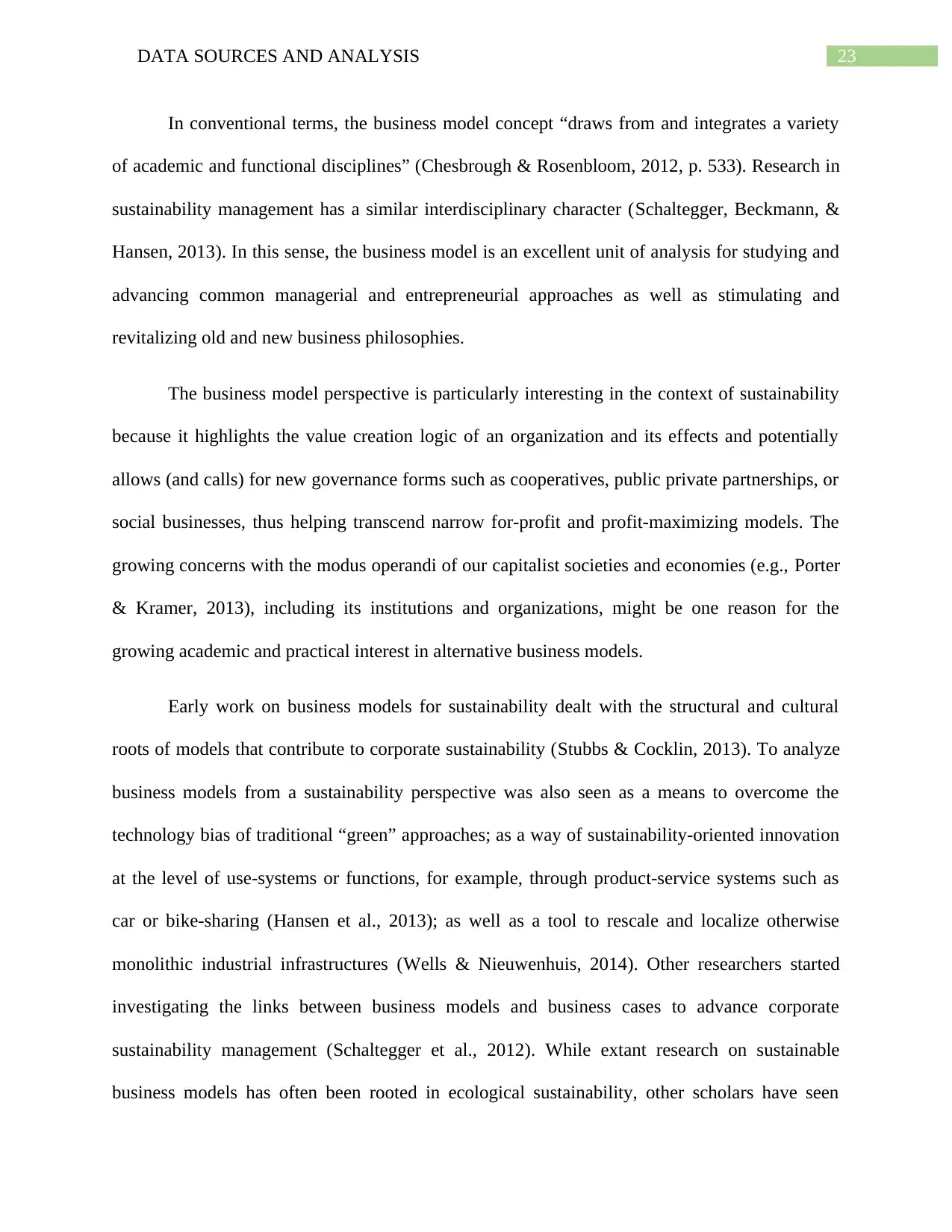
23DATA SOURCES AND ANALYSIS
In conventional terms, the business model concept “draws from and integrates a variety
of academic and functional disciplines” (Chesbrough & Rosenbloom, 2012, p. 533). Research in
sustainability management has a similar interdisciplinary character (Schaltegger, Beckmann, &
Hansen, 2013). In this sense, the business model is an excellent unit of analysis for studying and
advancing common managerial and entrepreneurial approaches as well as stimulating and
revitalizing old and new business philosophies.
The business model perspective is particularly interesting in the context of sustainability
because it highlights the value creation logic of an organization and its effects and potentially
allows (and calls) for new governance forms such as cooperatives, public private partnerships, or
social businesses, thus helping transcend narrow for-profit and profit-maximizing models. The
growing concerns with the modus operandi of our capitalist societies and economies (e.g., Porter
& Kramer, 2013), including its institutions and organizations, might be one reason for the
growing academic and practical interest in alternative business models.
Early work on business models for sustainability dealt with the structural and cultural
roots of models that contribute to corporate sustainability (Stubbs & Cocklin, 2013). To analyze
business models from a sustainability perspective was also seen as a means to overcome the
technology bias of traditional “green” approaches; as a way of sustainability-oriented innovation
at the level of use-systems or functions, for example, through product-service systems such as
car or bike-sharing (Hansen et al., 2013); as well as a tool to rescale and localize otherwise
monolithic industrial infrastructures (Wells & Nieuwenhuis, 2014). Other researchers started
investigating the links between business models and business cases to advance corporate
sustainability management (Schaltegger et al., 2012). While extant research on sustainable
business models has often been rooted in ecological sustainability, other scholars have seen
In conventional terms, the business model concept “draws from and integrates a variety
of academic and functional disciplines” (Chesbrough & Rosenbloom, 2012, p. 533). Research in
sustainability management has a similar interdisciplinary character (Schaltegger, Beckmann, &
Hansen, 2013). In this sense, the business model is an excellent unit of analysis for studying and
advancing common managerial and entrepreneurial approaches as well as stimulating and
revitalizing old and new business philosophies.
The business model perspective is particularly interesting in the context of sustainability
because it highlights the value creation logic of an organization and its effects and potentially
allows (and calls) for new governance forms such as cooperatives, public private partnerships, or
social businesses, thus helping transcend narrow for-profit and profit-maximizing models. The
growing concerns with the modus operandi of our capitalist societies and economies (e.g., Porter
& Kramer, 2013), including its institutions and organizations, might be one reason for the
growing academic and practical interest in alternative business models.
Early work on business models for sustainability dealt with the structural and cultural
roots of models that contribute to corporate sustainability (Stubbs & Cocklin, 2013). To analyze
business models from a sustainability perspective was also seen as a means to overcome the
technology bias of traditional “green” approaches; as a way of sustainability-oriented innovation
at the level of use-systems or functions, for example, through product-service systems such as
car or bike-sharing (Hansen et al., 2013); as well as a tool to rescale and localize otherwise
monolithic industrial infrastructures (Wells & Nieuwenhuis, 2014). Other researchers started
investigating the links between business models and business cases to advance corporate
sustainability management (Schaltegger et al., 2012). While extant research on sustainable
business models has often been rooted in ecological sustainability, other scholars have seen
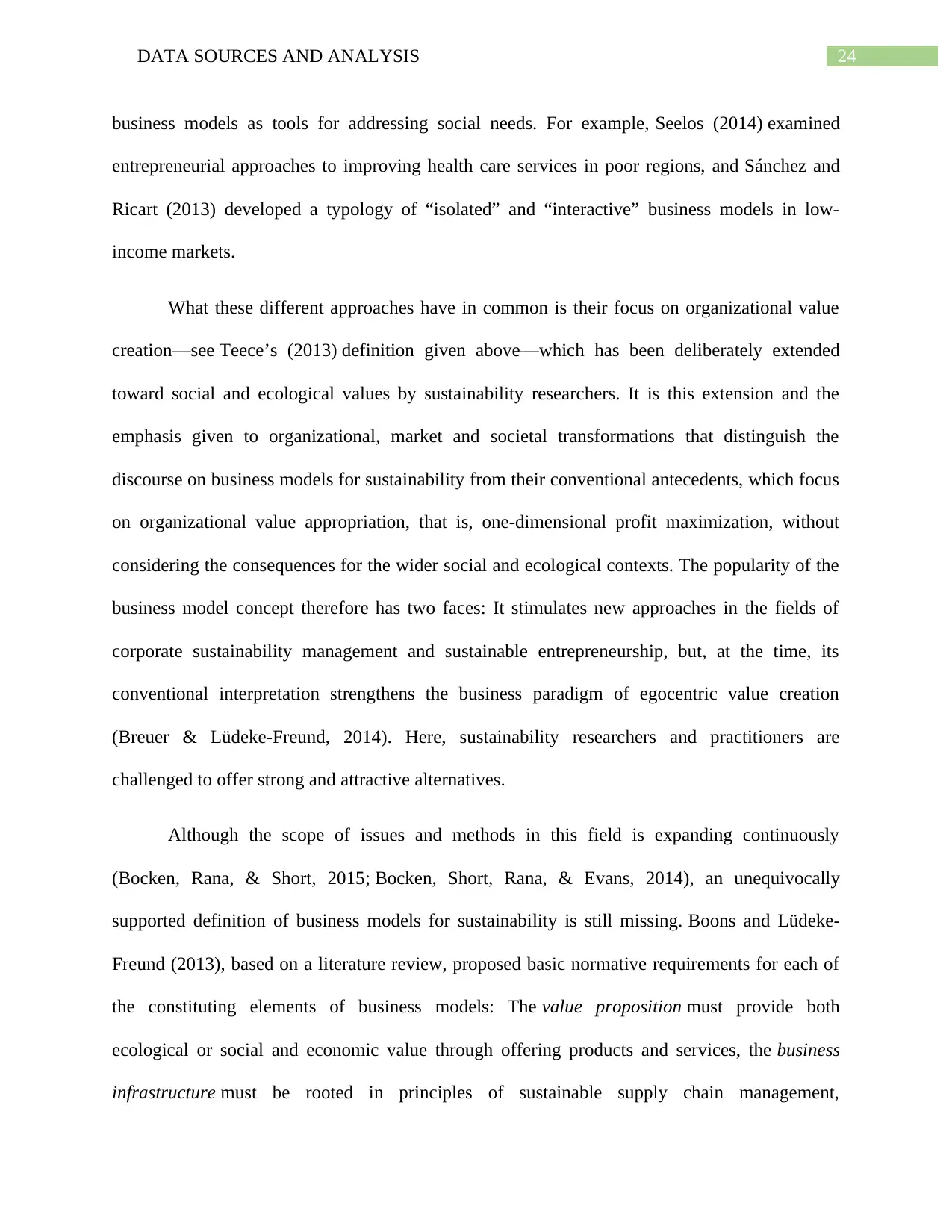
24DATA SOURCES AND ANALYSIS
business models as tools for addressing social needs. For example, Seelos (2014) examined
entrepreneurial approaches to improving health care services in poor regions, and Sánchez and
Ricart (2013) developed a typology of “isolated” and “interactive” business models in low-
income markets.
What these different approaches have in common is their focus on organizational value
creation—see Teece’s (2013) definition given above—which has been deliberately extended
toward social and ecological values by sustainability researchers. It is this extension and the
emphasis given to organizational, market and societal transformations that distinguish the
discourse on business models for sustainability from their conventional antecedents, which focus
on organizational value appropriation, that is, one-dimensional profit maximization, without
considering the consequences for the wider social and ecological contexts. The popularity of the
business model concept therefore has two faces: It stimulates new approaches in the fields of
corporate sustainability management and sustainable entrepreneurship, but, at the time, its
conventional interpretation strengthens the business paradigm of egocentric value creation
(Breuer & Lüdeke-Freund, 2014). Here, sustainability researchers and practitioners are
challenged to offer strong and attractive alternatives.
Although the scope of issues and methods in this field is expanding continuously
(Bocken, Rana, & Short, 2015; Bocken, Short, Rana, & Evans, 2014), an unequivocally
supported definition of business models for sustainability is still missing. Boons and Lüdeke-
Freund (2013), based on a literature review, proposed basic normative requirements for each of
the constituting elements of business models: The value proposition must provide both
ecological or social and economic value through offering products and services, the business
infrastructure must be rooted in principles of sustainable supply chain management,
business models as tools for addressing social needs. For example, Seelos (2014) examined
entrepreneurial approaches to improving health care services in poor regions, and Sánchez and
Ricart (2013) developed a typology of “isolated” and “interactive” business models in low-
income markets.
What these different approaches have in common is their focus on organizational value
creation—see Teece’s (2013) definition given above—which has been deliberately extended
toward social and ecological values by sustainability researchers. It is this extension and the
emphasis given to organizational, market and societal transformations that distinguish the
discourse on business models for sustainability from their conventional antecedents, which focus
on organizational value appropriation, that is, one-dimensional profit maximization, without
considering the consequences for the wider social and ecological contexts. The popularity of the
business model concept therefore has two faces: It stimulates new approaches in the fields of
corporate sustainability management and sustainable entrepreneurship, but, at the time, its
conventional interpretation strengthens the business paradigm of egocentric value creation
(Breuer & Lüdeke-Freund, 2014). Here, sustainability researchers and practitioners are
challenged to offer strong and attractive alternatives.
Although the scope of issues and methods in this field is expanding continuously
(Bocken, Rana, & Short, 2015; Bocken, Short, Rana, & Evans, 2014), an unequivocally
supported definition of business models for sustainability is still missing. Boons and Lüdeke-
Freund (2013), based on a literature review, proposed basic normative requirements for each of
the constituting elements of business models: The value proposition must provide both
ecological or social and economic value through offering products and services, the business
infrastructure must be rooted in principles of sustainable supply chain management,
Paraphrase This Document
Need a fresh take? Get an instant paraphrase of this document with our AI Paraphraser
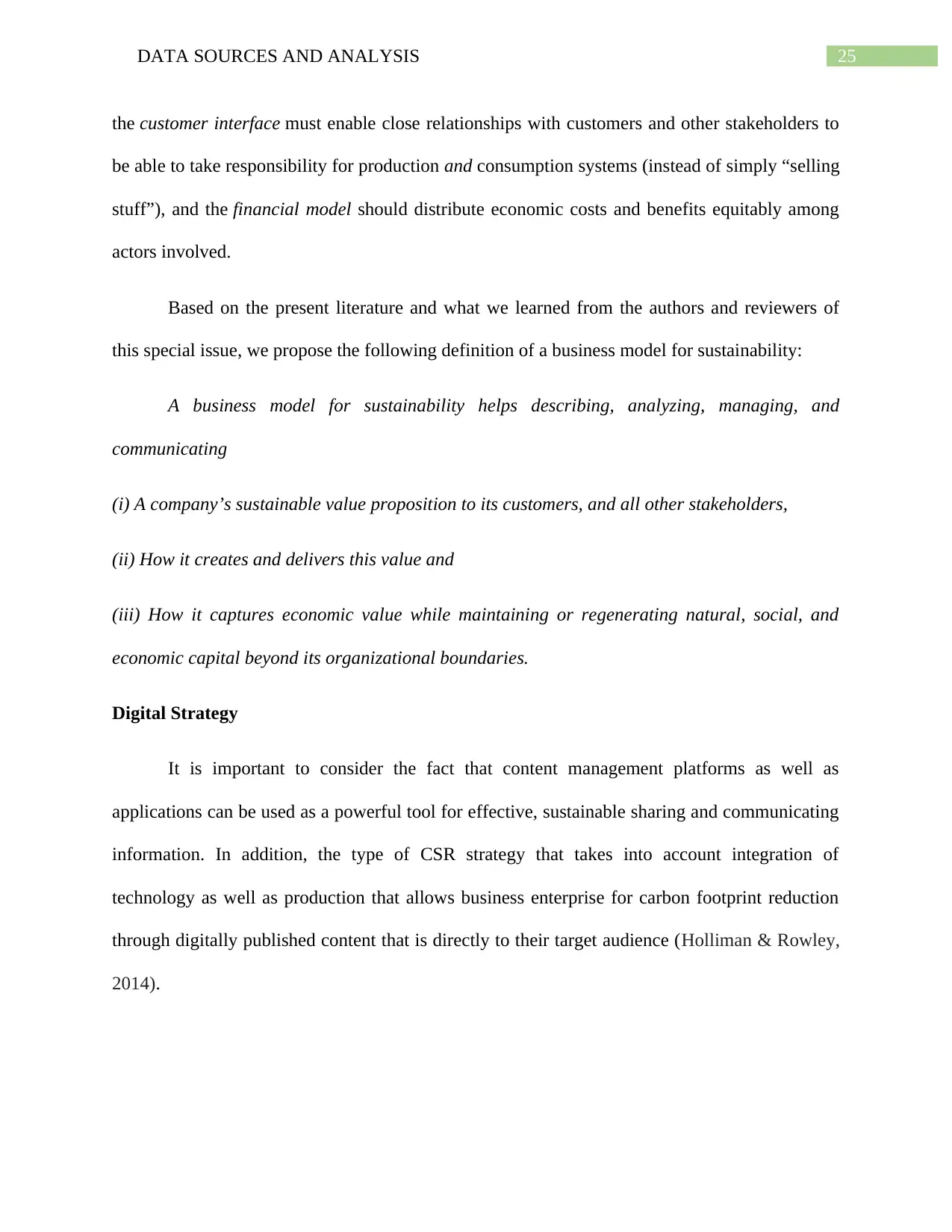
25DATA SOURCES AND ANALYSIS
the customer interface must enable close relationships with customers and other stakeholders to
be able to take responsibility for production and consumption systems (instead of simply “selling
stuff”), and the financial model should distribute economic costs and benefits equitably among
actors involved.
Based on the present literature and what we learned from the authors and reviewers of
this special issue, we propose the following definition of a business model for sustainability:
A business model for sustainability helps describing, analyzing, managing, and
communicating
(i) A company’s sustainable value proposition to its customers, and all other stakeholders,
(ii) How it creates and delivers this value and
(iii) How it captures economic value while maintaining or regenerating natural, social, and
economic capital beyond its organizational boundaries.
Digital Strategy
It is important to consider the fact that content management platforms as well as
applications can be used as a powerful tool for effective, sustainable sharing and communicating
information. In addition, the type of CSR strategy that takes into account integration of
technology as well as production that allows business enterprise for carbon footprint reduction
through digitally published content that is directly to their target audience (Holliman & Rowley,
2014).
the customer interface must enable close relationships with customers and other stakeholders to
be able to take responsibility for production and consumption systems (instead of simply “selling
stuff”), and the financial model should distribute economic costs and benefits equitably among
actors involved.
Based on the present literature and what we learned from the authors and reviewers of
this special issue, we propose the following definition of a business model for sustainability:
A business model for sustainability helps describing, analyzing, managing, and
communicating
(i) A company’s sustainable value proposition to its customers, and all other stakeholders,
(ii) How it creates and delivers this value and
(iii) How it captures economic value while maintaining or regenerating natural, social, and
economic capital beyond its organizational boundaries.
Digital Strategy
It is important to consider the fact that content management platforms as well as
applications can be used as a powerful tool for effective, sustainable sharing and communicating
information. In addition, the type of CSR strategy that takes into account integration of
technology as well as production that allows business enterprise for carbon footprint reduction
through digitally published content that is directly to their target audience (Holliman & Rowley,
2014).
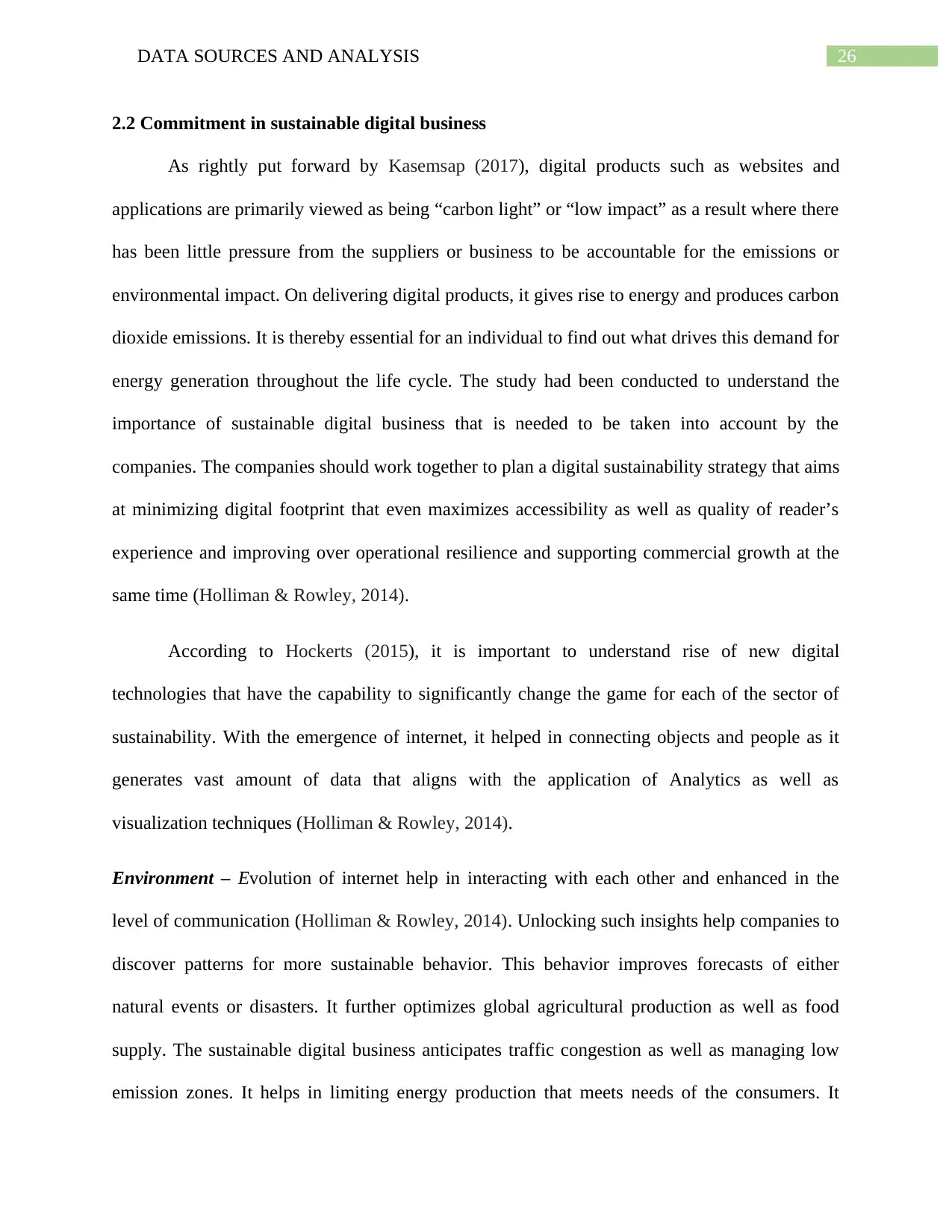
26DATA SOURCES AND ANALYSIS
2.2 Commitment in sustainable digital business
As rightly put forward by Kasemsap (2017), digital products such as websites and
applications are primarily viewed as being “carbon light” or “low impact” as a result where there
has been little pressure from the suppliers or business to be accountable for the emissions or
environmental impact. On delivering digital products, it gives rise to energy and produces carbon
dioxide emissions. It is thereby essential for an individual to find out what drives this demand for
energy generation throughout the life cycle. The study had been conducted to understand the
importance of sustainable digital business that is needed to be taken into account by the
companies. The companies should work together to plan a digital sustainability strategy that aims
at minimizing digital footprint that even maximizes accessibility as well as quality of reader’s
experience and improving over operational resilience and supporting commercial growth at the
same time (Holliman & Rowley, 2014).
According to Hockerts (2015), it is important to understand rise of new digital
technologies that have the capability to significantly change the game for each of the sector of
sustainability. With the emergence of internet, it helped in connecting objects and people as it
generates vast amount of data that aligns with the application of Analytics as well as
visualization techniques (Holliman & Rowley, 2014).
Environment – Evolution of internet help in interacting with each other and enhanced in the
level of communication (Holliman & Rowley, 2014). Unlocking such insights help companies to
discover patterns for more sustainable behavior. This behavior improves forecasts of either
natural events or disasters. It further optimizes global agricultural production as well as food
supply. The sustainable digital business anticipates traffic congestion as well as managing low
emission zones. It helps in limiting energy production that meets needs of the consumers. It
2.2 Commitment in sustainable digital business
As rightly put forward by Kasemsap (2017), digital products such as websites and
applications are primarily viewed as being “carbon light” or “low impact” as a result where there
has been little pressure from the suppliers or business to be accountable for the emissions or
environmental impact. On delivering digital products, it gives rise to energy and produces carbon
dioxide emissions. It is thereby essential for an individual to find out what drives this demand for
energy generation throughout the life cycle. The study had been conducted to understand the
importance of sustainable digital business that is needed to be taken into account by the
companies. The companies should work together to plan a digital sustainability strategy that aims
at minimizing digital footprint that even maximizes accessibility as well as quality of reader’s
experience and improving over operational resilience and supporting commercial growth at the
same time (Holliman & Rowley, 2014).
According to Hockerts (2015), it is important to understand rise of new digital
technologies that have the capability to significantly change the game for each of the sector of
sustainability. With the emergence of internet, it helped in connecting objects and people as it
generates vast amount of data that aligns with the application of Analytics as well as
visualization techniques (Holliman & Rowley, 2014).
Environment – Evolution of internet help in interacting with each other and enhanced in the
level of communication (Holliman & Rowley, 2014). Unlocking such insights help companies to
discover patterns for more sustainable behavior. This behavior improves forecasts of either
natural events or disasters. It further optimizes global agricultural production as well as food
supply. The sustainable digital business anticipates traffic congestion as well as managing low
emission zones. It helps in limiting energy production that meets needs of the consumers. It
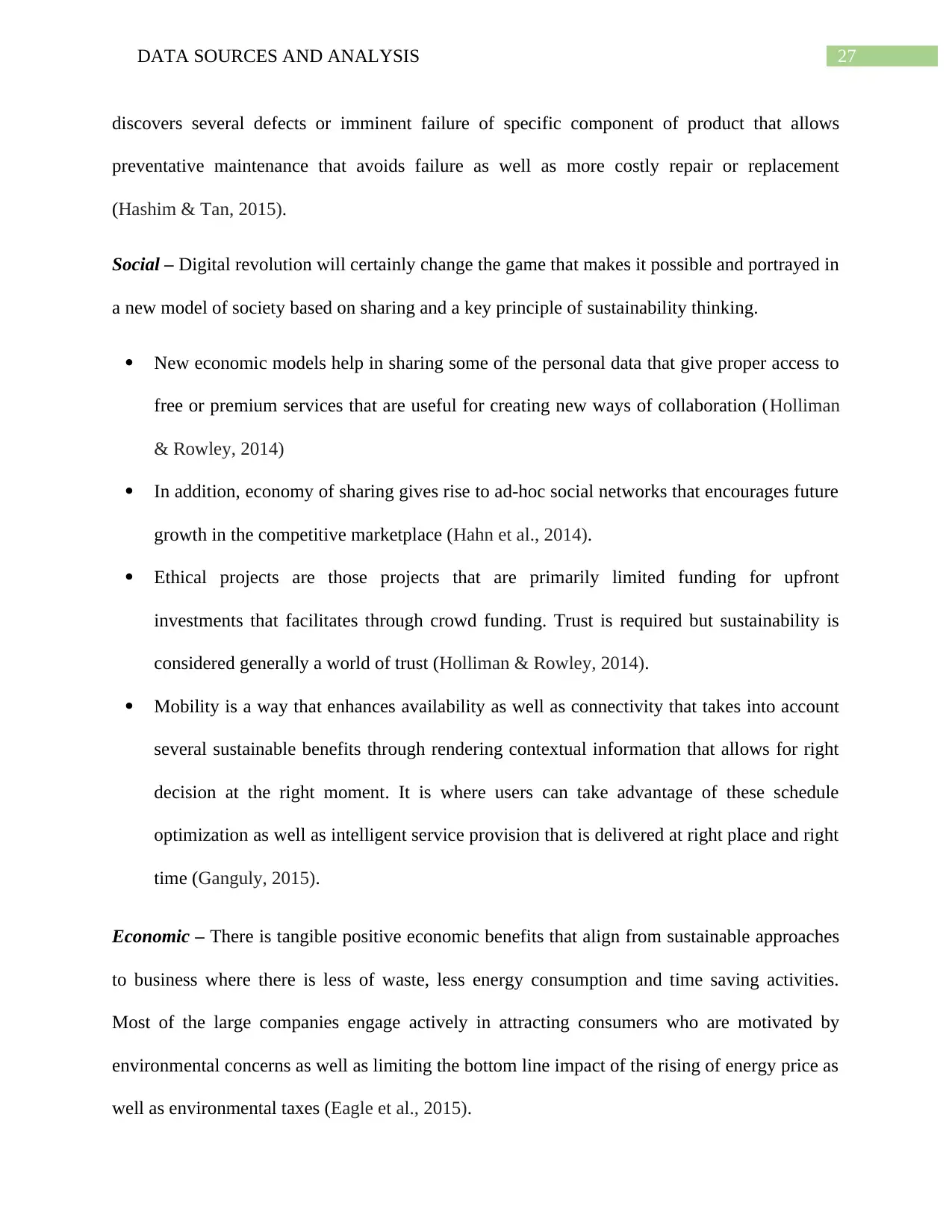
27DATA SOURCES AND ANALYSIS
discovers several defects or imminent failure of specific component of product that allows
preventative maintenance that avoids failure as well as more costly repair or replacement
(Hashim & Tan, 2015).
Social – Digital revolution will certainly change the game that makes it possible and portrayed in
a new model of society based on sharing and a key principle of sustainability thinking.
New economic models help in sharing some of the personal data that give proper access to
free or premium services that are useful for creating new ways of collaboration (Holliman
& Rowley, 2014)
In addition, economy of sharing gives rise to ad-hoc social networks that encourages future
growth in the competitive marketplace (Hahn et al., 2014).
Ethical projects are those projects that are primarily limited funding for upfront
investments that facilitates through crowd funding. Trust is required but sustainability is
considered generally a world of trust (Holliman & Rowley, 2014).
Mobility is a way that enhances availability as well as connectivity that takes into account
several sustainable benefits through rendering contextual information that allows for right
decision at the right moment. It is where users can take advantage of these schedule
optimization as well as intelligent service provision that is delivered at right place and right
time (Ganguly, 2015).
Economic – There is tangible positive economic benefits that align from sustainable approaches
to business where there is less of waste, less energy consumption and time saving activities.
Most of the large companies engage actively in attracting consumers who are motivated by
environmental concerns as well as limiting the bottom line impact of the rising of energy price as
well as environmental taxes (Eagle et al., 2015).
discovers several defects or imminent failure of specific component of product that allows
preventative maintenance that avoids failure as well as more costly repair or replacement
(Hashim & Tan, 2015).
Social – Digital revolution will certainly change the game that makes it possible and portrayed in
a new model of society based on sharing and a key principle of sustainability thinking.
New economic models help in sharing some of the personal data that give proper access to
free or premium services that are useful for creating new ways of collaboration (Holliman
& Rowley, 2014)
In addition, economy of sharing gives rise to ad-hoc social networks that encourages future
growth in the competitive marketplace (Hahn et al., 2014).
Ethical projects are those projects that are primarily limited funding for upfront
investments that facilitates through crowd funding. Trust is required but sustainability is
considered generally a world of trust (Holliman & Rowley, 2014).
Mobility is a way that enhances availability as well as connectivity that takes into account
several sustainable benefits through rendering contextual information that allows for right
decision at the right moment. It is where users can take advantage of these schedule
optimization as well as intelligent service provision that is delivered at right place and right
time (Ganguly, 2015).
Economic – There is tangible positive economic benefits that align from sustainable approaches
to business where there is less of waste, less energy consumption and time saving activities.
Most of the large companies engage actively in attracting consumers who are motivated by
environmental concerns as well as limiting the bottom line impact of the rising of energy price as
well as environmental taxes (Eagle et al., 2015).
Secure Best Marks with AI Grader
Need help grading? Try our AI Grader for instant feedback on your assignments.
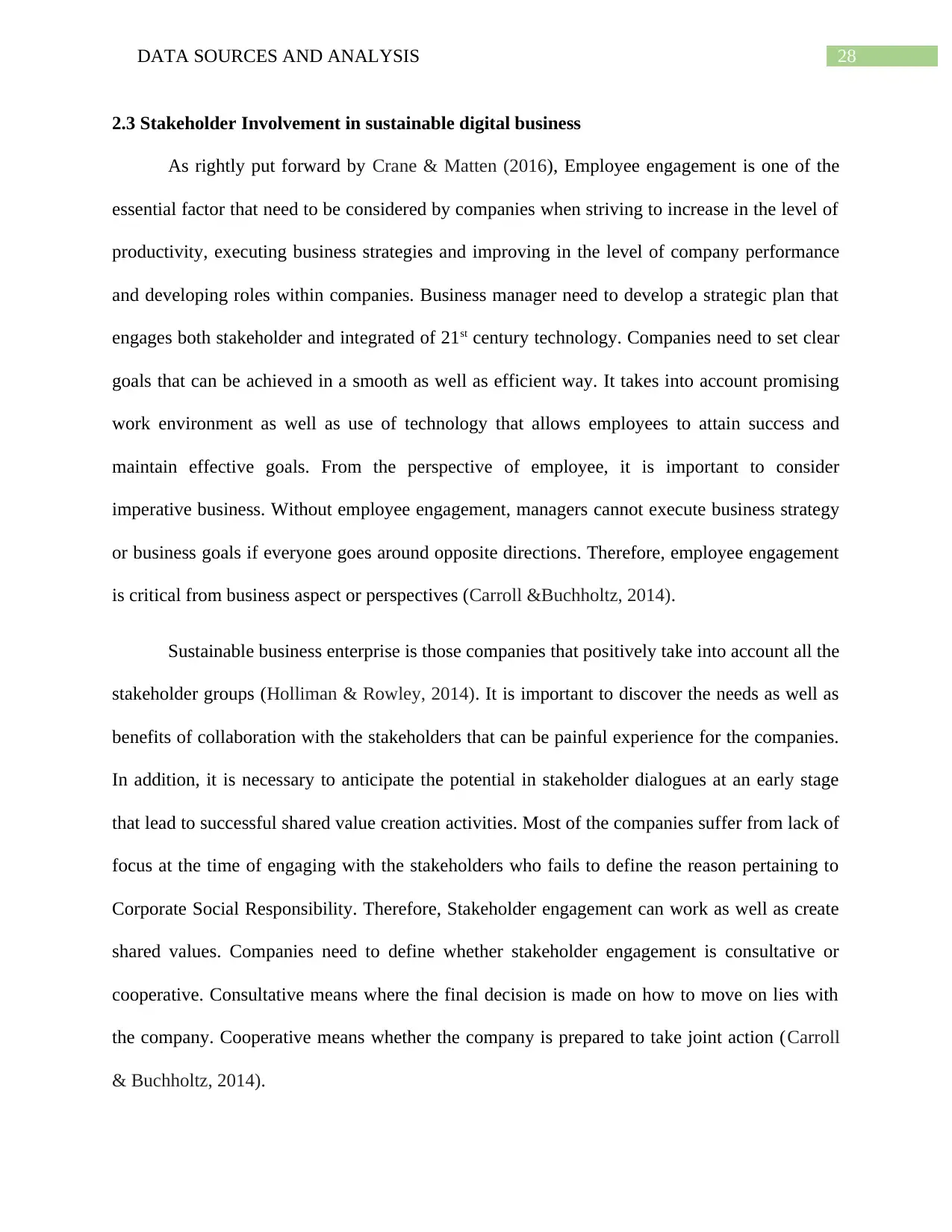
28DATA SOURCES AND ANALYSIS
2.3 Stakeholder Involvement in sustainable digital business
As rightly put forward by Crane & Matten (2016), Employee engagement is one of the
essential factor that need to be considered by companies when striving to increase in the level of
productivity, executing business strategies and improving in the level of company performance
and developing roles within companies. Business manager need to develop a strategic plan that
engages both stakeholder and integrated of 21st century technology. Companies need to set clear
goals that can be achieved in a smooth as well as efficient way. It takes into account promising
work environment as well as use of technology that allows employees to attain success and
maintain effective goals. From the perspective of employee, it is important to consider
imperative business. Without employee engagement, managers cannot execute business strategy
or business goals if everyone goes around opposite directions. Therefore, employee engagement
is critical from business aspect or perspectives (Carroll &Buchholtz, 2014).
Sustainable business enterprise is those companies that positively take into account all the
stakeholder groups (Holliman & Rowley, 2014). It is important to discover the needs as well as
benefits of collaboration with the stakeholders that can be painful experience for the companies.
In addition, it is necessary to anticipate the potential in stakeholder dialogues at an early stage
that lead to successful shared value creation activities. Most of the companies suffer from lack of
focus at the time of engaging with the stakeholders who fails to define the reason pertaining to
Corporate Social Responsibility. Therefore, Stakeholder engagement can work as well as create
shared values. Companies need to define whether stakeholder engagement is consultative or
cooperative. Consultative means where the final decision is made on how to move on lies with
the company. Cooperative means whether the company is prepared to take joint action (Carroll
& Buchholtz, 2014).
2.3 Stakeholder Involvement in sustainable digital business
As rightly put forward by Crane & Matten (2016), Employee engagement is one of the
essential factor that need to be considered by companies when striving to increase in the level of
productivity, executing business strategies and improving in the level of company performance
and developing roles within companies. Business manager need to develop a strategic plan that
engages both stakeholder and integrated of 21st century technology. Companies need to set clear
goals that can be achieved in a smooth as well as efficient way. It takes into account promising
work environment as well as use of technology that allows employees to attain success and
maintain effective goals. From the perspective of employee, it is important to consider
imperative business. Without employee engagement, managers cannot execute business strategy
or business goals if everyone goes around opposite directions. Therefore, employee engagement
is critical from business aspect or perspectives (Carroll &Buchholtz, 2014).
Sustainable business enterprise is those companies that positively take into account all the
stakeholder groups (Holliman & Rowley, 2014). It is important to discover the needs as well as
benefits of collaboration with the stakeholders that can be painful experience for the companies.
In addition, it is necessary to anticipate the potential in stakeholder dialogues at an early stage
that lead to successful shared value creation activities. Most of the companies suffer from lack of
focus at the time of engaging with the stakeholders who fails to define the reason pertaining to
Corporate Social Responsibility. Therefore, Stakeholder engagement can work as well as create
shared values. Companies need to define whether stakeholder engagement is consultative or
cooperative. Consultative means where the final decision is made on how to move on lies with
the company. Cooperative means whether the company is prepared to take joint action (Carroll
& Buchholtz, 2014).
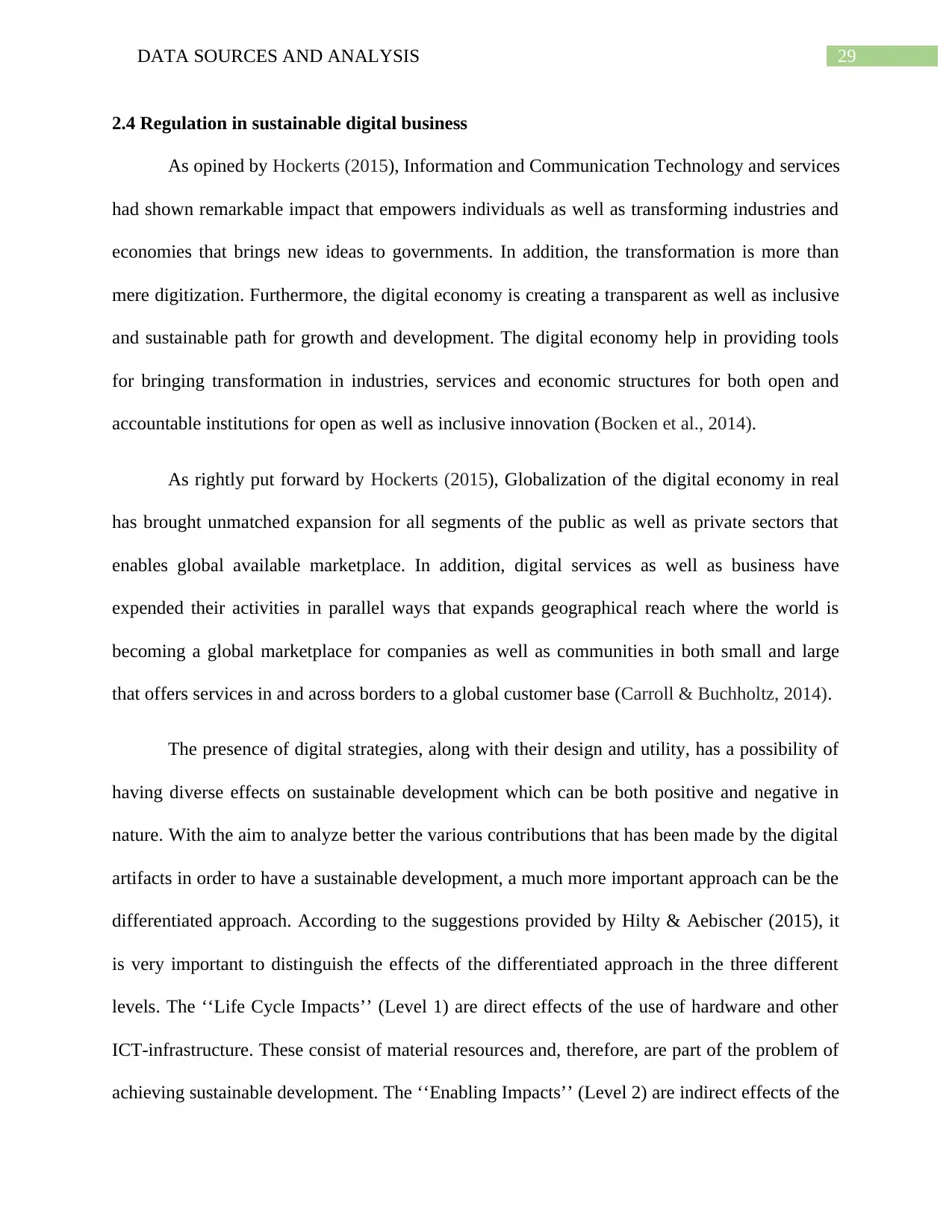
29DATA SOURCES AND ANALYSIS
2.4 Regulation in sustainable digital business
As opined by Hockerts (2015), Information and Communication Technology and services
had shown remarkable impact that empowers individuals as well as transforming industries and
economies that brings new ideas to governments. In addition, the transformation is more than
mere digitization. Furthermore, the digital economy is creating a transparent as well as inclusive
and sustainable path for growth and development. The digital economy help in providing tools
for bringing transformation in industries, services and economic structures for both open and
accountable institutions for open as well as inclusive innovation (Bocken et al., 2014).
As rightly put forward by Hockerts (2015), Globalization of the digital economy in real
has brought unmatched expansion for all segments of the public as well as private sectors that
enables global available marketplace. In addition, digital services as well as business have
expended their activities in parallel ways that expands geographical reach where the world is
becoming a global marketplace for companies as well as communities in both small and large
that offers services in and across borders to a global customer base (Carroll & Buchholtz, 2014).
The presence of digital strategies, along with their design and utility, has a possibility of
having diverse effects on sustainable development which can be both positive and negative in
nature. With the aim to analyze better the various contributions that has been made by the digital
artifacts in order to have a sustainable development, a much more important approach can be the
differentiated approach. According to the suggestions provided by Hilty & Aebischer (2015), it
is very important to distinguish the effects of the differentiated approach in the three different
levels. The ‘‘Life Cycle Impacts’’ (Level 1) are direct effects of the use of hardware and other
ICT-infrastructure. These consist of material resources and, therefore, are part of the problem of
achieving sustainable development. The ‘‘Enabling Impacts’’ (Level 2) are indirect effects of the
2.4 Regulation in sustainable digital business
As opined by Hockerts (2015), Information and Communication Technology and services
had shown remarkable impact that empowers individuals as well as transforming industries and
economies that brings new ideas to governments. In addition, the transformation is more than
mere digitization. Furthermore, the digital economy is creating a transparent as well as inclusive
and sustainable path for growth and development. The digital economy help in providing tools
for bringing transformation in industries, services and economic structures for both open and
accountable institutions for open as well as inclusive innovation (Bocken et al., 2014).
As rightly put forward by Hockerts (2015), Globalization of the digital economy in real
has brought unmatched expansion for all segments of the public as well as private sectors that
enables global available marketplace. In addition, digital services as well as business have
expended their activities in parallel ways that expands geographical reach where the world is
becoming a global marketplace for companies as well as communities in both small and large
that offers services in and across borders to a global customer base (Carroll & Buchholtz, 2014).
The presence of digital strategies, along with their design and utility, has a possibility of
having diverse effects on sustainable development which can be both positive and negative in
nature. With the aim to analyze better the various contributions that has been made by the digital
artifacts in order to have a sustainable development, a much more important approach can be the
differentiated approach. According to the suggestions provided by Hilty & Aebischer (2015), it
is very important to distinguish the effects of the differentiated approach in the three different
levels. The ‘‘Life Cycle Impacts’’ (Level 1) are direct effects of the use of hardware and other
ICT-infrastructure. These consist of material resources and, therefore, are part of the problem of
achieving sustainable development. The ‘‘Enabling Impacts’’ (Level 2) are indirect effects of the
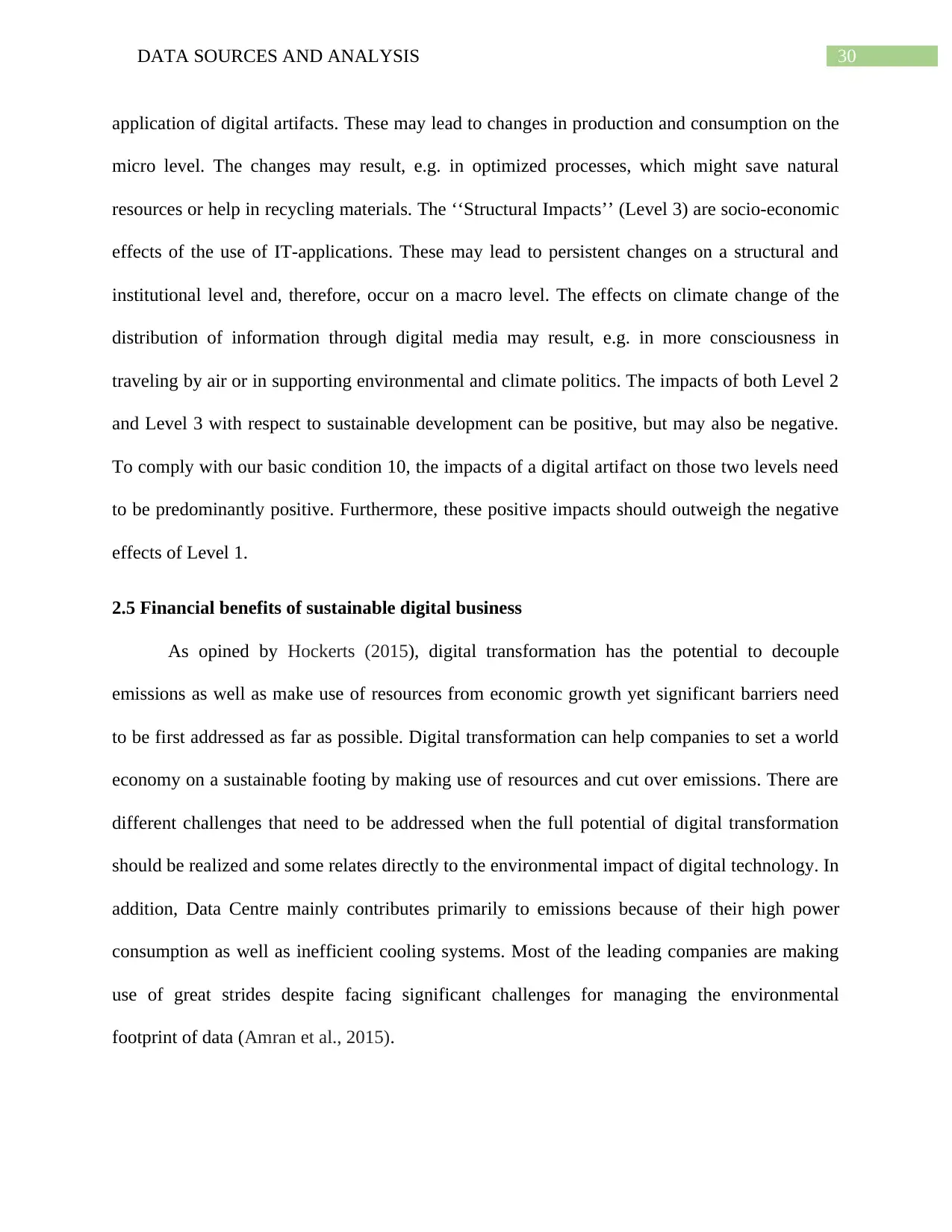
30DATA SOURCES AND ANALYSIS
application of digital artifacts. These may lead to changes in production and consumption on the
micro level. The changes may result, e.g. in optimized processes, which might save natural
resources or help in recycling materials. The ‘‘Structural Impacts’’ (Level 3) are socio-economic
effects of the use of IT-applications. These may lead to persistent changes on a structural and
institutional level and, therefore, occur on a macro level. The effects on climate change of the
distribution of information through digital media may result, e.g. in more consciousness in
traveling by air or in supporting environmental and climate politics. The impacts of both Level 2
and Level 3 with respect to sustainable development can be positive, but may also be negative.
To comply with our basic condition 10, the impacts of a digital artifact on those two levels need
to be predominantly positive. Furthermore, these positive impacts should outweigh the negative
effects of Level 1.
2.5 Financial benefits of sustainable digital business
As opined by Hockerts (2015), digital transformation has the potential to decouple
emissions as well as make use of resources from economic growth yet significant barriers need
to be first addressed as far as possible. Digital transformation can help companies to set a world
economy on a sustainable footing by making use of resources and cut over emissions. There are
different challenges that need to be addressed when the full potential of digital transformation
should be realized and some relates directly to the environmental impact of digital technology. In
addition, Data Centre mainly contributes primarily to emissions because of their high power
consumption as well as inefficient cooling systems. Most of the leading companies are making
use of great strides despite facing significant challenges for managing the environmental
footprint of data (Amran et al., 2015).
application of digital artifacts. These may lead to changes in production and consumption on the
micro level. The changes may result, e.g. in optimized processes, which might save natural
resources or help in recycling materials. The ‘‘Structural Impacts’’ (Level 3) are socio-economic
effects of the use of IT-applications. These may lead to persistent changes on a structural and
institutional level and, therefore, occur on a macro level. The effects on climate change of the
distribution of information through digital media may result, e.g. in more consciousness in
traveling by air or in supporting environmental and climate politics. The impacts of both Level 2
and Level 3 with respect to sustainable development can be positive, but may also be negative.
To comply with our basic condition 10, the impacts of a digital artifact on those two levels need
to be predominantly positive. Furthermore, these positive impacts should outweigh the negative
effects of Level 1.
2.5 Financial benefits of sustainable digital business
As opined by Hockerts (2015), digital transformation has the potential to decouple
emissions as well as make use of resources from economic growth yet significant barriers need
to be first addressed as far as possible. Digital transformation can help companies to set a world
economy on a sustainable footing by making use of resources and cut over emissions. There are
different challenges that need to be addressed when the full potential of digital transformation
should be realized and some relates directly to the environmental impact of digital technology. In
addition, Data Centre mainly contributes primarily to emissions because of their high power
consumption as well as inefficient cooling systems. Most of the leading companies are making
use of great strides despite facing significant challenges for managing the environmental
footprint of data (Amran et al., 2015).
Paraphrase This Document
Need a fresh take? Get an instant paraphrase of this document with our AI Paraphraser
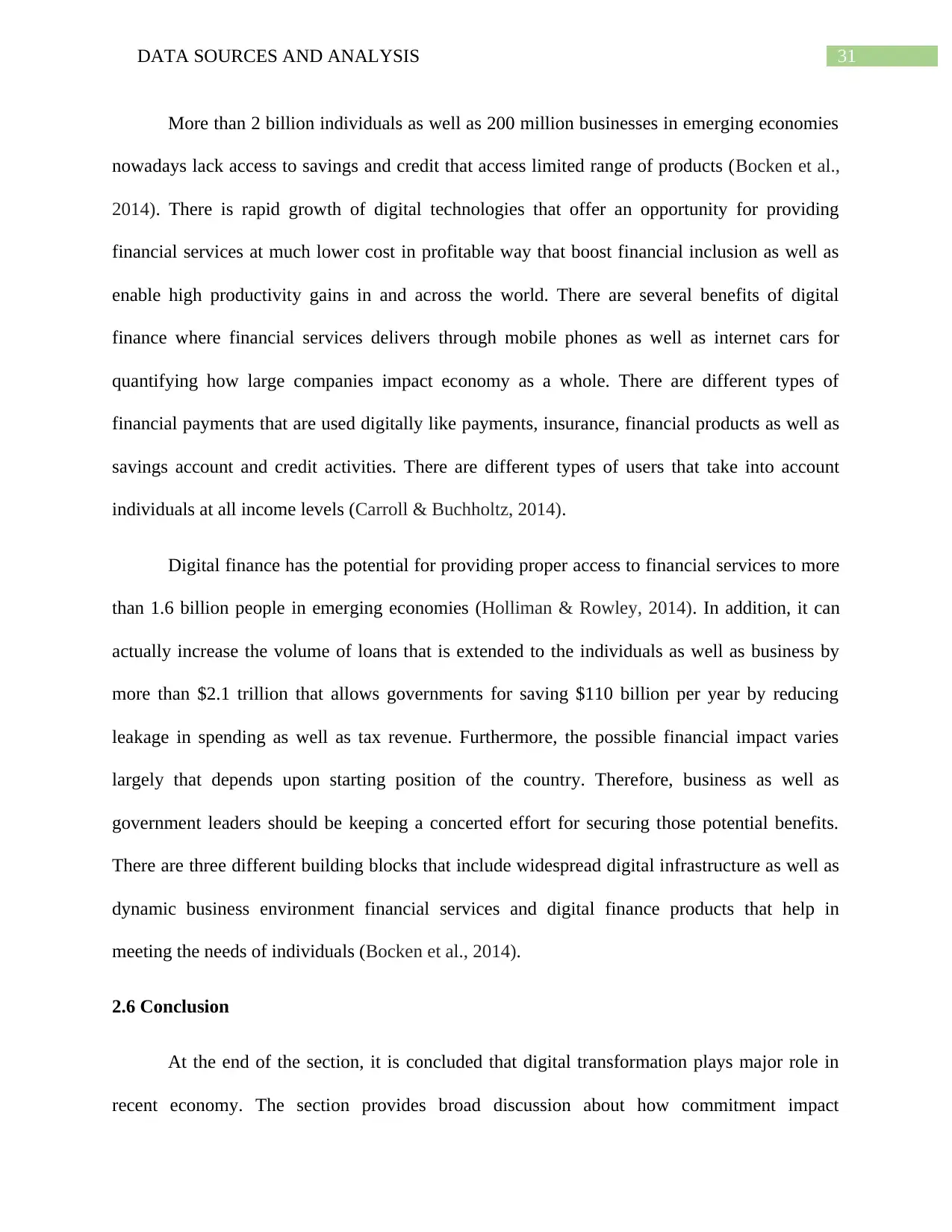
31DATA SOURCES AND ANALYSIS
More than 2 billion individuals as well as 200 million businesses in emerging economies
nowadays lack access to savings and credit that access limited range of products (Bocken et al.,
2014). There is rapid growth of digital technologies that offer an opportunity for providing
financial services at much lower cost in profitable way that boost financial inclusion as well as
enable high productivity gains in and across the world. There are several benefits of digital
finance where financial services delivers through mobile phones as well as internet cars for
quantifying how large companies impact economy as a whole. There are different types of
financial payments that are used digitally like payments, insurance, financial products as well as
savings account and credit activities. There are different types of users that take into account
individuals at all income levels (Carroll & Buchholtz, 2014).
Digital finance has the potential for providing proper access to financial services to more
than 1.6 billion people in emerging economies (Holliman & Rowley, 2014). In addition, it can
actually increase the volume of loans that is extended to the individuals as well as business by
more than $2.1 trillion that allows governments for saving $110 billion per year by reducing
leakage in spending as well as tax revenue. Furthermore, the possible financial impact varies
largely that depends upon starting position of the country. Therefore, business as well as
government leaders should be keeping a concerted effort for securing those potential benefits.
There are three different building blocks that include widespread digital infrastructure as well as
dynamic business environment financial services and digital finance products that help in
meeting the needs of individuals (Bocken et al., 2014).
2.6 Conclusion
At the end of the section, it is concluded that digital transformation plays major role in
recent economy. The section provides broad discussion about how commitment impact
More than 2 billion individuals as well as 200 million businesses in emerging economies
nowadays lack access to savings and credit that access limited range of products (Bocken et al.,
2014). There is rapid growth of digital technologies that offer an opportunity for providing
financial services at much lower cost in profitable way that boost financial inclusion as well as
enable high productivity gains in and across the world. There are several benefits of digital
finance where financial services delivers through mobile phones as well as internet cars for
quantifying how large companies impact economy as a whole. There are different types of
financial payments that are used digitally like payments, insurance, financial products as well as
savings account and credit activities. There are different types of users that take into account
individuals at all income levels (Carroll & Buchholtz, 2014).
Digital finance has the potential for providing proper access to financial services to more
than 1.6 billion people in emerging economies (Holliman & Rowley, 2014). In addition, it can
actually increase the volume of loans that is extended to the individuals as well as business by
more than $2.1 trillion that allows governments for saving $110 billion per year by reducing
leakage in spending as well as tax revenue. Furthermore, the possible financial impact varies
largely that depends upon starting position of the country. Therefore, business as well as
government leaders should be keeping a concerted effort for securing those potential benefits.
There are three different building blocks that include widespread digital infrastructure as well as
dynamic business environment financial services and digital finance products that help in
meeting the needs of individuals (Bocken et al., 2014).
2.6 Conclusion
At the end of the section, it is concluded that digital transformation plays major role in
recent economy. The section provides broad discussion about how commitment impact
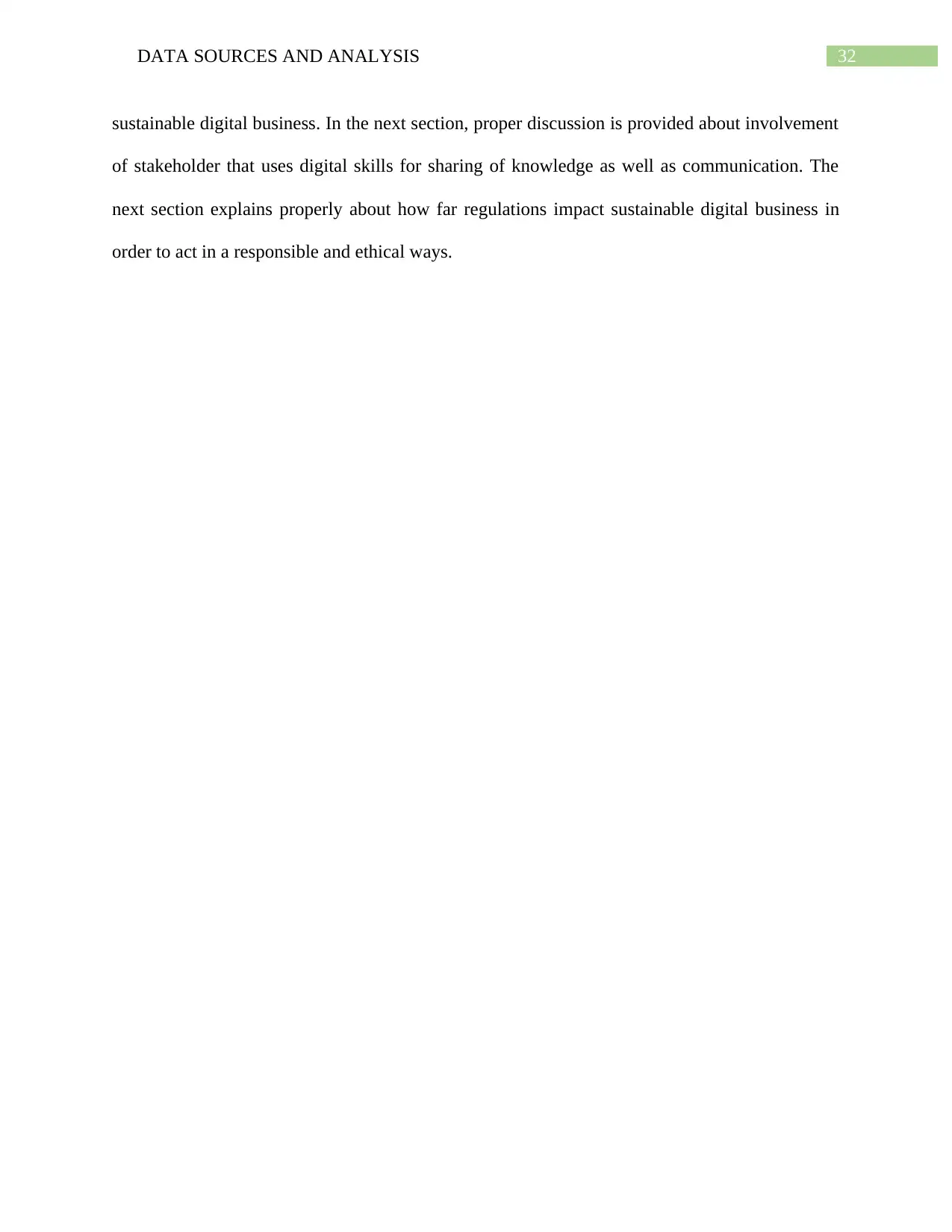
32DATA SOURCES AND ANALYSIS
sustainable digital business. In the next section, proper discussion is provided about involvement
of stakeholder that uses digital skills for sharing of knowledge as well as communication. The
next section explains properly about how far regulations impact sustainable digital business in
order to act in a responsible and ethical ways.
sustainable digital business. In the next section, proper discussion is provided about involvement
of stakeholder that uses digital skills for sharing of knowledge as well as communication. The
next section explains properly about how far regulations impact sustainable digital business in
order to act in a responsible and ethical ways.
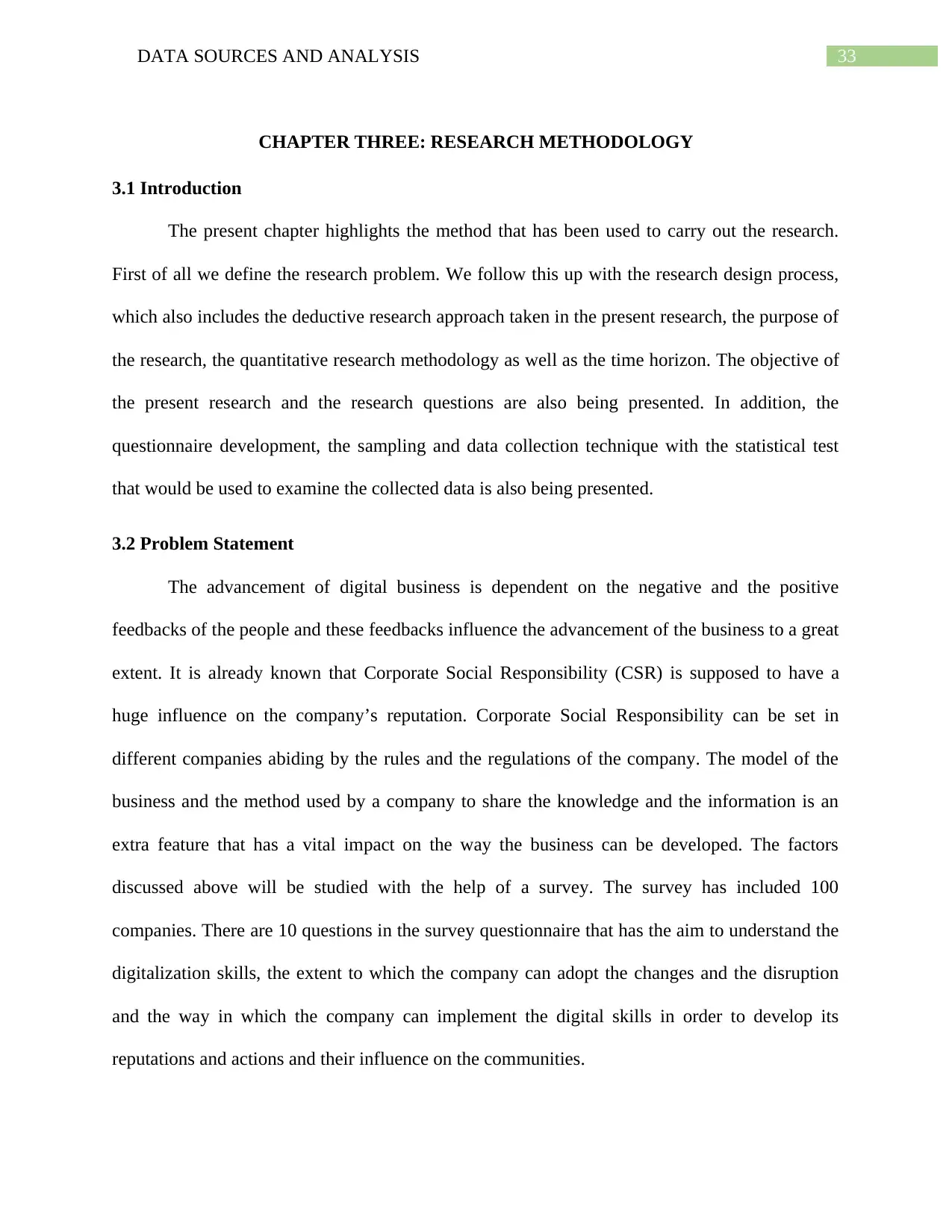
33DATA SOURCES AND ANALYSIS
CHAPTER THREE: RESEARCH METHODOLOGY
3.1 Introduction
The present chapter highlights the method that has been used to carry out the research.
First of all we define the research problem. We follow this up with the research design process,
which also includes the deductive research approach taken in the present research, the purpose of
the research, the quantitative research methodology as well as the time horizon. The objective of
the present research and the research questions are also being presented. In addition, the
questionnaire development, the sampling and data collection technique with the statistical test
that would be used to examine the collected data is also being presented.
3.2 Problem Statement
The advancement of digital business is dependent on the negative and the positive
feedbacks of the people and these feedbacks influence the advancement of the business to a great
extent. It is already known that Corporate Social Responsibility (CSR) is supposed to have a
huge influence on the company’s reputation. Corporate Social Responsibility can be set in
different companies abiding by the rules and the regulations of the company. The model of the
business and the method used by a company to share the knowledge and the information is an
extra feature that has a vital impact on the way the business can be developed. The factors
discussed above will be studied with the help of a survey. The survey has included 100
companies. There are 10 questions in the survey questionnaire that has the aim to understand the
digitalization skills, the extent to which the company can adopt the changes and the disruption
and the way in which the company can implement the digital skills in order to develop its
reputations and actions and their influence on the communities.
CHAPTER THREE: RESEARCH METHODOLOGY
3.1 Introduction
The present chapter highlights the method that has been used to carry out the research.
First of all we define the research problem. We follow this up with the research design process,
which also includes the deductive research approach taken in the present research, the purpose of
the research, the quantitative research methodology as well as the time horizon. The objective of
the present research and the research questions are also being presented. In addition, the
questionnaire development, the sampling and data collection technique with the statistical test
that would be used to examine the collected data is also being presented.
3.2 Problem Statement
The advancement of digital business is dependent on the negative and the positive
feedbacks of the people and these feedbacks influence the advancement of the business to a great
extent. It is already known that Corporate Social Responsibility (CSR) is supposed to have a
huge influence on the company’s reputation. Corporate Social Responsibility can be set in
different companies abiding by the rules and the regulations of the company. The model of the
business and the method used by a company to share the knowledge and the information is an
extra feature that has a vital impact on the way the business can be developed. The factors
discussed above will be studied with the help of a survey. The survey has included 100
companies. There are 10 questions in the survey questionnaire that has the aim to understand the
digitalization skills, the extent to which the company can adopt the changes and the disruption
and the way in which the company can implement the digital skills in order to develop its
reputations and actions and their influence on the communities.
Secure Best Marks with AI Grader
Need help grading? Try our AI Grader for instant feedback on your assignments.
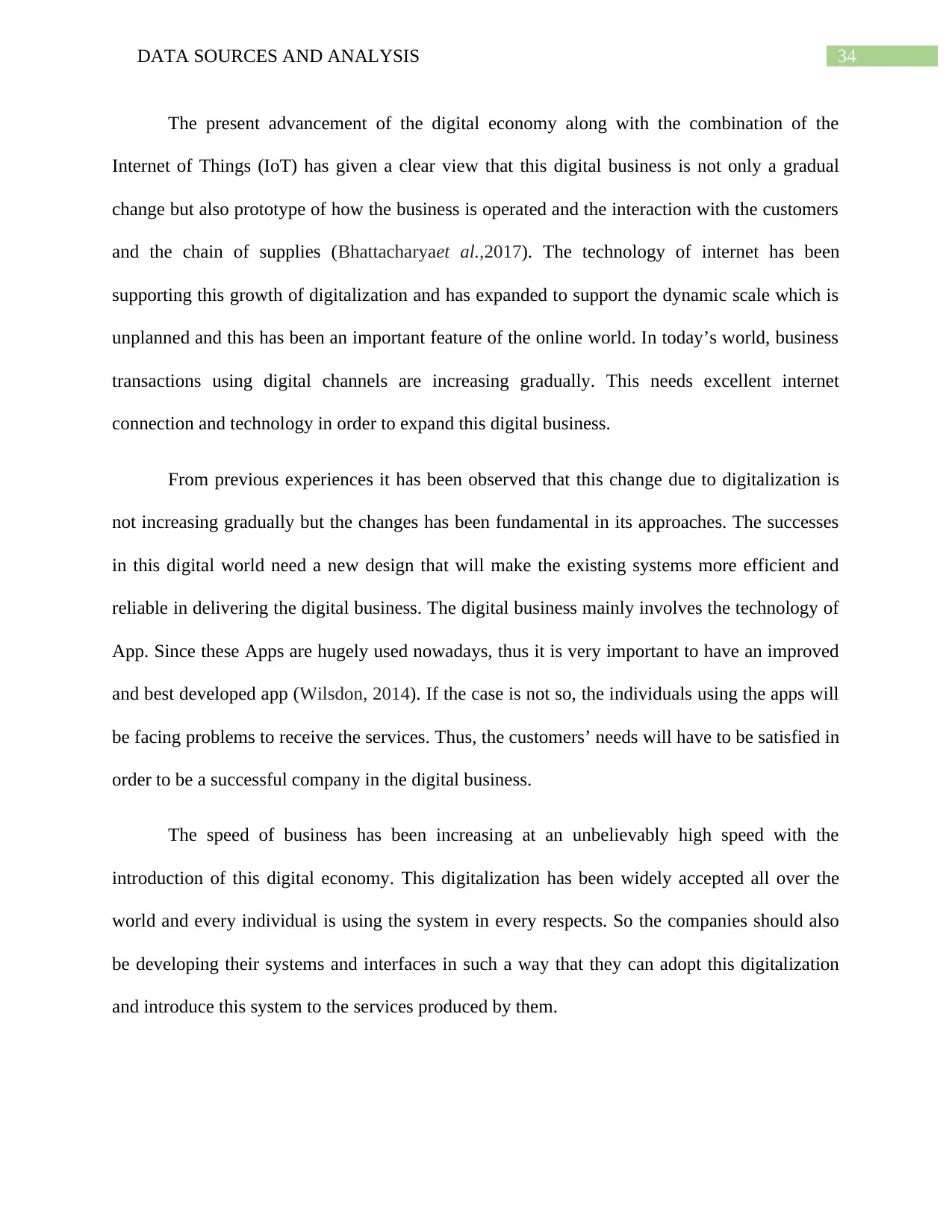
34DATA SOURCES AND ANALYSIS
The present advancement of the digital economy along with the combination of the
Internet of Things (IoT) has given a clear view that this digital business is not only a gradual
change but also prototype of how the business is operated and the interaction with the customers
and the chain of supplies (Bhattacharyaet al.,2017). The technology of internet has been
supporting this growth of digitalization and has expanded to support the dynamic scale which is
unplanned and this has been an important feature of the online world. In today’s world, business
transactions using digital channels are increasing gradually. This needs excellent internet
connection and technology in order to expand this digital business.
From previous experiences it has been observed that this change due to digitalization is
not increasing gradually but the changes has been fundamental in its approaches. The successes
in this digital world need a new design that will make the existing systems more efficient and
reliable in delivering the digital business. The digital business mainly involves the technology of
App. Since these Apps are hugely used nowadays, thus it is very important to have an improved
and best developed app (Wilsdon, 2014). If the case is not so, the individuals using the apps will
be facing problems to receive the services. Thus, the customers’ needs will have to be satisfied in
order to be a successful company in the digital business.
The speed of business has been increasing at an unbelievably high speed with the
introduction of this digital economy. This digitalization has been widely accepted all over the
world and every individual is using the system in every respects. So the companies should also
be developing their systems and interfaces in such a way that they can adopt this digitalization
and introduce this system to the services produced by them.
The present advancement of the digital economy along with the combination of the
Internet of Things (IoT) has given a clear view that this digital business is not only a gradual
change but also prototype of how the business is operated and the interaction with the customers
and the chain of supplies (Bhattacharyaet al.,2017). The technology of internet has been
supporting this growth of digitalization and has expanded to support the dynamic scale which is
unplanned and this has been an important feature of the online world. In today’s world, business
transactions using digital channels are increasing gradually. This needs excellent internet
connection and technology in order to expand this digital business.
From previous experiences it has been observed that this change due to digitalization is
not increasing gradually but the changes has been fundamental in its approaches. The successes
in this digital world need a new design that will make the existing systems more efficient and
reliable in delivering the digital business. The digital business mainly involves the technology of
App. Since these Apps are hugely used nowadays, thus it is very important to have an improved
and best developed app (Wilsdon, 2014). If the case is not so, the individuals using the apps will
be facing problems to receive the services. Thus, the customers’ needs will have to be satisfied in
order to be a successful company in the digital business.
The speed of business has been increasing at an unbelievably high speed with the
introduction of this digital economy. This digitalization has been widely accepted all over the
world and every individual is using the system in every respects. So the companies should also
be developing their systems and interfaces in such a way that they can adopt this digitalization
and introduce this system to the services produced by them.
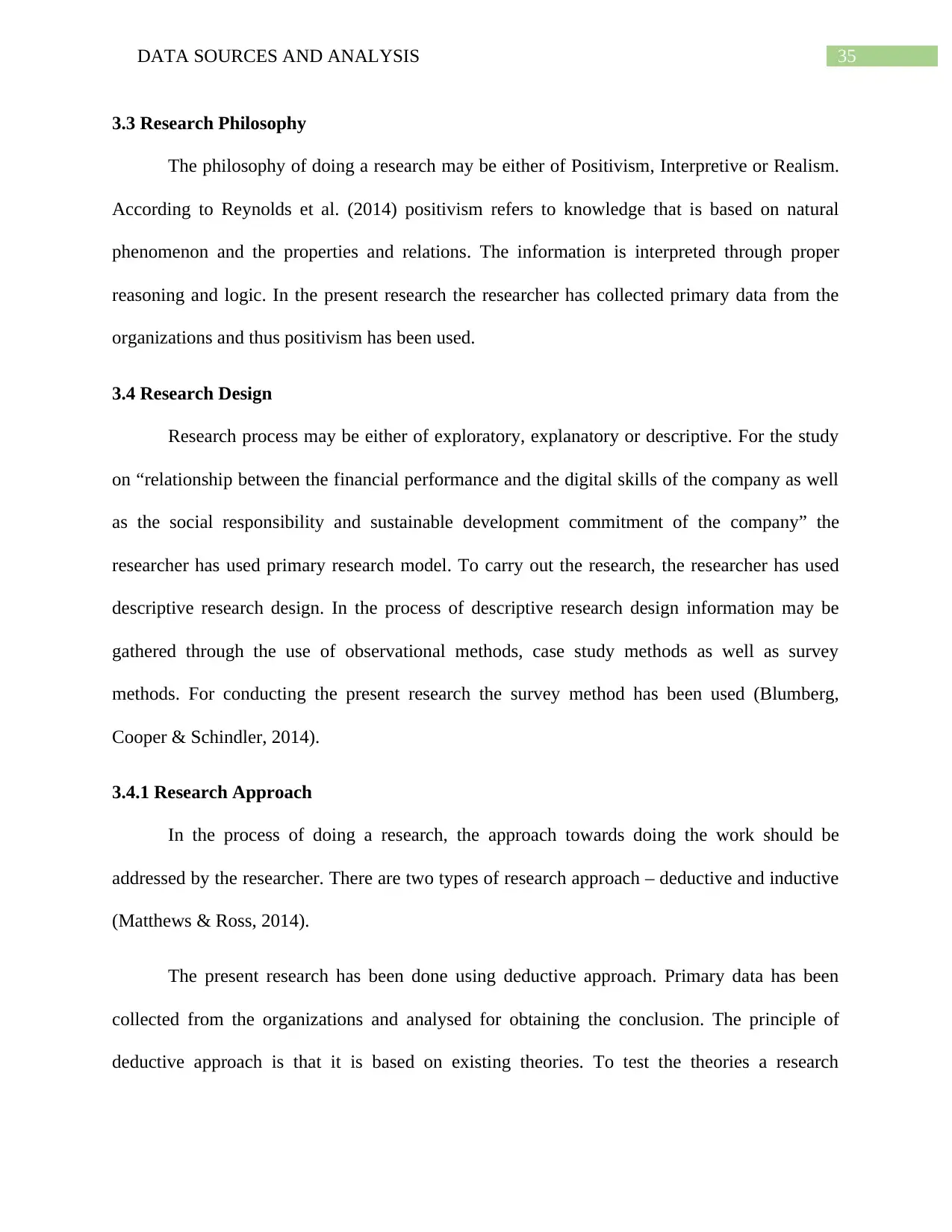
35DATA SOURCES AND ANALYSIS
3.3 Research Philosophy
The philosophy of doing a research may be either of Positivism, Interpretive or Realism.
According to Reynolds et al. (2014) positivism refers to knowledge that is based on natural
phenomenon and the properties and relations. The information is interpreted through proper
reasoning and logic. In the present research the researcher has collected primary data from the
organizations and thus positivism has been used.
3.4 Research Design
Research process may be either of exploratory, explanatory or descriptive. For the study
on “relationship between the financial performance and the digital skills of the company as well
as the social responsibility and sustainable development commitment of the company” the
researcher has used primary research model. To carry out the research, the researcher has used
descriptive research design. In the process of descriptive research design information may be
gathered through the use of observational methods, case study methods as well as survey
methods. For conducting the present research the survey method has been used (Blumberg,
Cooper & Schindler, 2014).
3.4.1 Research Approach
In the process of doing a research, the approach towards doing the work should be
addressed by the researcher. There are two types of research approach – deductive and inductive
(Matthews & Ross, 2014).
The present research has been done using deductive approach. Primary data has been
collected from the organizations and analysed for obtaining the conclusion. The principle of
deductive approach is that it is based on existing theories. To test the theories a research
3.3 Research Philosophy
The philosophy of doing a research may be either of Positivism, Interpretive or Realism.
According to Reynolds et al. (2014) positivism refers to knowledge that is based on natural
phenomenon and the properties and relations. The information is interpreted through proper
reasoning and logic. In the present research the researcher has collected primary data from the
organizations and thus positivism has been used.
3.4 Research Design
Research process may be either of exploratory, explanatory or descriptive. For the study
on “relationship between the financial performance and the digital skills of the company as well
as the social responsibility and sustainable development commitment of the company” the
researcher has used primary research model. To carry out the research, the researcher has used
descriptive research design. In the process of descriptive research design information may be
gathered through the use of observational methods, case study methods as well as survey
methods. For conducting the present research the survey method has been used (Blumberg,
Cooper & Schindler, 2014).
3.4.1 Research Approach
In the process of doing a research, the approach towards doing the work should be
addressed by the researcher. There are two types of research approach – deductive and inductive
(Matthews & Ross, 2014).
The present research has been done using deductive approach. Primary data has been
collected from the organizations and analysed for obtaining the conclusion. The principle of
deductive approach is that it is based on existing theories. To test the theories a research
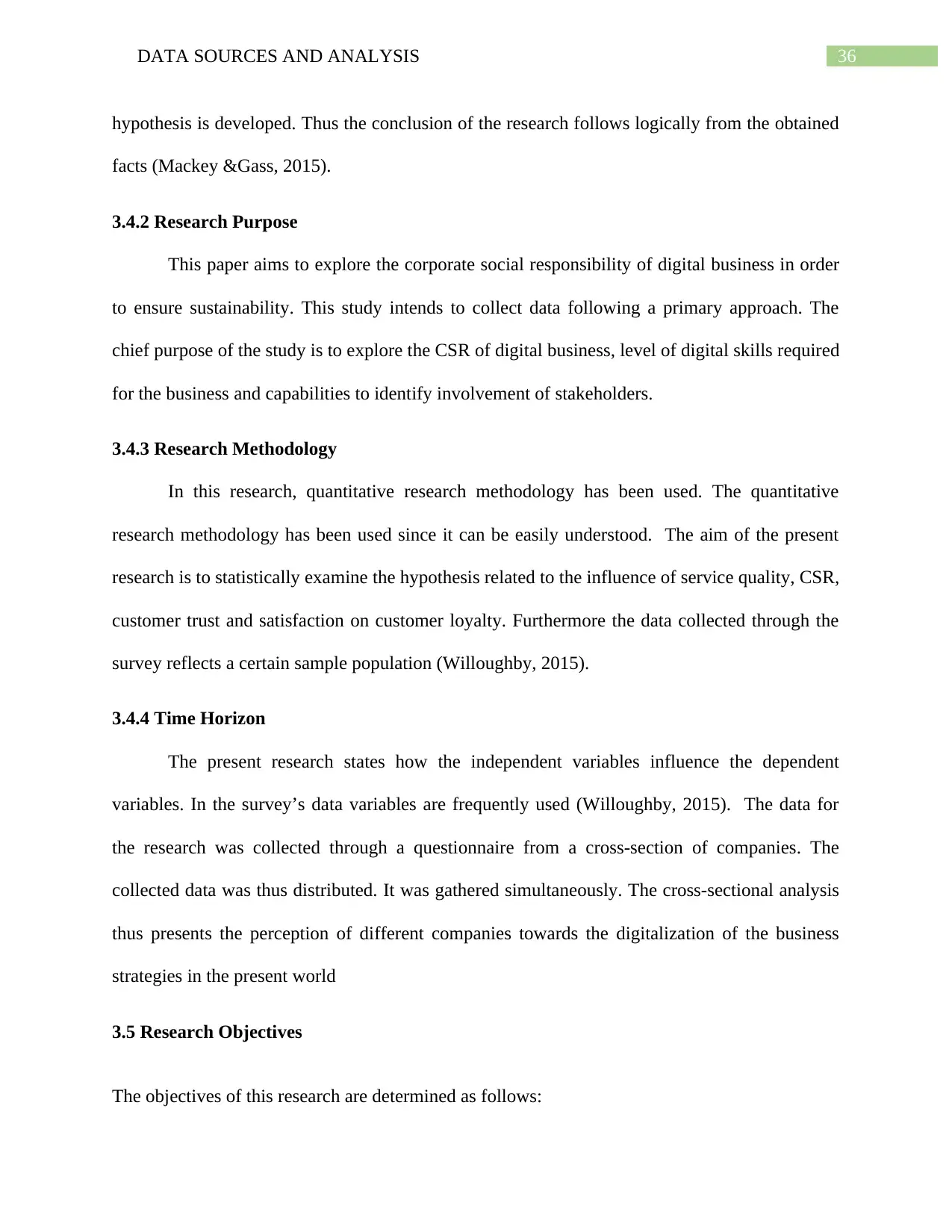
36DATA SOURCES AND ANALYSIS
hypothesis is developed. Thus the conclusion of the research follows logically from the obtained
facts (Mackey &Gass, 2015).
3.4.2 Research Purpose
This paper aims to explore the corporate social responsibility of digital business in order
to ensure sustainability. This study intends to collect data following a primary approach. The
chief purpose of the study is to explore the CSR of digital business, level of digital skills required
for the business and capabilities to identify involvement of stakeholders.
3.4.3 Research Methodology
In this research, quantitative research methodology has been used. The quantitative
research methodology has been used since it can be easily understood. The aim of the present
research is to statistically examine the hypothesis related to the influence of service quality, CSR,
customer trust and satisfaction on customer loyalty. Furthermore the data collected through the
survey reflects a certain sample population (Willoughby, 2015).
3.4.4 Time Horizon
The present research states how the independent variables influence the dependent
variables. In the survey’s data variables are frequently used (Willoughby, 2015). The data for
the research was collected through a questionnaire from a cross-section of companies. The
collected data was thus distributed. It was gathered simultaneously. The cross-sectional analysis
thus presents the perception of different companies towards the digitalization of the business
strategies in the present world
3.5 Research Objectives
The objectives of this research are determined as follows:
hypothesis is developed. Thus the conclusion of the research follows logically from the obtained
facts (Mackey &Gass, 2015).
3.4.2 Research Purpose
This paper aims to explore the corporate social responsibility of digital business in order
to ensure sustainability. This study intends to collect data following a primary approach. The
chief purpose of the study is to explore the CSR of digital business, level of digital skills required
for the business and capabilities to identify involvement of stakeholders.
3.4.3 Research Methodology
In this research, quantitative research methodology has been used. The quantitative
research methodology has been used since it can be easily understood. The aim of the present
research is to statistically examine the hypothesis related to the influence of service quality, CSR,
customer trust and satisfaction on customer loyalty. Furthermore the data collected through the
survey reflects a certain sample population (Willoughby, 2015).
3.4.4 Time Horizon
The present research states how the independent variables influence the dependent
variables. In the survey’s data variables are frequently used (Willoughby, 2015). The data for
the research was collected through a questionnaire from a cross-section of companies. The
collected data was thus distributed. It was gathered simultaneously. The cross-sectional analysis
thus presents the perception of different companies towards the digitalization of the business
strategies in the present world
3.5 Research Objectives
The objectives of this research are determined as follows:
Paraphrase This Document
Need a fresh take? Get an instant paraphrase of this document with our AI Paraphraser
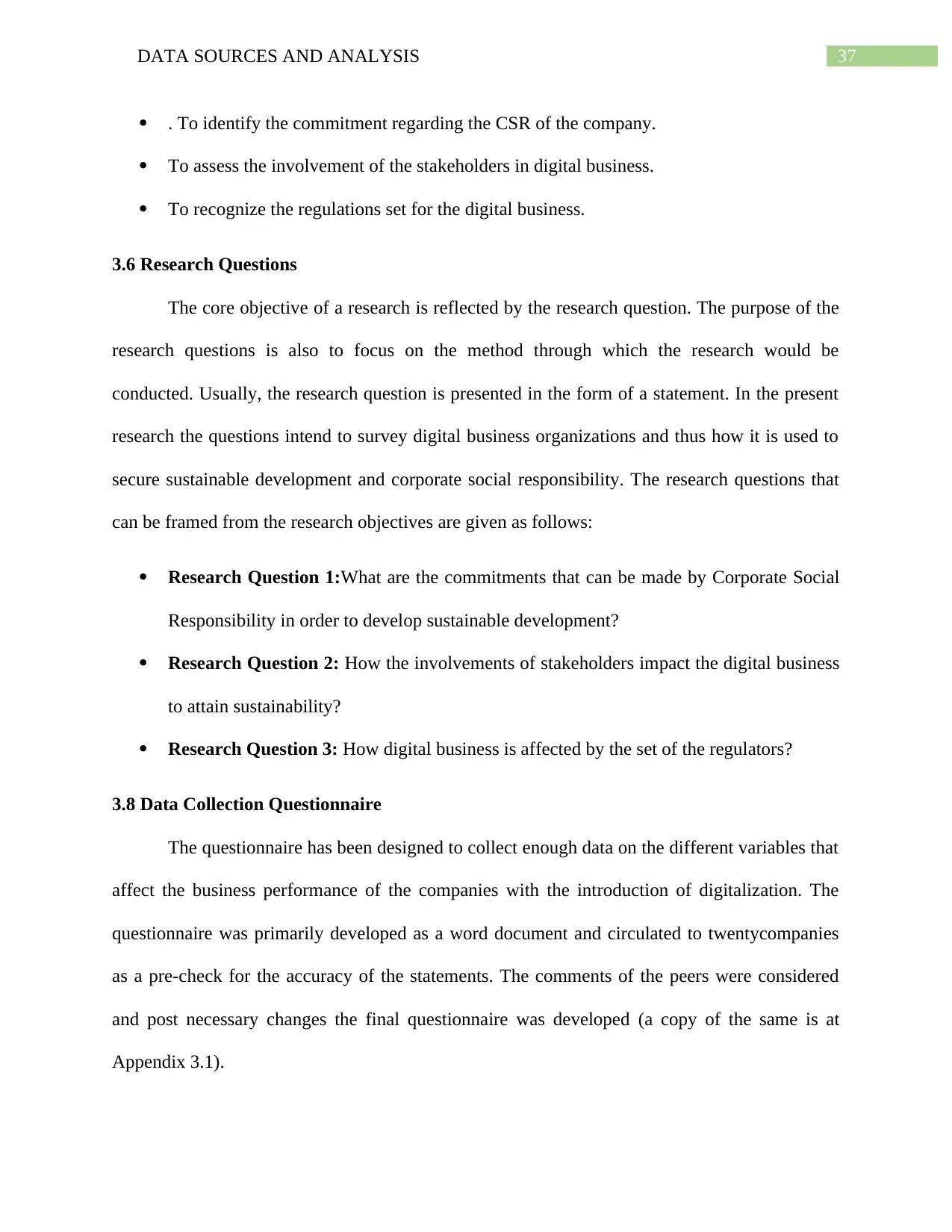
37DATA SOURCES AND ANALYSIS
. To identify the commitment regarding the CSR of the company.
To assess the involvement of the stakeholders in digital business.
To recognize the regulations set for the digital business.
3.6 Research Questions
The core objective of a research is reflected by the research question. The purpose of the
research questions is also to focus on the method through which the research would be
conducted. Usually, the research question is presented in the form of a statement. In the present
research the questions intend to survey digital business organizations and thus how it is used to
secure sustainable development and corporate social responsibility. The research questions that
can be framed from the research objectives are given as follows:
Research Question 1:What are the commitments that can be made by Corporate Social
Responsibility in order to develop sustainable development?
Research Question 2: How the involvements of stakeholders impact the digital business
to attain sustainability?
Research Question 3: How digital business is affected by the set of the regulators?
3.8 Data Collection Questionnaire
The questionnaire has been designed to collect enough data on the different variables that
affect the business performance of the companies with the introduction of digitalization. The
questionnaire was primarily developed as a word document and circulated to twentycompanies
as a pre-check for the accuracy of the statements. The comments of the peers were considered
and post necessary changes the final questionnaire was developed (a copy of the same is at
Appendix 3.1).
. To identify the commitment regarding the CSR of the company.
To assess the involvement of the stakeholders in digital business.
To recognize the regulations set for the digital business.
3.6 Research Questions
The core objective of a research is reflected by the research question. The purpose of the
research questions is also to focus on the method through which the research would be
conducted. Usually, the research question is presented in the form of a statement. In the present
research the questions intend to survey digital business organizations and thus how it is used to
secure sustainable development and corporate social responsibility. The research questions that
can be framed from the research objectives are given as follows:
Research Question 1:What are the commitments that can be made by Corporate Social
Responsibility in order to develop sustainable development?
Research Question 2: How the involvements of stakeholders impact the digital business
to attain sustainability?
Research Question 3: How digital business is affected by the set of the regulators?
3.8 Data Collection Questionnaire
The questionnaire has been designed to collect enough data on the different variables that
affect the business performance of the companies with the introduction of digitalization. The
questionnaire was primarily developed as a word document and circulated to twentycompanies
as a pre-check for the accuracy of the statements. The comments of the peers were considered
and post necessary changes the final questionnaire was developed (a copy of the same is at
Appendix 3.1).

38DATA SOURCES AND ANALYSIS
An introductory paragraph to the research question explained the purpose of the survey. It
also assured the respondents to the confidentiality of their information and views. The first
section of the research questionnaire concentrated on the commitment of the companies towards
the digitalization of the business strategies. The second section of the questionnaire focused on
the involvement of the stakeholders in the companies. The third and the final section of the
questionnaire involved the regulations involved in the business strategies towards digitalizing the
services provided by the companies. There were 10 questions in the questionnaire, five of them
belonged to the first part, three of them belonged to the second part and 2 of the questions were
from the third part of the questionnaire. The questions were to be answered in 5-point Likert
scale. In the Likert scale the responses are coded as 1 = Strongly disagree, 2 = disagree, 3 =
neutral, 4 = agree and 5 = strongly agree.
Table 3.1 Summarizes and illustrates the variables, their source and the number of
questions in each variable.
Table 3.1: Questionnaire Contents and References
Variables Number of
statements
Source
1 Commitment 5 Martínez&del Bosque (2013);
Parasuraman et al. (1988)
2 Stakeholders Involvement 3 Martínez& del Bosque (2013)
3 Regulation 2 Martínez&del Bosque (2013)
Total 10
An introductory paragraph to the research question explained the purpose of the survey. It
also assured the respondents to the confidentiality of their information and views. The first
section of the research questionnaire concentrated on the commitment of the companies towards
the digitalization of the business strategies. The second section of the questionnaire focused on
the involvement of the stakeholders in the companies. The third and the final section of the
questionnaire involved the regulations involved in the business strategies towards digitalizing the
services provided by the companies. There were 10 questions in the questionnaire, five of them
belonged to the first part, three of them belonged to the second part and 2 of the questions were
from the third part of the questionnaire. The questions were to be answered in 5-point Likert
scale. In the Likert scale the responses are coded as 1 = Strongly disagree, 2 = disagree, 3 =
neutral, 4 = agree and 5 = strongly agree.
Table 3.1 Summarizes and illustrates the variables, their source and the number of
questions in each variable.
Table 3.1: Questionnaire Contents and References
Variables Number of
statements
Source
1 Commitment 5 Martínez&del Bosque (2013);
Parasuraman et al. (1988)
2 Stakeholders Involvement 3 Martínez& del Bosque (2013)
3 Regulation 2 Martínez&del Bosque (2013)
Total 10
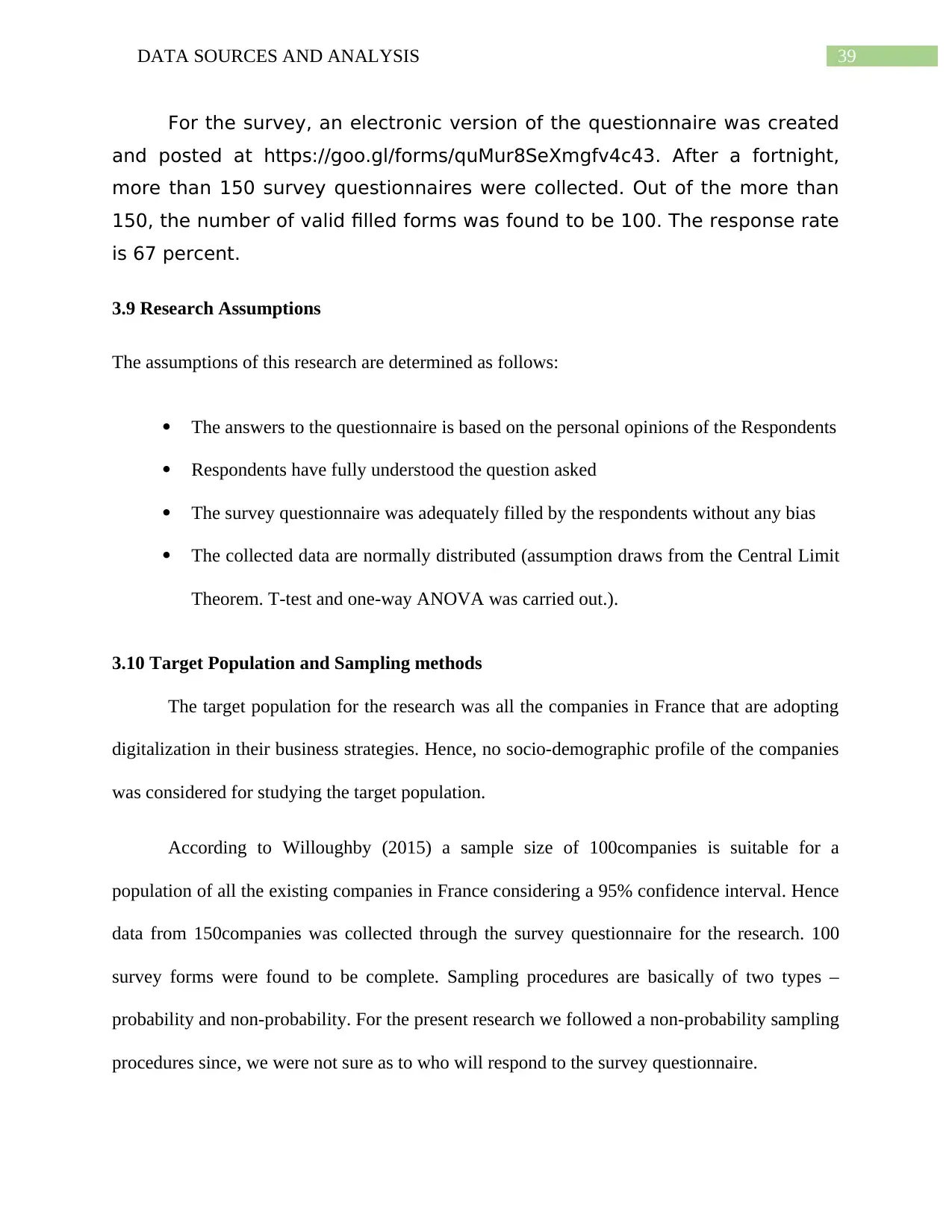
39DATA SOURCES AND ANALYSIS
For the survey, an electronic version of the questionnaire was created
and posted at https://goo.gl/forms/quMur8SeXmgfv4c43. After a fortnight,
more than 150 survey questionnaires were collected. Out of the more than
150, the number of valid filled forms was found to be 100. The response rate
is 67 percent.
3.9 Research Assumptions
The assumptions of this research are determined as follows:
The answers to the questionnaire is based on the personal opinions of the Respondents
Respondents have fully understood the question asked
The survey questionnaire was adequately filled by the respondents without any bias
The collected data are normally distributed (assumption draws from the Central Limit
Theorem. T-test and one-way ANOVA was carried out.).
3.10 Target Population and Sampling methods
The target population for the research was all the companies in France that are adopting
digitalization in their business strategies. Hence, no socio-demographic profile of the companies
was considered for studying the target population.
According to Willoughby (2015) a sample size of 100companies is suitable for a
population of all the existing companies in France considering a 95% confidence interval. Hence
data from 150companies was collected through the survey questionnaire for the research. 100
survey forms were found to be complete. Sampling procedures are basically of two types –
probability and non-probability. For the present research we followed a non-probability sampling
procedures since, we were not sure as to who will respond to the survey questionnaire.
For the survey, an electronic version of the questionnaire was created
and posted at https://goo.gl/forms/quMur8SeXmgfv4c43. After a fortnight,
more than 150 survey questionnaires were collected. Out of the more than
150, the number of valid filled forms was found to be 100. The response rate
is 67 percent.
3.9 Research Assumptions
The assumptions of this research are determined as follows:
The answers to the questionnaire is based on the personal opinions of the Respondents
Respondents have fully understood the question asked
The survey questionnaire was adequately filled by the respondents without any bias
The collected data are normally distributed (assumption draws from the Central Limit
Theorem. T-test and one-way ANOVA was carried out.).
3.10 Target Population and Sampling methods
The target population for the research was all the companies in France that are adopting
digitalization in their business strategies. Hence, no socio-demographic profile of the companies
was considered for studying the target population.
According to Willoughby (2015) a sample size of 100companies is suitable for a
population of all the existing companies in France considering a 95% confidence interval. Hence
data from 150companies was collected through the survey questionnaire for the research. 100
survey forms were found to be complete. Sampling procedures are basically of two types –
probability and non-probability. For the present research we followed a non-probability sampling
procedures since, we were not sure as to who will respond to the survey questionnaire.
Secure Best Marks with AI Grader
Need help grading? Try our AI Grader for instant feedback on your assignments.
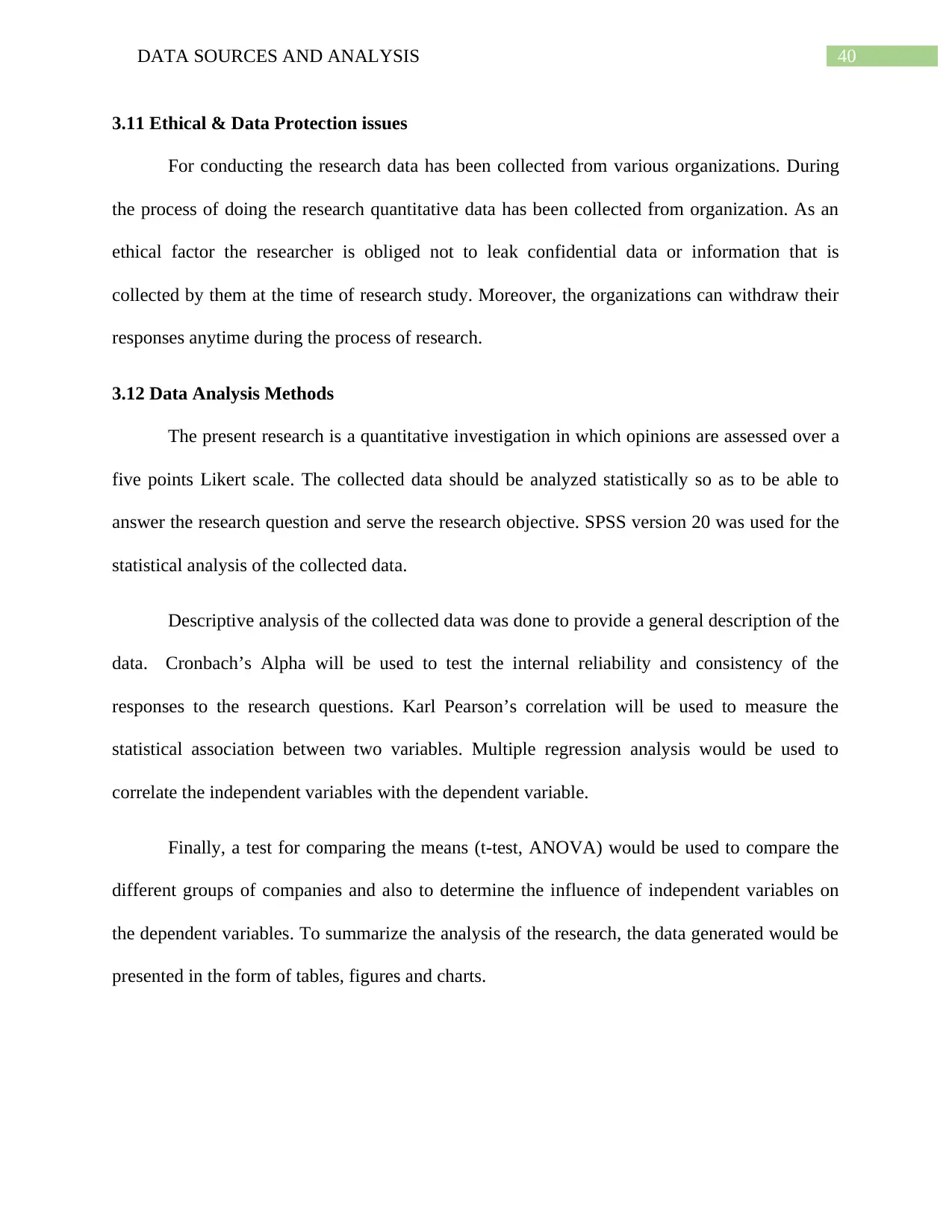
40DATA SOURCES AND ANALYSIS
3.11 Ethical & Data Protection issues
For conducting the research data has been collected from various organizations. During
the process of doing the research quantitative data has been collected from organization. As an
ethical factor the researcher is obliged not to leak confidential data or information that is
collected by them at the time of research study. Moreover, the organizations can withdraw their
responses anytime during the process of research.
3.12 Data Analysis Methods
The present research is a quantitative investigation in which opinions are assessed over a
five points Likert scale. The collected data should be analyzed statistically so as to be able to
answer the research question and serve the research objective. SPSS version 20 was used for the
statistical analysis of the collected data.
Descriptive analysis of the collected data was done to provide a general description of the
data. Cronbach’s Alpha will be used to test the internal reliability and consistency of the
responses to the research questions. Karl Pearson’s correlation will be used to measure the
statistical association between two variables. Multiple regression analysis would be used to
correlate the independent variables with the dependent variable.
Finally, a test for comparing the means (t-test, ANOVA) would be used to compare the
different groups of companies and also to determine the influence of independent variables on
the dependent variables. To summarize the analysis of the research, the data generated would be
presented in the form of tables, figures and charts.
3.11 Ethical & Data Protection issues
For conducting the research data has been collected from various organizations. During
the process of doing the research quantitative data has been collected from organization. As an
ethical factor the researcher is obliged not to leak confidential data or information that is
collected by them at the time of research study. Moreover, the organizations can withdraw their
responses anytime during the process of research.
3.12 Data Analysis Methods
The present research is a quantitative investigation in which opinions are assessed over a
five points Likert scale. The collected data should be analyzed statistically so as to be able to
answer the research question and serve the research objective. SPSS version 20 was used for the
statistical analysis of the collected data.
Descriptive analysis of the collected data was done to provide a general description of the
data. Cronbach’s Alpha will be used to test the internal reliability and consistency of the
responses to the research questions. Karl Pearson’s correlation will be used to measure the
statistical association between two variables. Multiple regression analysis would be used to
correlate the independent variables with the dependent variable.
Finally, a test for comparing the means (t-test, ANOVA) would be used to compare the
different groups of companies and also to determine the influence of independent variables on
the dependent variables. To summarize the analysis of the research, the data generated would be
presented in the form of tables, figures and charts.
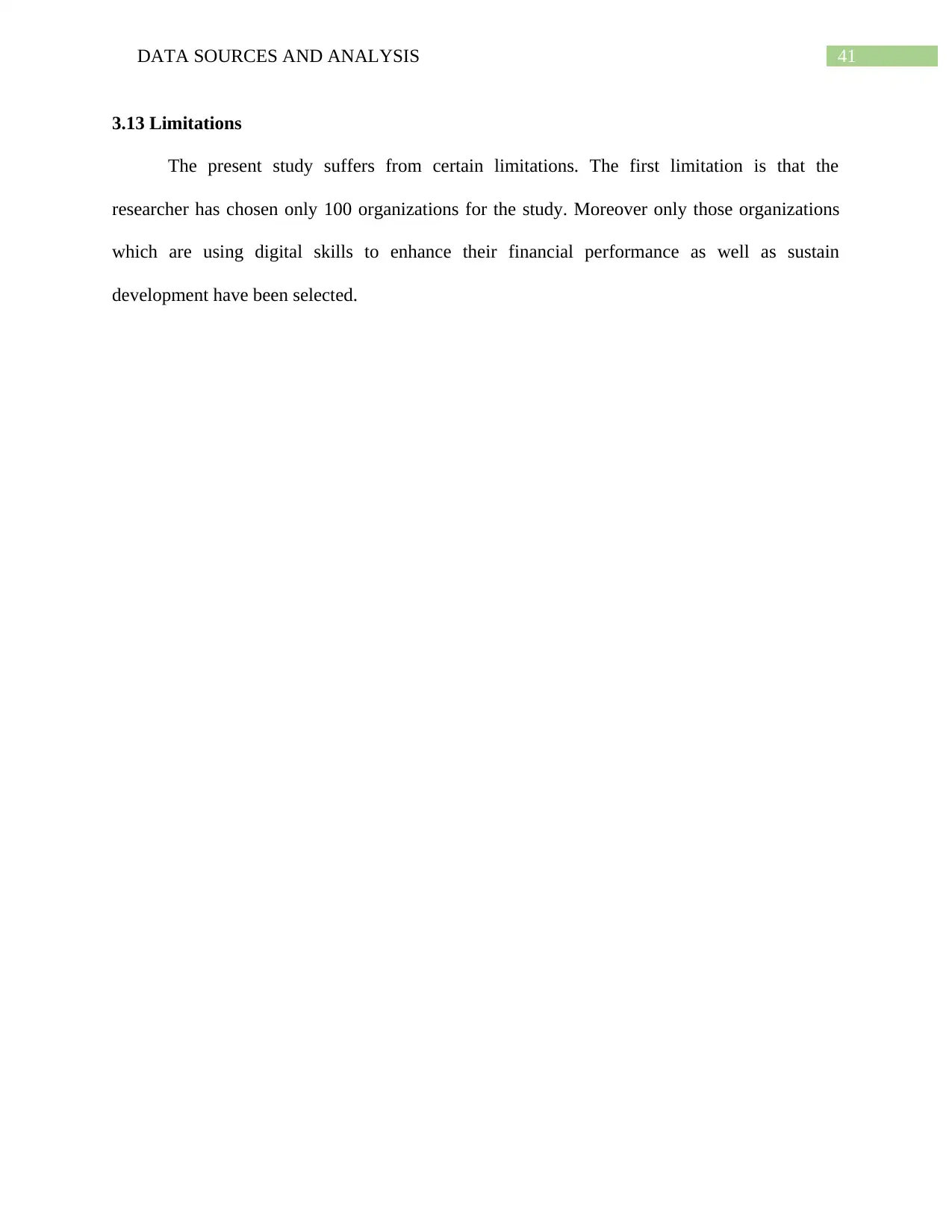
41DATA SOURCES AND ANALYSIS
3.13 Limitations
The present study suffers from certain limitations. The first limitation is that the
researcher has chosen only 100 organizations for the study. Moreover only those organizations
which are using digital skills to enhance their financial performance as well as sustain
development have been selected.
3.13 Limitations
The present study suffers from certain limitations. The first limitation is that the
researcher has chosen only 100 organizations for the study. Moreover only those organizations
which are using digital skills to enhance their financial performance as well as sustain
development have been selected.
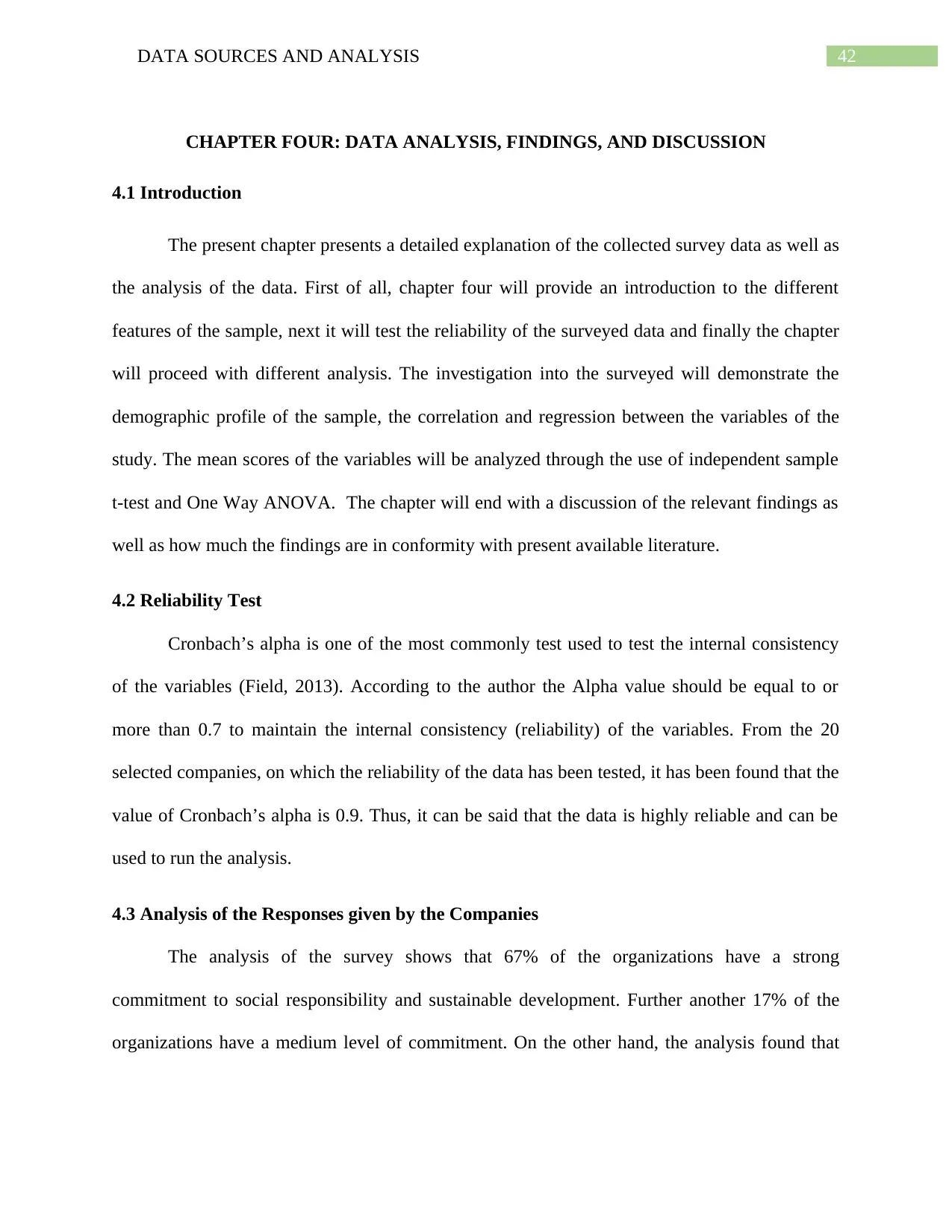
42DATA SOURCES AND ANALYSIS
CHAPTER FOUR: DATA ANALYSIS, FINDINGS, AND DISCUSSION
4.1 Introduction
The present chapter presents a detailed explanation of the collected survey data as well as
the analysis of the data. First of all, chapter four will provide an introduction to the different
features of the sample, next it will test the reliability of the surveyed data and finally the chapter
will proceed with different analysis. The investigation into the surveyed will demonstrate the
demographic profile of the sample, the correlation and regression between the variables of the
study. The mean scores of the variables will be analyzed through the use of independent sample
t-test and One Way ANOVA. The chapter will end with a discussion of the relevant findings as
well as how much the findings are in conformity with present available literature.
4.2 Reliability Test
Cronbach’s alpha is one of the most commonly test used to test the internal consistency
of the variables (Field, 2013). According to the author the Alpha value should be equal to or
more than 0.7 to maintain the internal consistency (reliability) of the variables. From the 20
selected companies, on which the reliability of the data has been tested, it has been found that the
value of Cronbach’s alpha is 0.9. Thus, it can be said that the data is highly reliable and can be
used to run the analysis.
4.3 Analysis of the Responses given by the Companies
The analysis of the survey shows that 67% of the organizations have a strong
commitment to social responsibility and sustainable development. Further another 17% of the
organizations have a medium level of commitment. On the other hand, the analysis found that
CHAPTER FOUR: DATA ANALYSIS, FINDINGS, AND DISCUSSION
4.1 Introduction
The present chapter presents a detailed explanation of the collected survey data as well as
the analysis of the data. First of all, chapter four will provide an introduction to the different
features of the sample, next it will test the reliability of the surveyed data and finally the chapter
will proceed with different analysis. The investigation into the surveyed will demonstrate the
demographic profile of the sample, the correlation and regression between the variables of the
study. The mean scores of the variables will be analyzed through the use of independent sample
t-test and One Way ANOVA. The chapter will end with a discussion of the relevant findings as
well as how much the findings are in conformity with present available literature.
4.2 Reliability Test
Cronbach’s alpha is one of the most commonly test used to test the internal consistency
of the variables (Field, 2013). According to the author the Alpha value should be equal to or
more than 0.7 to maintain the internal consistency (reliability) of the variables. From the 20
selected companies, on which the reliability of the data has been tested, it has been found that the
value of Cronbach’s alpha is 0.9. Thus, it can be said that the data is highly reliable and can be
used to run the analysis.
4.3 Analysis of the Responses given by the Companies
The analysis of the survey shows that 67% of the organizations have a strong
commitment to social responsibility and sustainable development. Further another 17% of the
organizations have a medium level of commitment. On the other hand, the analysis found that
Paraphrase This Document
Need a fresh take? Get an instant paraphrase of this document with our AI Paraphraser
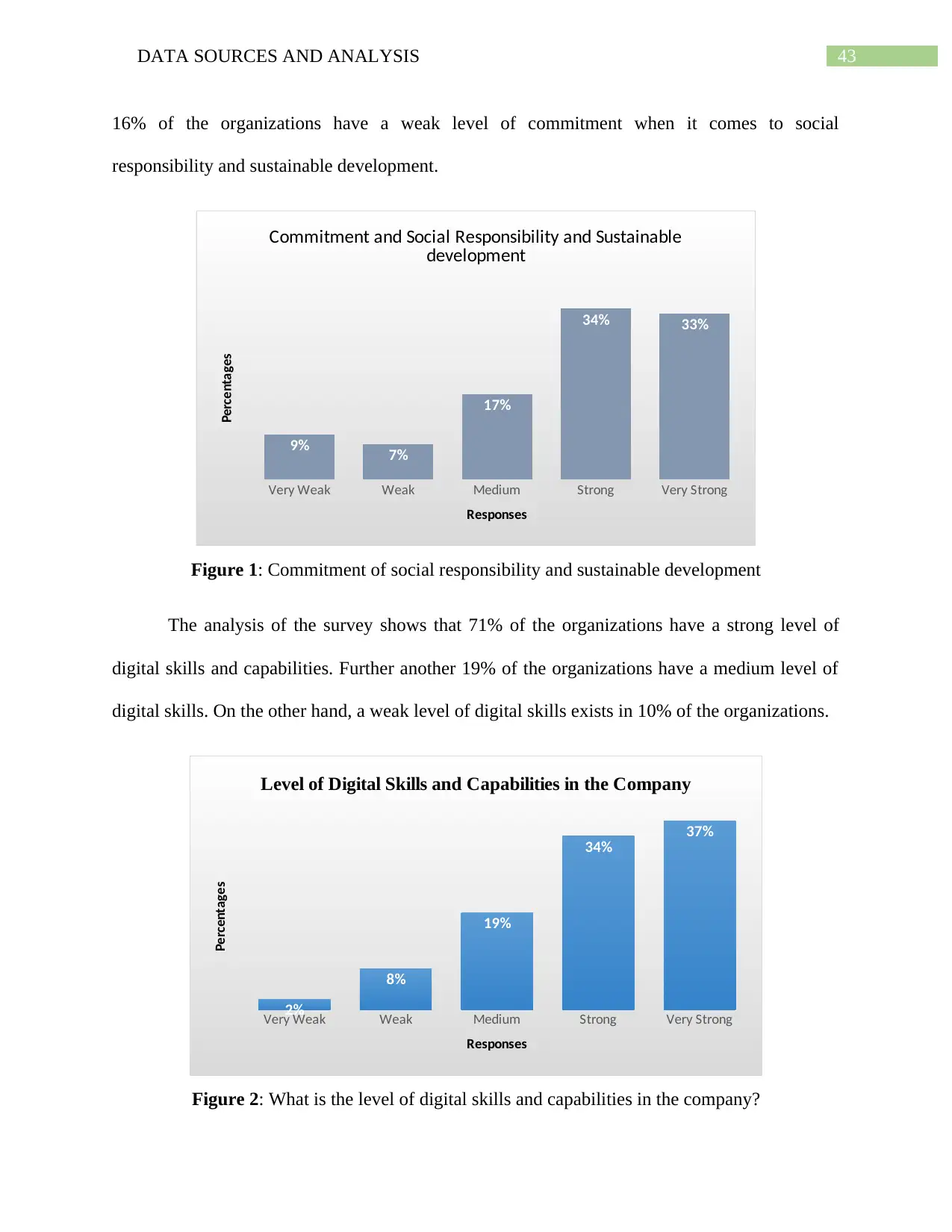
43DATA SOURCES AND ANALYSIS
16% of the organizations have a weak level of commitment when it comes to social
responsibility and sustainable development.
Very Weak Weak Medium Strong Very Strong
9% 7%
17%
34% 33%
Commitment and Social Responsibility and Sustainable
development
Responses
Percentages
Figure 1: Commitment of social responsibility and sustainable development
The analysis of the survey shows that 71% of the organizations have a strong level of
digital skills and capabilities. Further another 19% of the organizations have a medium level of
digital skills. On the other hand, a weak level of digital skills exists in 10% of the organizations.
Very Weak Weak Medium Strong Very Strong
2%
8%
19%
34% 37%
Level of Digital Skills and Capabilities in the Company
Responses
Percentages
Figure 2: What is the level of digital skills and capabilities in the company?
16% of the organizations have a weak level of commitment when it comes to social
responsibility and sustainable development.
Very Weak Weak Medium Strong Very Strong
9% 7%
17%
34% 33%
Commitment and Social Responsibility and Sustainable
development
Responses
Percentages
Figure 1: Commitment of social responsibility and sustainable development
The analysis of the survey shows that 71% of the organizations have a strong level of
digital skills and capabilities. Further another 19% of the organizations have a medium level of
digital skills. On the other hand, a weak level of digital skills exists in 10% of the organizations.
Very Weak Weak Medium Strong Very Strong
2%
8%
19%
34% 37%
Level of Digital Skills and Capabilities in the Company
Responses
Percentages
Figure 2: What is the level of digital skills and capabilities in the company?

44DATA SOURCES AND ANALYSIS
From the analysis of the survey it is found that 55% of the organizations have a strong
commitment to deal with sustainable development and CSR. Further another 23% of the
organizations have a medium level of commitment. On the other hand, the commitment level
towards sustainable development and CSR is weak in 21% of the organizations.
Very Weak Weak Medium Strong Very Strong
4%
17%
23% 25%
30%
Place of Digital Strategy from Commitment to Deals
Responses
Percentages
Figure 3: Place of digital strategy from commitment to deals
From the study of the survey it is found that 67% of the organizations have very easily
adapted to change and disruption. Further another 21% of the organizations have a medium level
of adaptation. On the other hand, the adaptation towards change is weak in 10% of the
organizations.
From the analysis of the survey it is found that 55% of the organizations have a strong
commitment to deal with sustainable development and CSR. Further another 23% of the
organizations have a medium level of commitment. On the other hand, the commitment level
towards sustainable development and CSR is weak in 21% of the organizations.
Very Weak Weak Medium Strong Very Strong
4%
17%
23% 25%
30%
Place of Digital Strategy from Commitment to Deals
Responses
Percentages
Figure 3: Place of digital strategy from commitment to deals
From the study of the survey it is found that 67% of the organizations have very easily
adapted to change and disruption. Further another 21% of the organizations have a medium level
of adaptation. On the other hand, the adaptation towards change is weak in 10% of the
organizations.
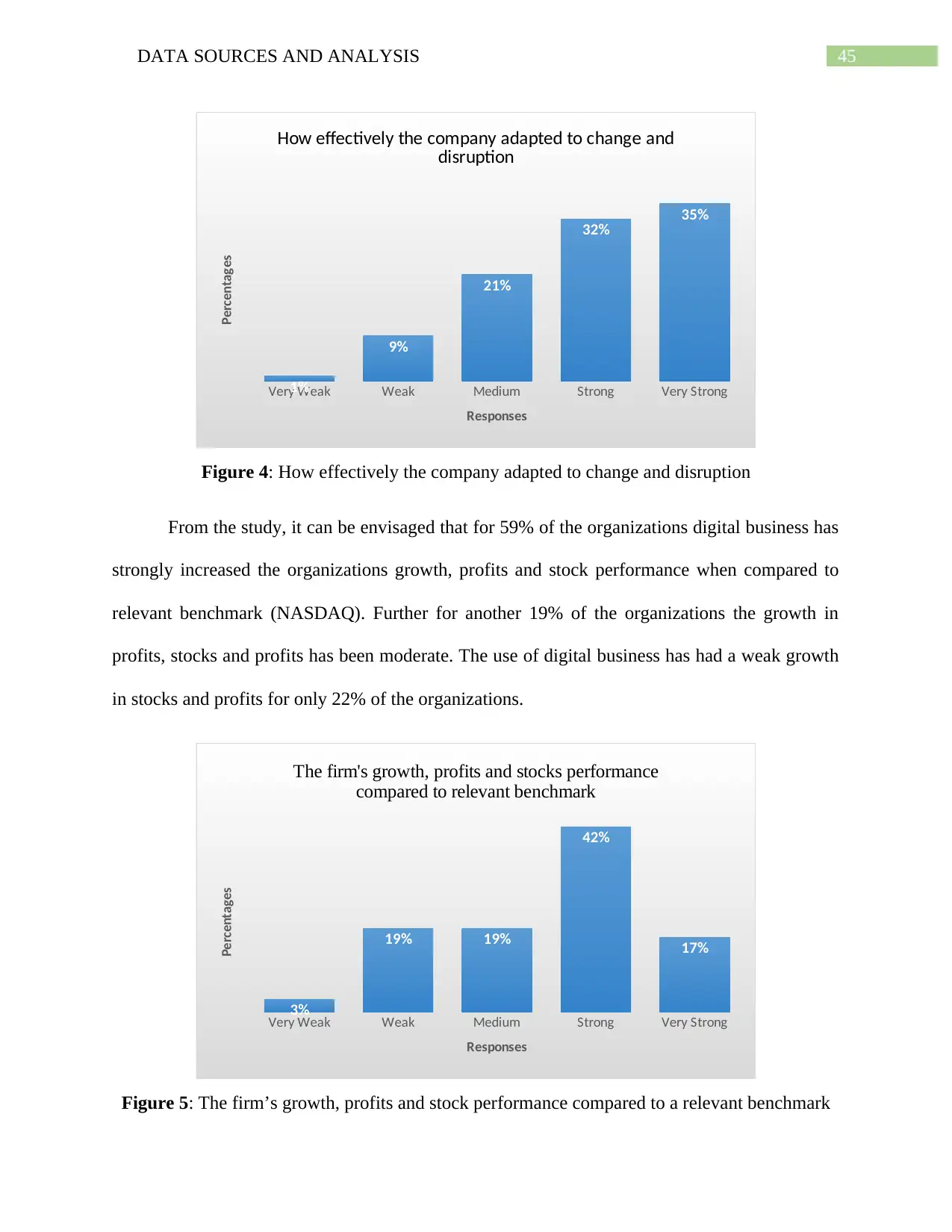
45DATA SOURCES AND ANALYSIS
Very Weak Weak Medium Strong Very Strong1%
9%
21%
32% 35%
How effectively the company adapted to change and
disruption
Responses
Percentages
Figure 4: How effectively the company adapted to change and disruption
From the study, it can be envisaged that for 59% of the organizations digital business has
strongly increased the organizations growth, profits and stock performance when compared to
relevant benchmark (NASDAQ). Further for another 19% of the organizations the growth in
profits, stocks and profits has been moderate. The use of digital business has had a weak growth
in stocks and profits for only 22% of the organizations.
Very Weak Weak Medium Strong Very Strong
3%
19% 19%
42%
17%
The firm's growth, profits and stocks performance
compared to relevant benchmark
Responses
Percentages
Figure 5: The firm’s growth, profits and stock performance compared to a relevant benchmark
Very Weak Weak Medium Strong Very Strong1%
9%
21%
32% 35%
How effectively the company adapted to change and
disruption
Responses
Percentages
Figure 4: How effectively the company adapted to change and disruption
From the study, it can be envisaged that for 59% of the organizations digital business has
strongly increased the organizations growth, profits and stock performance when compared to
relevant benchmark (NASDAQ). Further for another 19% of the organizations the growth in
profits, stocks and profits has been moderate. The use of digital business has had a weak growth
in stocks and profits for only 22% of the organizations.
Very Weak Weak Medium Strong Very Strong
3%
19% 19%
42%
17%
The firm's growth, profits and stocks performance
compared to relevant benchmark
Responses
Percentages
Figure 5: The firm’s growth, profits and stock performance compared to a relevant benchmark
Secure Best Marks with AI Grader
Need help grading? Try our AI Grader for instant feedback on your assignments.
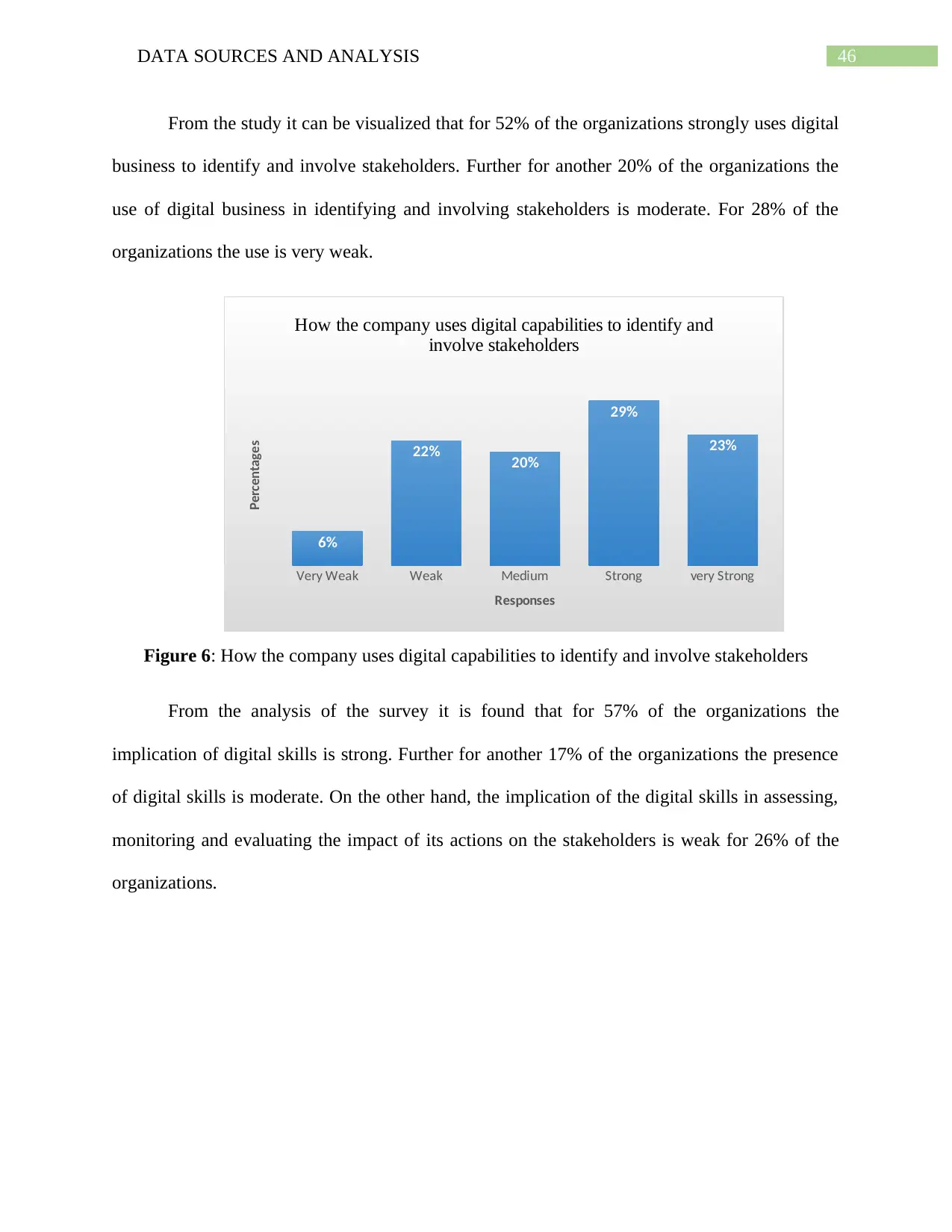
46DATA SOURCES AND ANALYSIS
From the study it can be visualized that for 52% of the organizations strongly uses digital
business to identify and involve stakeholders. Further for another 20% of the organizations the
use of digital business in identifying and involving stakeholders is moderate. For 28% of the
organizations the use is very weak.
Very Weak Weak Medium Strong very Strong
6%
22% 20%
29%
23%
How the company uses digital capabilities to identify and
involve stakeholders
Responses
Percentages
Figure 6: How the company uses digital capabilities to identify and involve stakeholders
From the analysis of the survey it is found that for 57% of the organizations the
implication of digital skills is strong. Further for another 17% of the organizations the presence
of digital skills is moderate. On the other hand, the implication of the digital skills in assessing,
monitoring and evaluating the impact of its actions on the stakeholders is weak for 26% of the
organizations.
From the study it can be visualized that for 52% of the organizations strongly uses digital
business to identify and involve stakeholders. Further for another 20% of the organizations the
use of digital business in identifying and involving stakeholders is moderate. For 28% of the
organizations the use is very weak.
Very Weak Weak Medium Strong very Strong
6%
22% 20%
29%
23%
How the company uses digital capabilities to identify and
involve stakeholders
Responses
Percentages
Figure 6: How the company uses digital capabilities to identify and involve stakeholders
From the analysis of the survey it is found that for 57% of the organizations the
implication of digital skills is strong. Further for another 17% of the organizations the presence
of digital skills is moderate. On the other hand, the implication of the digital skills in assessing,
monitoring and evaluating the impact of its actions on the stakeholders is weak for 26% of the
organizations.
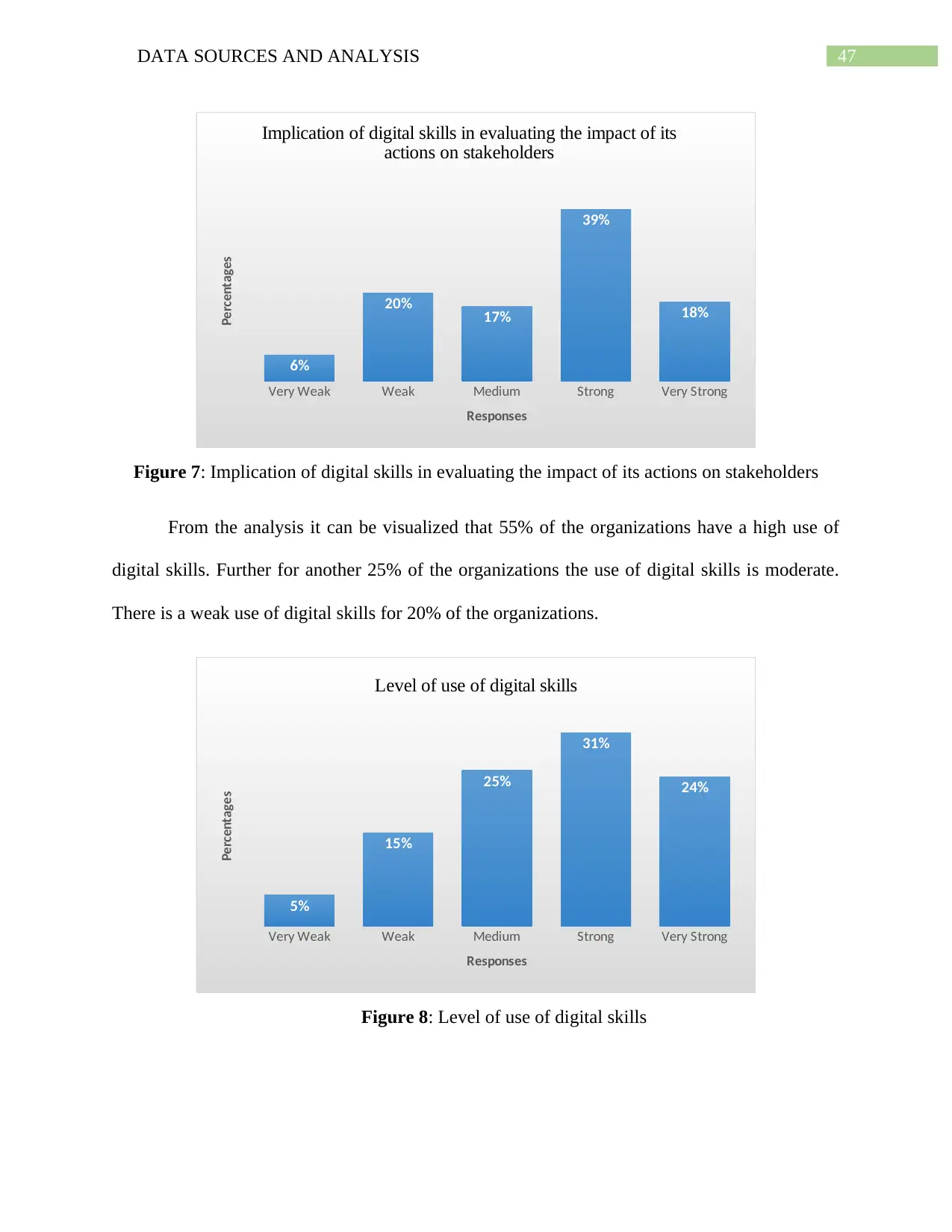
47DATA SOURCES AND ANALYSIS
Very Weak Weak Medium Strong Very Strong
6%
20% 17%
39%
18%
Implication of digital skills in evaluating the impact of its
actions on stakeholders
Responses
Percentages
Figure 7: Implication of digital skills in evaluating the impact of its actions on stakeholders
From the analysis it can be visualized that 55% of the organizations have a high use of
digital skills. Further for another 25% of the organizations the use of digital skills is moderate.
There is a weak use of digital skills for 20% of the organizations.
Very Weak Weak Medium Strong Very Strong
5%
15%
25%
31%
24%
Level of use of digital skills
Responses
Percentages
Figure 8: Level of use of digital skills
Very Weak Weak Medium Strong Very Strong
6%
20% 17%
39%
18%
Implication of digital skills in evaluating the impact of its
actions on stakeholders
Responses
Percentages
Figure 7: Implication of digital skills in evaluating the impact of its actions on stakeholders
From the analysis it can be visualized that 55% of the organizations have a high use of
digital skills. Further for another 25% of the organizations the use of digital skills is moderate.
There is a weak use of digital skills for 20% of the organizations.
Very Weak Weak Medium Strong Very Strong
5%
15%
25%
31%
24%
Level of use of digital skills
Responses
Percentages
Figure 8: Level of use of digital skills

48DATA SOURCES AND ANALYSIS
The analysis of the survey data shows that there is a strong importance for digital
business to address policy misalignments in 53% of the organizations. Further for another 27%
of the organizations the importance of digital business for policy misalignments is moderate.
Very Weak Weak Medium Strong Very strong
5%
15%
27%
31%
22%
Digital has an important place in strategies to address policy
misalignments
Responses
Percentages
Figure 9: Digital has an important place in strategies to address policy misalignments
From the analysis of the survey it is found that 54% of the organizations view digital
business regulations to be strong in managing overall reputation. Further, another 24% of the
organizations the regulations have a moderate impact. On the other hand, 12% of the
organizations have a weak overall reputation in managing their digital business.
The analysis of the survey data shows that there is a strong importance for digital
business to address policy misalignments in 53% of the organizations. Further for another 27%
of the organizations the importance of digital business for policy misalignments is moderate.
Very Weak Weak Medium Strong Very strong
5%
15%
27%
31%
22%
Digital has an important place in strategies to address policy
misalignments
Responses
Percentages
Figure 9: Digital has an important place in strategies to address policy misalignments
From the analysis of the survey it is found that 54% of the organizations view digital
business regulations to be strong in managing overall reputation. Further, another 24% of the
organizations the regulations have a moderate impact. On the other hand, 12% of the
organizations have a weak overall reputation in managing their digital business.
Paraphrase This Document
Need a fresh take? Get an instant paraphrase of this document with our AI Paraphraser
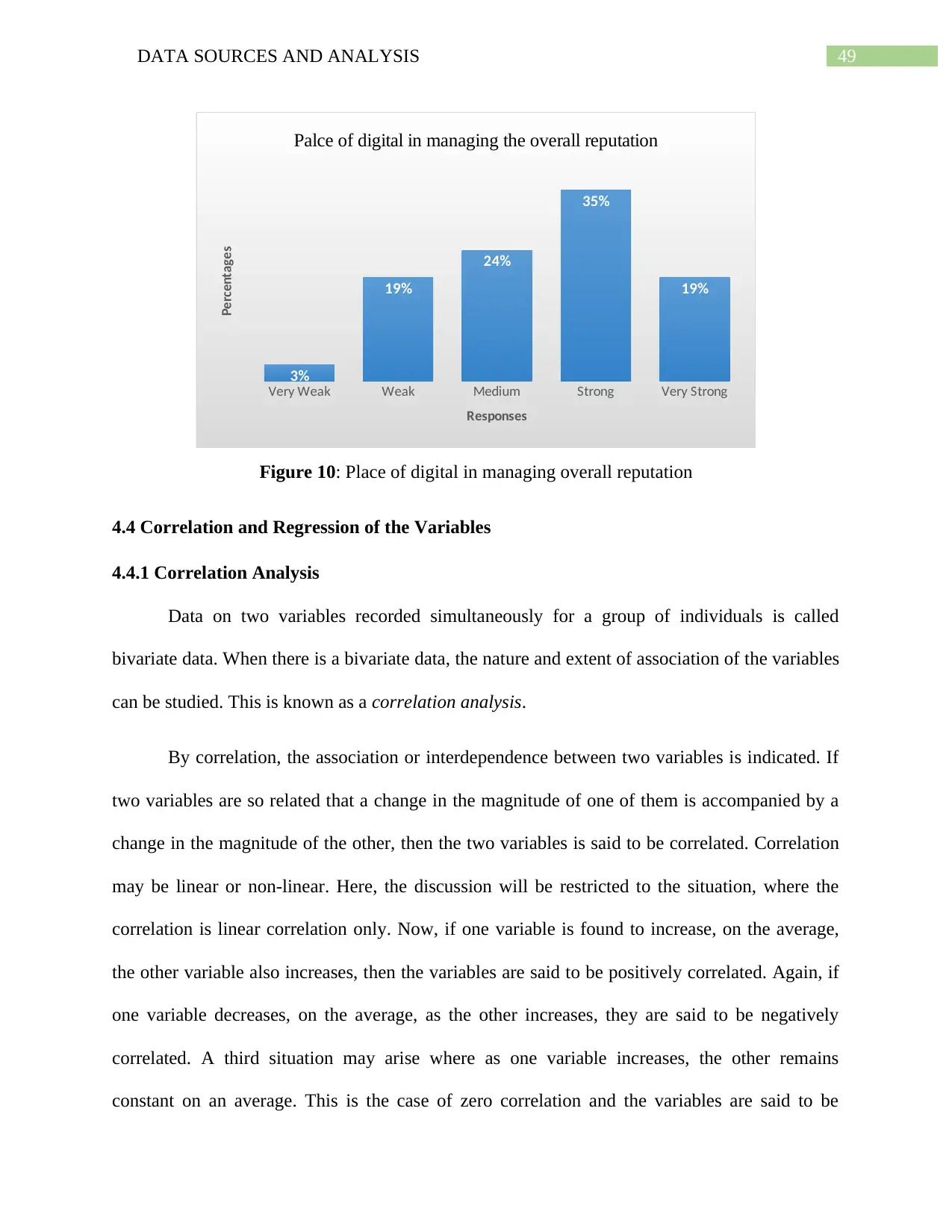
49DATA SOURCES AND ANALYSIS
Very Weak Weak Medium Strong Very Strong
3%
19%
24%
35%
19%
Palce of digital in managing the overall reputation
Responses
Percentages
Figure 10: Place of digital in managing overall reputation
4.4 Correlation and Regression of the Variables
4.4.1 Correlation Analysis
Data on two variables recorded simultaneously for a group of individuals is called
bivariate data. When there is a bivariate data, the nature and extent of association of the variables
can be studied. This is known as a correlation analysis.
By correlation, the association or interdependence between two variables is indicated. If
two variables are so related that a change in the magnitude of one of them is accompanied by a
change in the magnitude of the other, then the two variables is said to be correlated. Correlation
may be linear or non-linear. Here, the discussion will be restricted to the situation, where the
correlation is linear correlation only. Now, if one variable is found to increase, on the average,
the other variable also increases, then the variables are said to be positively correlated. Again, if
one variable decreases, on the average, as the other increases, they are said to be negatively
correlated. A third situation may arise where as one variable increases, the other remains
constant on an average. This is the case of zero correlation and the variables are said to be
Very Weak Weak Medium Strong Very Strong
3%
19%
24%
35%
19%
Palce of digital in managing the overall reputation
Responses
Percentages
Figure 10: Place of digital in managing overall reputation
4.4 Correlation and Regression of the Variables
4.4.1 Correlation Analysis
Data on two variables recorded simultaneously for a group of individuals is called
bivariate data. When there is a bivariate data, the nature and extent of association of the variables
can be studied. This is known as a correlation analysis.
By correlation, the association or interdependence between two variables is indicated. If
two variables are so related that a change in the magnitude of one of them is accompanied by a
change in the magnitude of the other, then the two variables is said to be correlated. Correlation
may be linear or non-linear. Here, the discussion will be restricted to the situation, where the
correlation is linear correlation only. Now, if one variable is found to increase, on the average,
the other variable also increases, then the variables are said to be positively correlated. Again, if
one variable decreases, on the average, as the other increases, they are said to be negatively
correlated. A third situation may arise where as one variable increases, the other remains
constant on an average. This is the case of zero correlation and the variables are said to be
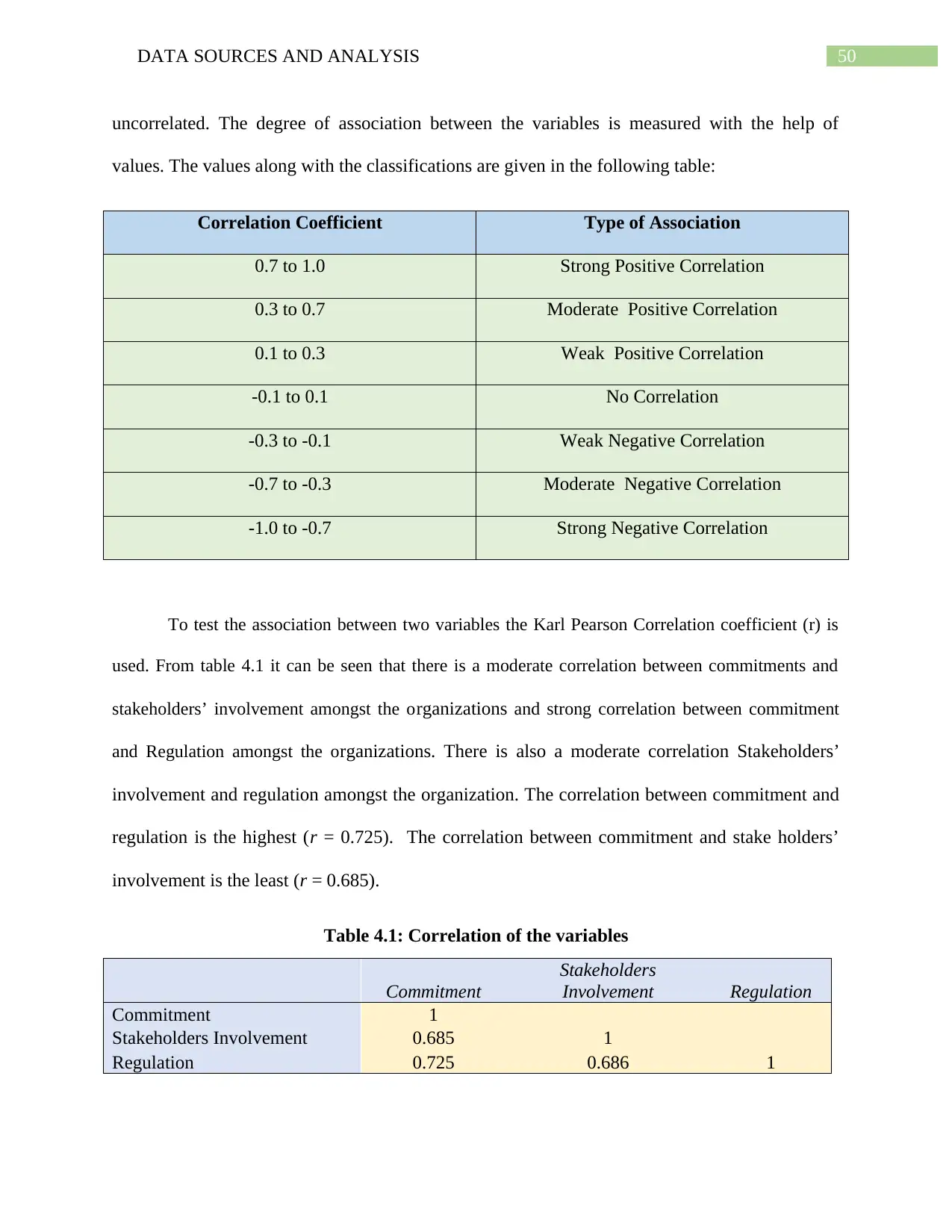
50DATA SOURCES AND ANALYSIS
uncorrelated. The degree of association between the variables is measured with the help of
values. The values along with the classifications are given in the following table:
Correlation Coefficient Type of Association
0.7 to 1.0 Strong Positive Correlation
0.3 to 0.7 Moderate Positive Correlation
0.1 to 0.3 Weak Positive Correlation
-0.1 to 0.1 No Correlation
-0.3 to -0.1 Weak Negative Correlation
-0.7 to -0.3 Moderate Negative Correlation
-1.0 to -0.7 Strong Negative Correlation
To test the association between two variables the Karl Pearson Correlation coefficient (r) is
used. From table 4.1 it can be seen that there is a moderate correlation between commitments and
stakeholders’ involvement amongst the organizations and strong correlation between commitment
and Regulation amongst the organizations. There is also a moderate correlation Stakeholders’
involvement and regulation amongst the organization. The correlation between commitment and
regulation is the highest (r = 0.725). The correlation between commitment and stake holders’
involvement is the least (r = 0.685).
Table 4.1: Correlation of the variables
Commitment
Stakeholders
Involvement Regulation
Commitment 1
Stakeholders Involvement 0.685 1
Regulation 0.725 0.686 1
uncorrelated. The degree of association between the variables is measured with the help of
values. The values along with the classifications are given in the following table:
Correlation Coefficient Type of Association
0.7 to 1.0 Strong Positive Correlation
0.3 to 0.7 Moderate Positive Correlation
0.1 to 0.3 Weak Positive Correlation
-0.1 to 0.1 No Correlation
-0.3 to -0.1 Weak Negative Correlation
-0.7 to -0.3 Moderate Negative Correlation
-1.0 to -0.7 Strong Negative Correlation
To test the association between two variables the Karl Pearson Correlation coefficient (r) is
used. From table 4.1 it can be seen that there is a moderate correlation between commitments and
stakeholders’ involvement amongst the organizations and strong correlation between commitment
and Regulation amongst the organizations. There is also a moderate correlation Stakeholders’
involvement and regulation amongst the organization. The correlation between commitment and
regulation is the highest (r = 0.725). The correlation between commitment and stake holders’
involvement is the least (r = 0.685).
Table 4.1: Correlation of the variables
Commitment
Stakeholders
Involvement Regulation
Commitment 1
Stakeholders Involvement 0.685 1
Regulation 0.725 0.686 1

51DATA SOURCES AND ANALYSIS
4.4.2 Regression Analysis
In case of bivariate data, if the variables are found to be associated, then one of the
variables can be expressed as a mathematical function of the other variables. The first variable
mentioned here is regarded as the dependent variable or the response variable and the other
variables mentioned here are the independent variables or the explanatory variables.
In this case, regulation has been considered as the response or dependent variable and
commitment and the involvement of the stakeholders have been considered as the independent
variable or the explanatory variable. From the results of the analysis given in table 4.2, it can be
seen clearly that the explanatory variables can explain 58.8 percent (R Square value) of the
response variable regulations. Again from the ANOVA table given in table 4.3, it can be seen
that the significance F value is 0.000 which is less than the 95 percent level of significance
(0.05). This indicates that the variables are significant to each other.
The relationship between the three variables can be given by the following mathematical
equation that has been obtained from the values of the coefficients given in table 4.4.
Regulations = 0.595 + (0.458 * Commitment) + (0.329 * Stake Holders’ Involvement)
Table 4.2: Regression Statistics
Multiple R 0.767
R Square 0.588
Adjusted R Square 0.579
Standard Error 0.653
Observations 100
Table 4.3: ANOVA Table
df SS MS F Significance F
Regression 2 59.067 29.533 69.158 0.000
Residual 97 41.423 0.427
4.4.2 Regression Analysis
In case of bivariate data, if the variables are found to be associated, then one of the
variables can be expressed as a mathematical function of the other variables. The first variable
mentioned here is regarded as the dependent variable or the response variable and the other
variables mentioned here are the independent variables or the explanatory variables.
In this case, regulation has been considered as the response or dependent variable and
commitment and the involvement of the stakeholders have been considered as the independent
variable or the explanatory variable. From the results of the analysis given in table 4.2, it can be
seen clearly that the explanatory variables can explain 58.8 percent (R Square value) of the
response variable regulations. Again from the ANOVA table given in table 4.3, it can be seen
that the significance F value is 0.000 which is less than the 95 percent level of significance
(0.05). This indicates that the variables are significant to each other.
The relationship between the three variables can be given by the following mathematical
equation that has been obtained from the values of the coefficients given in table 4.4.
Regulations = 0.595 + (0.458 * Commitment) + (0.329 * Stake Holders’ Involvement)
Table 4.2: Regression Statistics
Multiple R 0.767
R Square 0.588
Adjusted R Square 0.579
Standard Error 0.653
Observations 100
Table 4.3: ANOVA Table
df SS MS F Significance F
Regression 2 59.067 29.533 69.158 0.000
Residual 97 41.423 0.427
Secure Best Marks with AI Grader
Need help grading? Try our AI Grader for instant feedback on your assignments.
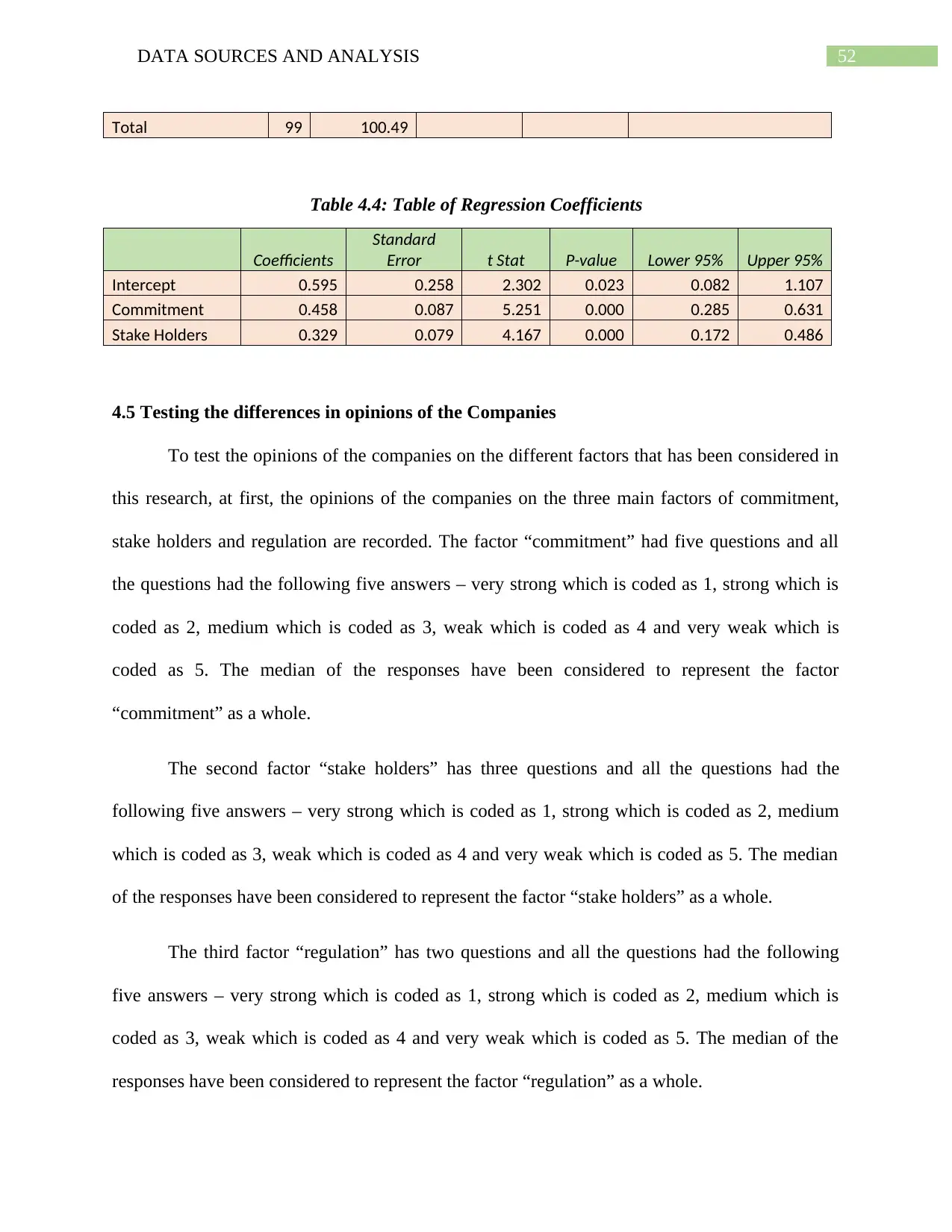
52DATA SOURCES AND ANALYSIS
Total 99 100.49
Table 4.4: Table of Regression Coefficients
Coefficients
Standard
Error t Stat P-value Lower 95% Upper 95%
Intercept 0.595 0.258 2.302 0.023 0.082 1.107
Commitment 0.458 0.087 5.251 0.000 0.285 0.631
Stake Holders 0.329 0.079 4.167 0.000 0.172 0.486
4.5 Testing the differences in opinions of the Companies
To test the opinions of the companies on the different factors that has been considered in
this research, at first, the opinions of the companies on the three main factors of commitment,
stake holders and regulation are recorded. The factor “commitment” had five questions and all
the questions had the following five answers – very strong which is coded as 1, strong which is
coded as 2, medium which is coded as 3, weak which is coded as 4 and very weak which is
coded as 5. The median of the responses have been considered to represent the factor
“commitment” as a whole.
The second factor “stake holders” has three questions and all the questions had the
following five answers – very strong which is coded as 1, strong which is coded as 2, medium
which is coded as 3, weak which is coded as 4 and very weak which is coded as 5. The median
of the responses have been considered to represent the factor “stake holders” as a whole.
The third factor “regulation” has two questions and all the questions had the following
five answers – very strong which is coded as 1, strong which is coded as 2, medium which is
coded as 3, weak which is coded as 4 and very weak which is coded as 5. The median of the
responses have been considered to represent the factor “regulation” as a whole.
Total 99 100.49
Table 4.4: Table of Regression Coefficients
Coefficients
Standard
Error t Stat P-value Lower 95% Upper 95%
Intercept 0.595 0.258 2.302 0.023 0.082 1.107
Commitment 0.458 0.087 5.251 0.000 0.285 0.631
Stake Holders 0.329 0.079 4.167 0.000 0.172 0.486
4.5 Testing the differences in opinions of the Companies
To test the opinions of the companies on the different factors that has been considered in
this research, at first, the opinions of the companies on the three main factors of commitment,
stake holders and regulation are recorded. The factor “commitment” had five questions and all
the questions had the following five answers – very strong which is coded as 1, strong which is
coded as 2, medium which is coded as 3, weak which is coded as 4 and very weak which is
coded as 5. The median of the responses have been considered to represent the factor
“commitment” as a whole.
The second factor “stake holders” has three questions and all the questions had the
following five answers – very strong which is coded as 1, strong which is coded as 2, medium
which is coded as 3, weak which is coded as 4 and very weak which is coded as 5. The median
of the responses have been considered to represent the factor “stake holders” as a whole.
The third factor “regulation” has two questions and all the questions had the following
five answers – very strong which is coded as 1, strong which is coded as 2, medium which is
coded as 3, weak which is coded as 4 and very weak which is coded as 5. The median of the
responses have been considered to represent the factor “regulation” as a whole.

53DATA SOURCES AND ANALYSIS
At first, the analysis has been conducted on the first two factors commitment and stake
holders. To test whether there is any difference in opinions between the different companies on
the matter of commitment and stake holders, two sample t-test has been conducted. The null
hypothesis and the alternate hypothesis for this test have been stated as follows:
Null Hypothesis (H01): There is no significant difference in opinions of the companies about
commitment and stake holders’ involvement to enhance the business performance.
Alternate Hypothesis (HA1): There is significant difference in opinions of the companies about
commitment and stake holders’ involvement to enhance the business performance.
From the results of the t-test in table 4.5, it is clear that the null hypothesis is rejected as
the p value is less than 0.05, the level of significance. Thus, it can be said that there are
significant differences in the opinions given by the companies about commitment and stake
holders’ involvement to enhance the business performance.
Table 4.5:t-Test: Two-Sample Assuming Equal Variances
Commitment
Stake Holders
Involvement
Mean 3.83 3.47
Variance 1.052 1.282
Observations 100 100
Pooled Variance 1.167
Hypothesized Mean Difference 0
df 198
t Stat 2.357
P(T<=t) one-tail 0.010
t Critical one-tail 1.653
P(T<=t) two-tail 0.019
t Critical two-tail 1.972
At first, the analysis has been conducted on the first two factors commitment and stake
holders. To test whether there is any difference in opinions between the different companies on
the matter of commitment and stake holders, two sample t-test has been conducted. The null
hypothesis and the alternate hypothesis for this test have been stated as follows:
Null Hypothesis (H01): There is no significant difference in opinions of the companies about
commitment and stake holders’ involvement to enhance the business performance.
Alternate Hypothesis (HA1): There is significant difference in opinions of the companies about
commitment and stake holders’ involvement to enhance the business performance.
From the results of the t-test in table 4.5, it is clear that the null hypothesis is rejected as
the p value is less than 0.05, the level of significance. Thus, it can be said that there are
significant differences in the opinions given by the companies about commitment and stake
holders’ involvement to enhance the business performance.
Table 4.5:t-Test: Two-Sample Assuming Equal Variances
Commitment
Stake Holders
Involvement
Mean 3.83 3.47
Variance 1.052 1.282
Observations 100 100
Pooled Variance 1.167
Hypothesized Mean Difference 0
df 198
t Stat 2.357
P(T<=t) one-tail 0.010
t Critical one-tail 1.653
P(T<=t) two-tail 0.019
t Critical two-tail 1.972
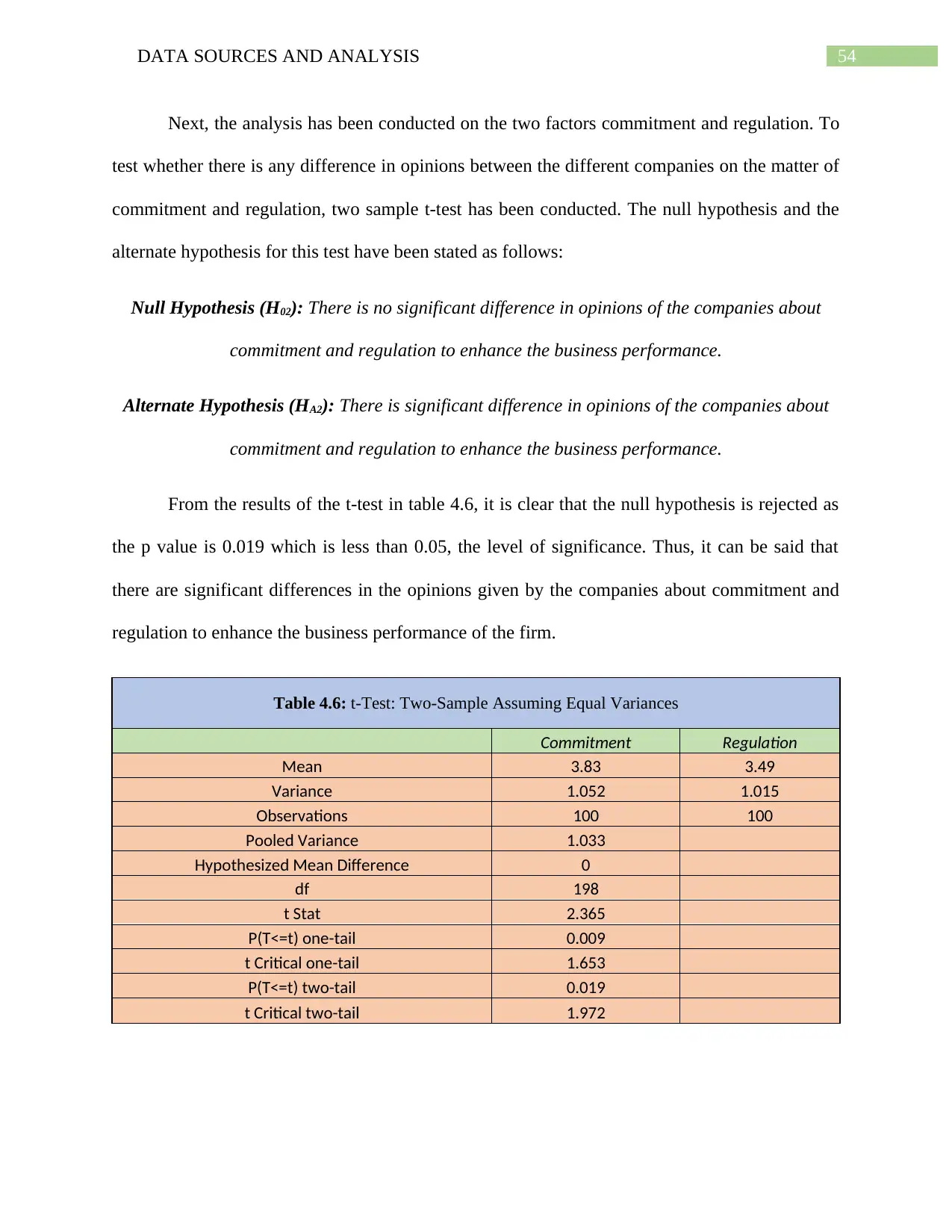
54DATA SOURCES AND ANALYSIS
Next, the analysis has been conducted on the two factors commitment and regulation. To
test whether there is any difference in opinions between the different companies on the matter of
commitment and regulation, two sample t-test has been conducted. The null hypothesis and the
alternate hypothesis for this test have been stated as follows:
Null Hypothesis (H02): There is no significant difference in opinions of the companies about
commitment and regulation to enhance the business performance.
Alternate Hypothesis (HA2): There is significant difference in opinions of the companies about
commitment and regulation to enhance the business performance.
From the results of the t-test in table 4.6, it is clear that the null hypothesis is rejected as
the p value is 0.019 which is less than 0.05, the level of significance. Thus, it can be said that
there are significant differences in the opinions given by the companies about commitment and
regulation to enhance the business performance of the firm.
Table 4.6: t-Test: Two-Sample Assuming Equal Variances
Commitment Regulation
Mean 3.83 3.49
Variance 1.052 1.015
Observations 100 100
Pooled Variance 1.033
Hypothesized Mean Difference 0
df 198
t Stat 2.365
P(T<=t) one-tail 0.009
t Critical one-tail 1.653
P(T<=t) two-tail 0.019
t Critical two-tail 1.972
Next, the analysis has been conducted on the two factors commitment and regulation. To
test whether there is any difference in opinions between the different companies on the matter of
commitment and regulation, two sample t-test has been conducted. The null hypothesis and the
alternate hypothesis for this test have been stated as follows:
Null Hypothesis (H02): There is no significant difference in opinions of the companies about
commitment and regulation to enhance the business performance.
Alternate Hypothesis (HA2): There is significant difference in opinions of the companies about
commitment and regulation to enhance the business performance.
From the results of the t-test in table 4.6, it is clear that the null hypothesis is rejected as
the p value is 0.019 which is less than 0.05, the level of significance. Thus, it can be said that
there are significant differences in the opinions given by the companies about commitment and
regulation to enhance the business performance of the firm.
Table 4.6: t-Test: Two-Sample Assuming Equal Variances
Commitment Regulation
Mean 3.83 3.49
Variance 1.052 1.015
Observations 100 100
Pooled Variance 1.033
Hypothesized Mean Difference 0
df 198
t Stat 2.365
P(T<=t) one-tail 0.009
t Critical one-tail 1.653
P(T<=t) two-tail 0.019
t Critical two-tail 1.972
Paraphrase This Document
Need a fresh take? Get an instant paraphrase of this document with our AI Paraphraser
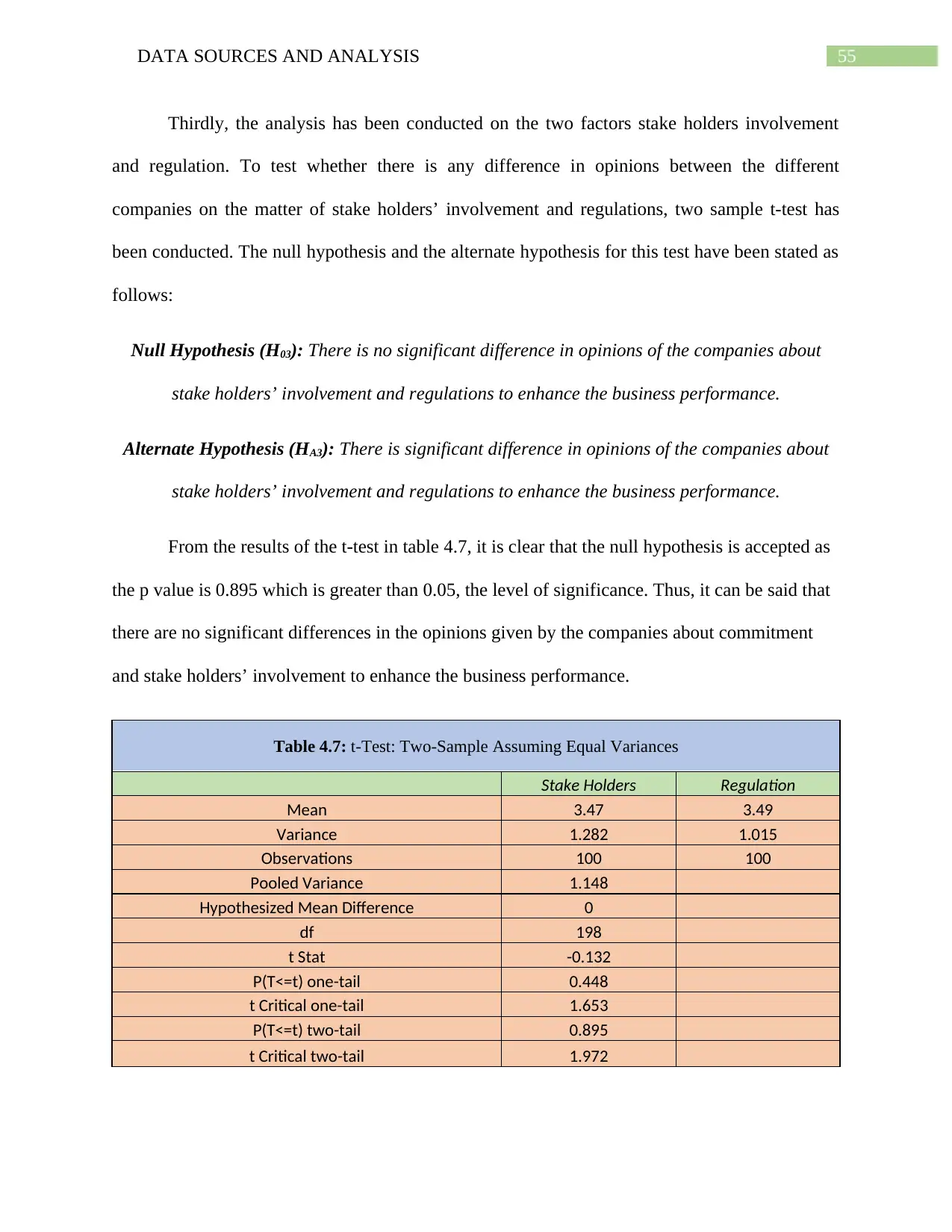
55DATA SOURCES AND ANALYSIS
Thirdly, the analysis has been conducted on the two factors stake holders involvement
and regulation. To test whether there is any difference in opinions between the different
companies on the matter of stake holders’ involvement and regulations, two sample t-test has
been conducted. The null hypothesis and the alternate hypothesis for this test have been stated as
follows:
Null Hypothesis (H03): There is no significant difference in opinions of the companies about
stake holders’ involvement and regulations to enhance the business performance.
Alternate Hypothesis (HA3): There is significant difference in opinions of the companies about
stake holders’ involvement and regulations to enhance the business performance.
From the results of the t-test in table 4.7, it is clear that the null hypothesis is accepted as
the p value is 0.895 which is greater than 0.05, the level of significance. Thus, it can be said that
there are no significant differences in the opinions given by the companies about commitment
and stake holders’ involvement to enhance the business performance.
Table 4.7: t-Test: Two-Sample Assuming Equal Variances
Stake Holders Regulation
Mean 3.47 3.49
Variance 1.282 1.015
Observations 100 100
Pooled Variance 1.148
Hypothesized Mean Difference 0
df 198
t Stat -0.132
P(T<=t) one-tail 0.448
t Critical one-tail 1.653
P(T<=t) two-tail 0.895
t Critical two-tail 1.972
Thirdly, the analysis has been conducted on the two factors stake holders involvement
and regulation. To test whether there is any difference in opinions between the different
companies on the matter of stake holders’ involvement and regulations, two sample t-test has
been conducted. The null hypothesis and the alternate hypothesis for this test have been stated as
follows:
Null Hypothesis (H03): There is no significant difference in opinions of the companies about
stake holders’ involvement and regulations to enhance the business performance.
Alternate Hypothesis (HA3): There is significant difference in opinions of the companies about
stake holders’ involvement and regulations to enhance the business performance.
From the results of the t-test in table 4.7, it is clear that the null hypothesis is accepted as
the p value is 0.895 which is greater than 0.05, the level of significance. Thus, it can be said that
there are no significant differences in the opinions given by the companies about commitment
and stake holders’ involvement to enhance the business performance.
Table 4.7: t-Test: Two-Sample Assuming Equal Variances
Stake Holders Regulation
Mean 3.47 3.49
Variance 1.282 1.015
Observations 100 100
Pooled Variance 1.148
Hypothesized Mean Difference 0
df 198
t Stat -0.132
P(T<=t) one-tail 0.448
t Critical one-tail 1.653
P(T<=t) two-tail 0.895
t Critical two-tail 1.972

56DATA SOURCES AND ANALYSIS
Next analysis that has been conducted is whether there is any significant difference in the
opinions given by different types of industries. To run this analysis, the 100 selected companies
have been segregated according to their type of industries. To test the difference in opinions in
industries, ANOVA test has been done.
The method with the help of which test is done to ensure whether the results of the survey
experiment are significant or not. Acceptance or rejectance of the null hypothesis is determined
with the help of this test. The ANOVA test is basically the test to check the difference between
different groups. ANOVA test are usually of two types – “One-way ANOVA” and “Two-way
ANOVA”. The number of independent variables that are included in the test for the Analysis of
Variance indicate whether the test is one way or two-way. In one-way ANOVA, there is only one
independent variable that has two groups or two levels. In two-way ANOVA, there are two
independent variables that can have multiple groups or levels. Groups or levels indicate the
different groups that are present in the particular independent variable. In this research, only one-
way ANOVA will be performed.
There are a few types of tests that are conducted in one-way ANOVA. The first one is the
test between the groups, test within the groups. With the help of one-way ANOVA, whether
there is any difference between any two groups can be determined. If there are more than two
groups, which two groups are different cannot be determined.
Here, at first, the difference in opinions provided by different types of industries on the
commitment of the industries towards the digitalization of the business has been measured. For
this test, the following null and alternate hypothesis has been framed:
Next analysis that has been conducted is whether there is any significant difference in the
opinions given by different types of industries. To run this analysis, the 100 selected companies
have been segregated according to their type of industries. To test the difference in opinions in
industries, ANOVA test has been done.
The method with the help of which test is done to ensure whether the results of the survey
experiment are significant or not. Acceptance or rejectance of the null hypothesis is determined
with the help of this test. The ANOVA test is basically the test to check the difference between
different groups. ANOVA test are usually of two types – “One-way ANOVA” and “Two-way
ANOVA”. The number of independent variables that are included in the test for the Analysis of
Variance indicate whether the test is one way or two-way. In one-way ANOVA, there is only one
independent variable that has two groups or two levels. In two-way ANOVA, there are two
independent variables that can have multiple groups or levels. Groups or levels indicate the
different groups that are present in the particular independent variable. In this research, only one-
way ANOVA will be performed.
There are a few types of tests that are conducted in one-way ANOVA. The first one is the
test between the groups, test within the groups. With the help of one-way ANOVA, whether
there is any difference between any two groups can be determined. If there are more than two
groups, which two groups are different cannot be determined.
Here, at first, the difference in opinions provided by different types of industries on the
commitment of the industries towards the digitalization of the business has been measured. For
this test, the following null and alternate hypothesis has been framed:
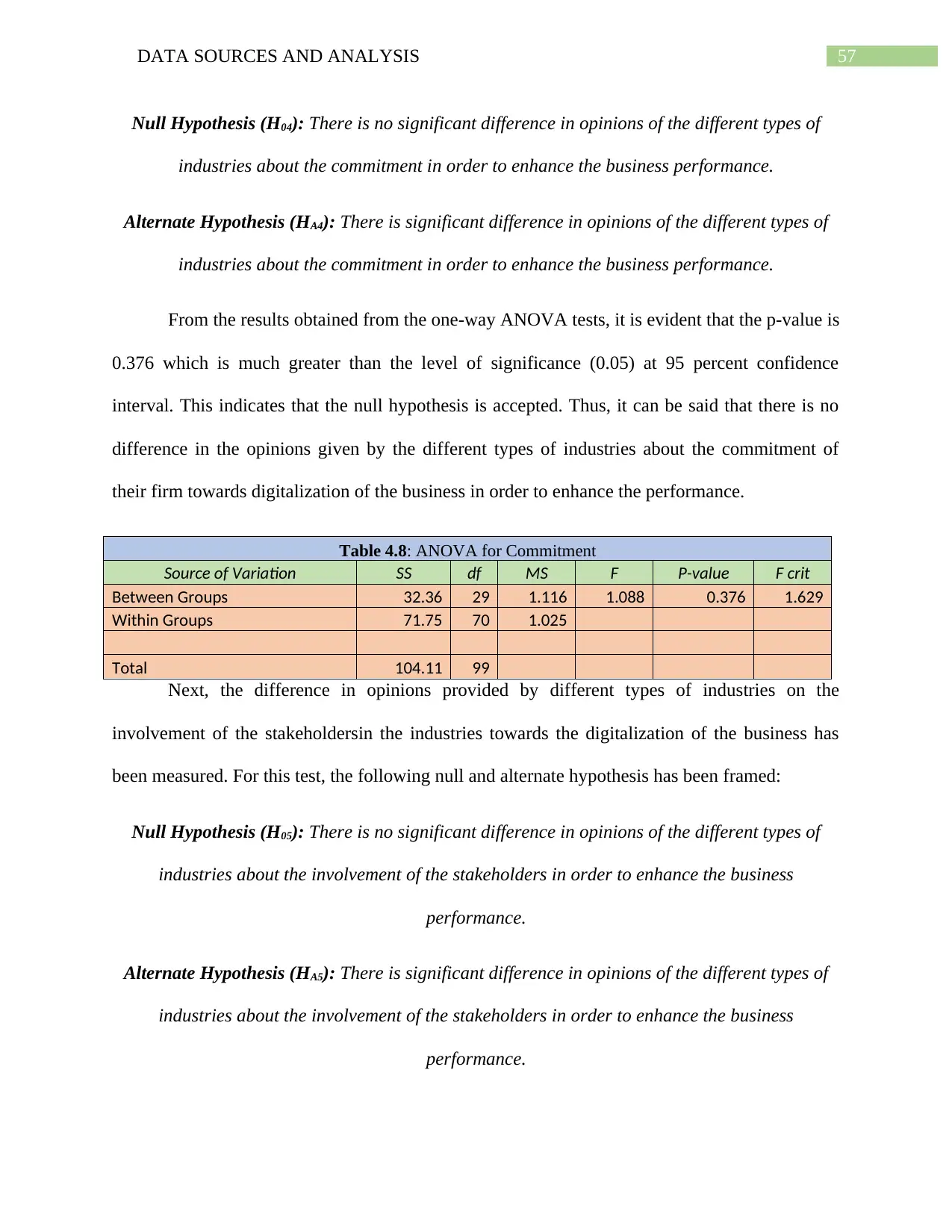
57DATA SOURCES AND ANALYSIS
Null Hypothesis (H04): There is no significant difference in opinions of the different types of
industries about the commitment in order to enhance the business performance.
Alternate Hypothesis (HA4): There is significant difference in opinions of the different types of
industries about the commitment in order to enhance the business performance.
From the results obtained from the one-way ANOVA tests, it is evident that the p-value is
0.376 which is much greater than the level of significance (0.05) at 95 percent confidence
interval. This indicates that the null hypothesis is accepted. Thus, it can be said that there is no
difference in the opinions given by the different types of industries about the commitment of
their firm towards digitalization of the business in order to enhance the performance.
Table 4.8: ANOVA for Commitment
Source of Variation SS df MS F P-value F crit
Between Groups 32.36 29 1.116 1.088 0.376 1.629
Within Groups 71.75 70 1.025
Total 104.11 99
Next, the difference in opinions provided by different types of industries on the
involvement of the stakeholdersin the industries towards the digitalization of the business has
been measured. For this test, the following null and alternate hypothesis has been framed:
Null Hypothesis (H05): There is no significant difference in opinions of the different types of
industries about the involvement of the stakeholders in order to enhance the business
performance.
Alternate Hypothesis (HA5): There is significant difference in opinions of the different types of
industries about the involvement of the stakeholders in order to enhance the business
performance.
Null Hypothesis (H04): There is no significant difference in opinions of the different types of
industries about the commitment in order to enhance the business performance.
Alternate Hypothesis (HA4): There is significant difference in opinions of the different types of
industries about the commitment in order to enhance the business performance.
From the results obtained from the one-way ANOVA tests, it is evident that the p-value is
0.376 which is much greater than the level of significance (0.05) at 95 percent confidence
interval. This indicates that the null hypothesis is accepted. Thus, it can be said that there is no
difference in the opinions given by the different types of industries about the commitment of
their firm towards digitalization of the business in order to enhance the performance.
Table 4.8: ANOVA for Commitment
Source of Variation SS df MS F P-value F crit
Between Groups 32.36 29 1.116 1.088 0.376 1.629
Within Groups 71.75 70 1.025
Total 104.11 99
Next, the difference in opinions provided by different types of industries on the
involvement of the stakeholdersin the industries towards the digitalization of the business has
been measured. For this test, the following null and alternate hypothesis has been framed:
Null Hypothesis (H05): There is no significant difference in opinions of the different types of
industries about the involvement of the stakeholders in order to enhance the business
performance.
Alternate Hypothesis (HA5): There is significant difference in opinions of the different types of
industries about the involvement of the stakeholders in order to enhance the business
performance.
Secure Best Marks with AI Grader
Need help grading? Try our AI Grader for instant feedback on your assignments.
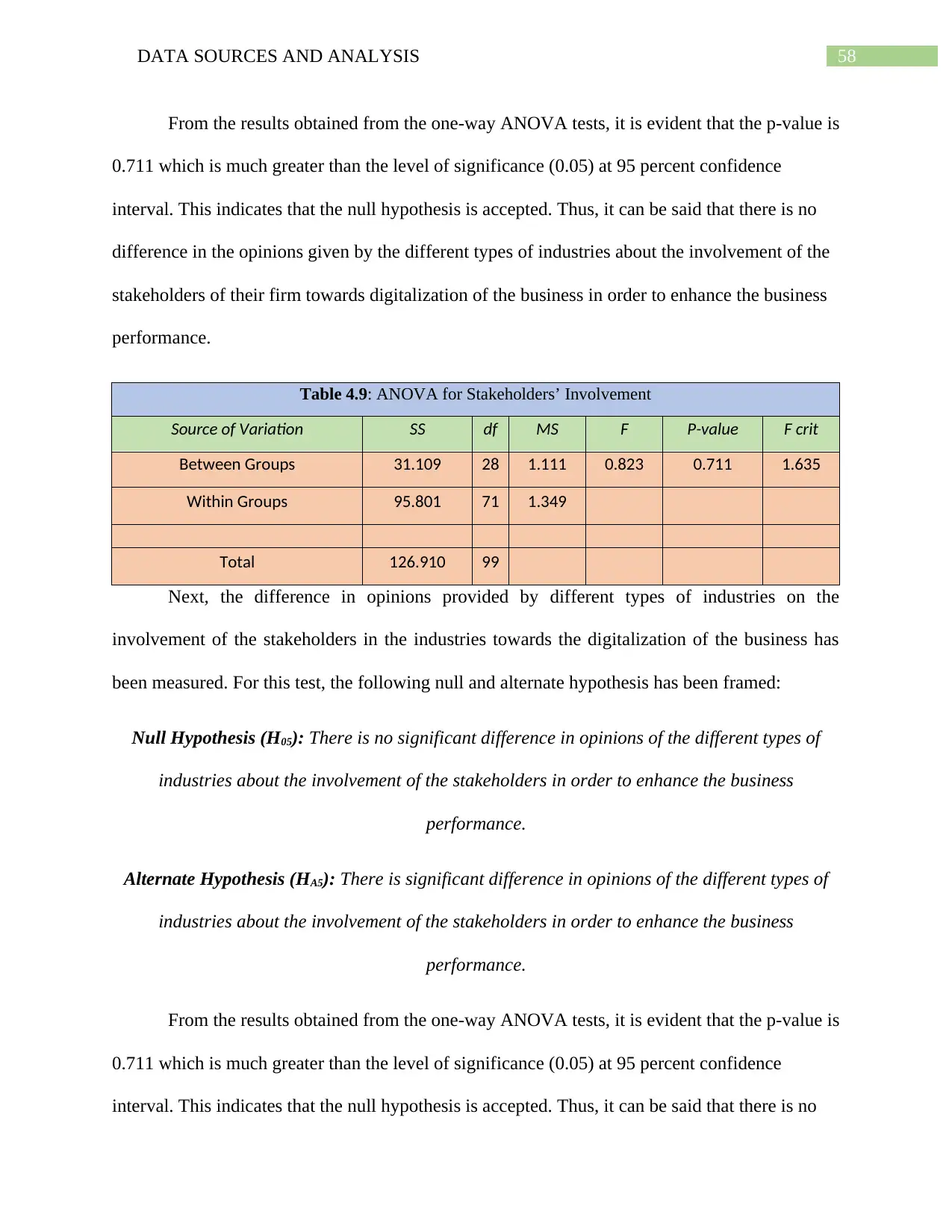
58DATA SOURCES AND ANALYSIS
From the results obtained from the one-way ANOVA tests, it is evident that the p-value is
0.711 which is much greater than the level of significance (0.05) at 95 percent confidence
interval. This indicates that the null hypothesis is accepted. Thus, it can be said that there is no
difference in the opinions given by the different types of industries about the involvement of the
stakeholders of their firm towards digitalization of the business in order to enhance the business
performance.
Table 4.9: ANOVA for Stakeholders’ Involvement
Source of Variation SS df MS F P-value F crit
Between Groups 31.109 28 1.111 0.823 0.711 1.635
Within Groups 95.801 71 1.349
Total 126.910 99
Next, the difference in opinions provided by different types of industries on the
involvement of the stakeholders in the industries towards the digitalization of the business has
been measured. For this test, the following null and alternate hypothesis has been framed:
Null Hypothesis (H05): There is no significant difference in opinions of the different types of
industries about the involvement of the stakeholders in order to enhance the business
performance.
Alternate Hypothesis (HA5): There is significant difference in opinions of the different types of
industries about the involvement of the stakeholders in order to enhance the business
performance.
From the results obtained from the one-way ANOVA tests, it is evident that the p-value is
0.711 which is much greater than the level of significance (0.05) at 95 percent confidence
interval. This indicates that the null hypothesis is accepted. Thus, it can be said that there is no
From the results obtained from the one-way ANOVA tests, it is evident that the p-value is
0.711 which is much greater than the level of significance (0.05) at 95 percent confidence
interval. This indicates that the null hypothesis is accepted. Thus, it can be said that there is no
difference in the opinions given by the different types of industries about the involvement of the
stakeholders of their firm towards digitalization of the business in order to enhance the business
performance.
Table 4.9: ANOVA for Stakeholders’ Involvement
Source of Variation SS df MS F P-value F crit
Between Groups 31.109 28 1.111 0.823 0.711 1.635
Within Groups 95.801 71 1.349
Total 126.910 99
Next, the difference in opinions provided by different types of industries on the
involvement of the stakeholders in the industries towards the digitalization of the business has
been measured. For this test, the following null and alternate hypothesis has been framed:
Null Hypothesis (H05): There is no significant difference in opinions of the different types of
industries about the involvement of the stakeholders in order to enhance the business
performance.
Alternate Hypothesis (HA5): There is significant difference in opinions of the different types of
industries about the involvement of the stakeholders in order to enhance the business
performance.
From the results obtained from the one-way ANOVA tests, it is evident that the p-value is
0.711 which is much greater than the level of significance (0.05) at 95 percent confidence
interval. This indicates that the null hypothesis is accepted. Thus, it can be said that there is no

59DATA SOURCES AND ANALYSIS
difference in the opinions given by the different types of industries about the involvement of the
stakeholders of their firm towards digitalization of the business in order to enhance the business
performance.
Table 4.10: ANOVA for Regulations
Source of Variation SS df MS F P-value F crit
Between Groups 32.942 28 1.177 1.237 0.234 1.635
Within Groups 67.548 71 0.951
Total 100.490 99
Next, the difference in opinions provided by different types of industries on the
regulations of the industries towards the digitalization of the business has been measured. For
this test, the following null and alternate hypothesis has been framed:
Null Hypothesis (H05): There is no significant difference in opinions of the different types of
industries about the regulations of the companies in order to enhance the business performance.
Alternate Hypothesis (HA5): There is significant difference in opinions of the different types of
industries about regulations of the companies in order to enhance the business performance.
From the results obtained from the one-way ANOVA tests (Table 4.10), it is evident that
the p-value is 0.234, which is much greater than the level of significance (0.05) at 95 percent
confidence interval. This indicates that the null hypothesis is accepted. Thus, it can be said that
there is no difference in the opinions given by the different types of industries about the
regulations of their firm towards digitalization of the business in order to enhance the business
performance.
difference in the opinions given by the different types of industries about the involvement of the
stakeholders of their firm towards digitalization of the business in order to enhance the business
performance.
Table 4.10: ANOVA for Regulations
Source of Variation SS df MS F P-value F crit
Between Groups 32.942 28 1.177 1.237 0.234 1.635
Within Groups 67.548 71 0.951
Total 100.490 99
Next, the difference in opinions provided by different types of industries on the
regulations of the industries towards the digitalization of the business has been measured. For
this test, the following null and alternate hypothesis has been framed:
Null Hypothesis (H05): There is no significant difference in opinions of the different types of
industries about the regulations of the companies in order to enhance the business performance.
Alternate Hypothesis (HA5): There is significant difference in opinions of the different types of
industries about regulations of the companies in order to enhance the business performance.
From the results obtained from the one-way ANOVA tests (Table 4.10), it is evident that
the p-value is 0.234, which is much greater than the level of significance (0.05) at 95 percent
confidence interval. This indicates that the null hypothesis is accepted. Thus, it can be said that
there is no difference in the opinions given by the different types of industries about the
regulations of their firm towards digitalization of the business in order to enhance the business
performance.
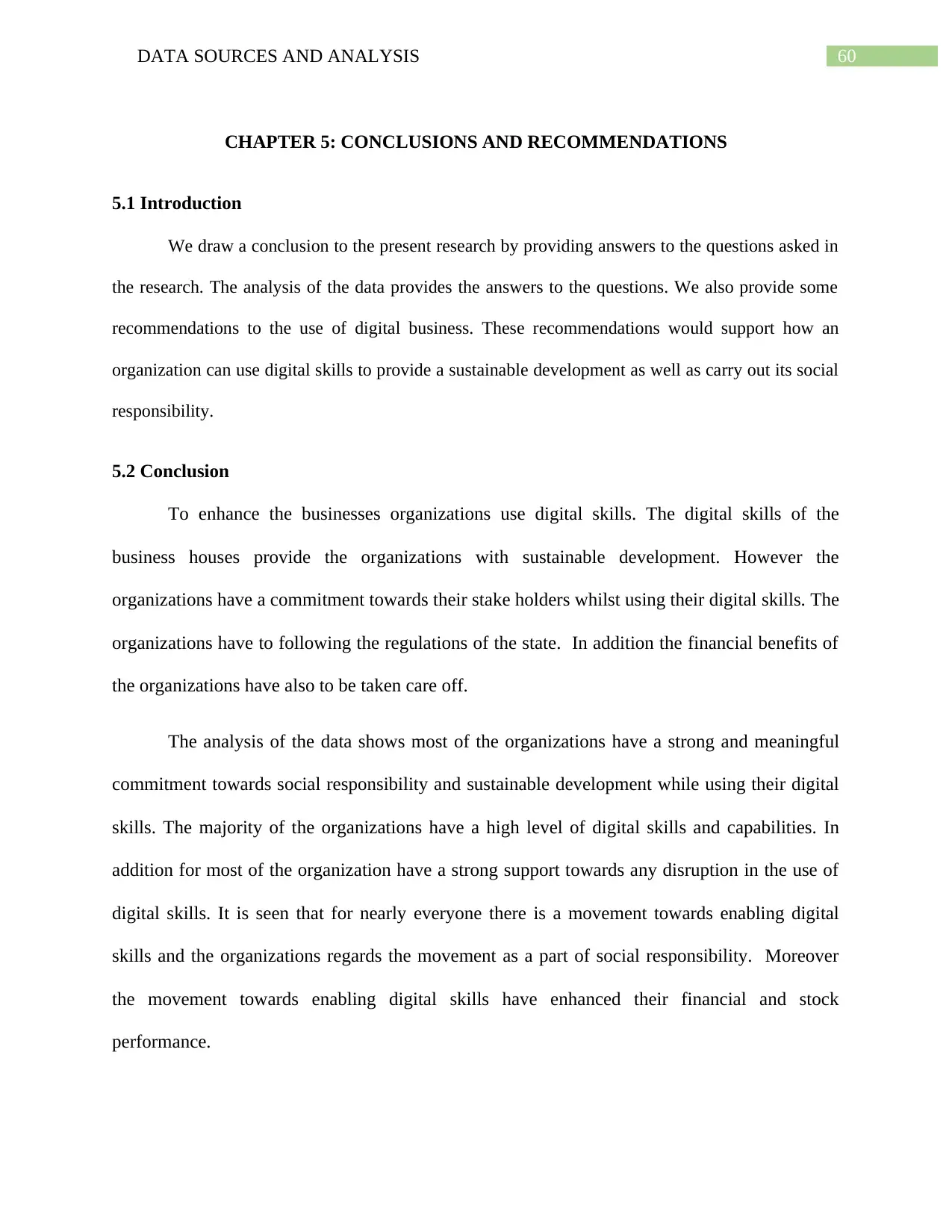
60DATA SOURCES AND ANALYSIS
CHAPTER 5: CONCLUSIONS AND RECOMMENDATIONS
5.1 Introduction
We draw a conclusion to the present research by providing answers to the questions asked in
the research. The analysis of the data provides the answers to the questions. We also provide some
recommendations to the use of digital business. These recommendations would support how an
organization can use digital skills to provide a sustainable development as well as carry out its social
responsibility.
5.2 Conclusion
To enhance the businesses organizations use digital skills. The digital skills of the
business houses provide the organizations with sustainable development. However the
organizations have a commitment towards their stake holders whilst using their digital skills. The
organizations have to following the regulations of the state. In addition the financial benefits of
the organizations have also to be taken care off.
The analysis of the data shows most of the organizations have a strong and meaningful
commitment towards social responsibility and sustainable development while using their digital
skills. The majority of the organizations have a high level of digital skills and capabilities. In
addition for most of the organization have a strong support towards any disruption in the use of
digital skills. It is seen that for nearly everyone there is a movement towards enabling digital
skills and the organizations regards the movement as a part of social responsibility. Moreover
the movement towards enabling digital skills have enhanced their financial and stock
performance.
CHAPTER 5: CONCLUSIONS AND RECOMMENDATIONS
5.1 Introduction
We draw a conclusion to the present research by providing answers to the questions asked in
the research. The analysis of the data provides the answers to the questions. We also provide some
recommendations to the use of digital business. These recommendations would support how an
organization can use digital skills to provide a sustainable development as well as carry out its social
responsibility.
5.2 Conclusion
To enhance the businesses organizations use digital skills. The digital skills of the
business houses provide the organizations with sustainable development. However the
organizations have a commitment towards their stake holders whilst using their digital skills. The
organizations have to following the regulations of the state. In addition the financial benefits of
the organizations have also to be taken care off.
The analysis of the data shows most of the organizations have a strong and meaningful
commitment towards social responsibility and sustainable development while using their digital
skills. The majority of the organizations have a high level of digital skills and capabilities. In
addition for most of the organization have a strong support towards any disruption in the use of
digital skills. It is seen that for nearly everyone there is a movement towards enabling digital
skills and the organizations regards the movement as a part of social responsibility. Moreover
the movement towards enabling digital skills have enhanced their financial and stock
performance.
Paraphrase This Document
Need a fresh take? Get an instant paraphrase of this document with our AI Paraphraser
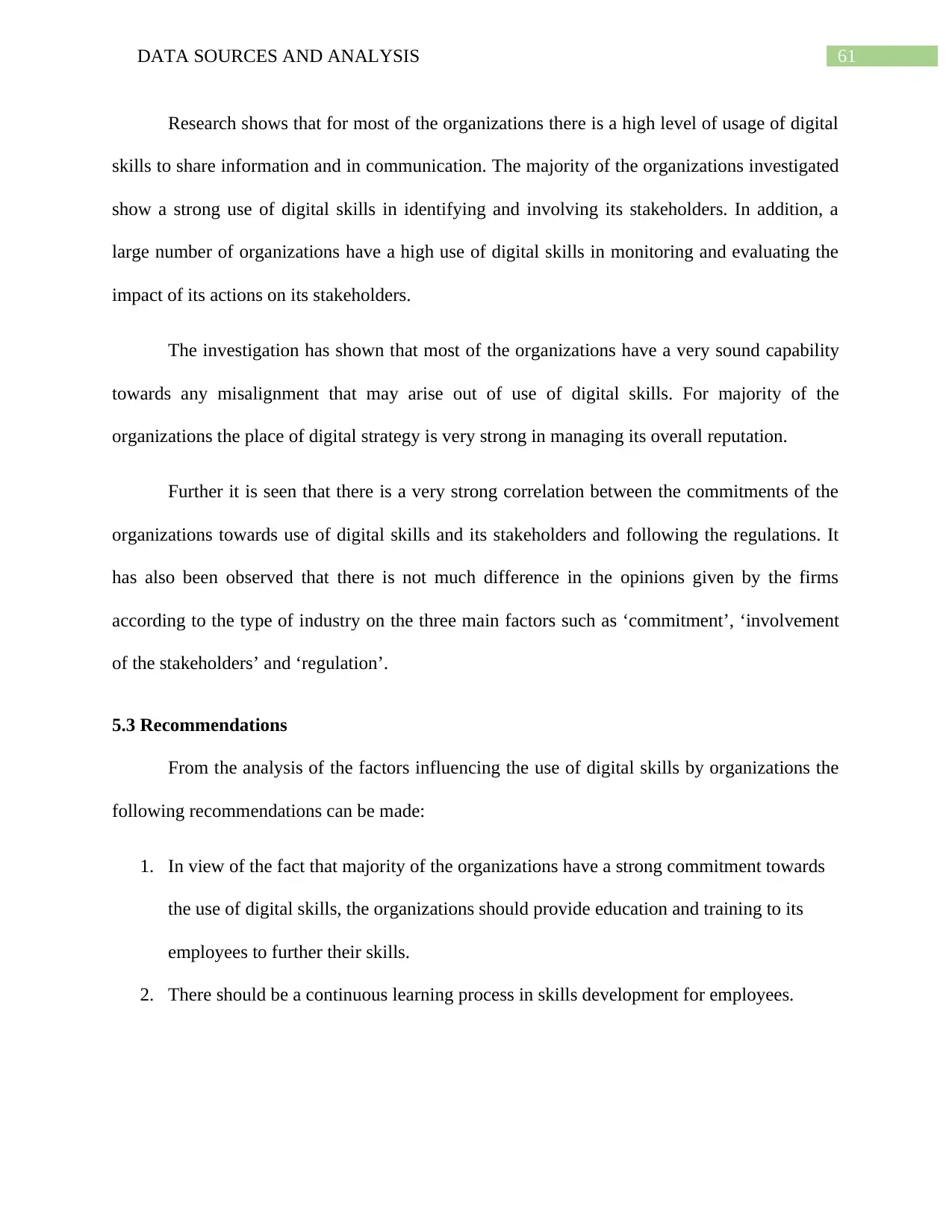
61DATA SOURCES AND ANALYSIS
Research shows that for most of the organizations there is a high level of usage of digital
skills to share information and in communication. The majority of the organizations investigated
show a strong use of digital skills in identifying and involving its stakeholders. In addition, a
large number of organizations have a high use of digital skills in monitoring and evaluating the
impact of its actions on its stakeholders.
The investigation has shown that most of the organizations have a very sound capability
towards any misalignment that may arise out of use of digital skills. For majority of the
organizations the place of digital strategy is very strong in managing its overall reputation.
Further it is seen that there is a very strong correlation between the commitments of the
organizations towards use of digital skills and its stakeholders and following the regulations. It
has also been observed that there is not much difference in the opinions given by the firms
according to the type of industry on the three main factors such as ‘commitment’, ‘involvement
of the stakeholders’ and ‘regulation’.
5.3 Recommendations
From the analysis of the factors influencing the use of digital skills by organizations the
following recommendations can be made:
1. In view of the fact that majority of the organizations have a strong commitment towards
the use of digital skills, the organizations should provide education and training to its
employees to further their skills.
2. There should be a continuous learning process in skills development for employees.
Research shows that for most of the organizations there is a high level of usage of digital
skills to share information and in communication. The majority of the organizations investigated
show a strong use of digital skills in identifying and involving its stakeholders. In addition, a
large number of organizations have a high use of digital skills in monitoring and evaluating the
impact of its actions on its stakeholders.
The investigation has shown that most of the organizations have a very sound capability
towards any misalignment that may arise out of use of digital skills. For majority of the
organizations the place of digital strategy is very strong in managing its overall reputation.
Further it is seen that there is a very strong correlation between the commitments of the
organizations towards use of digital skills and its stakeholders and following the regulations. It
has also been observed that there is not much difference in the opinions given by the firms
according to the type of industry on the three main factors such as ‘commitment’, ‘involvement
of the stakeholders’ and ‘regulation’.
5.3 Recommendations
From the analysis of the factors influencing the use of digital skills by organizations the
following recommendations can be made:
1. In view of the fact that majority of the organizations have a strong commitment towards
the use of digital skills, the organizations should provide education and training to its
employees to further their skills.
2. There should be a continuous learning process in skills development for employees.
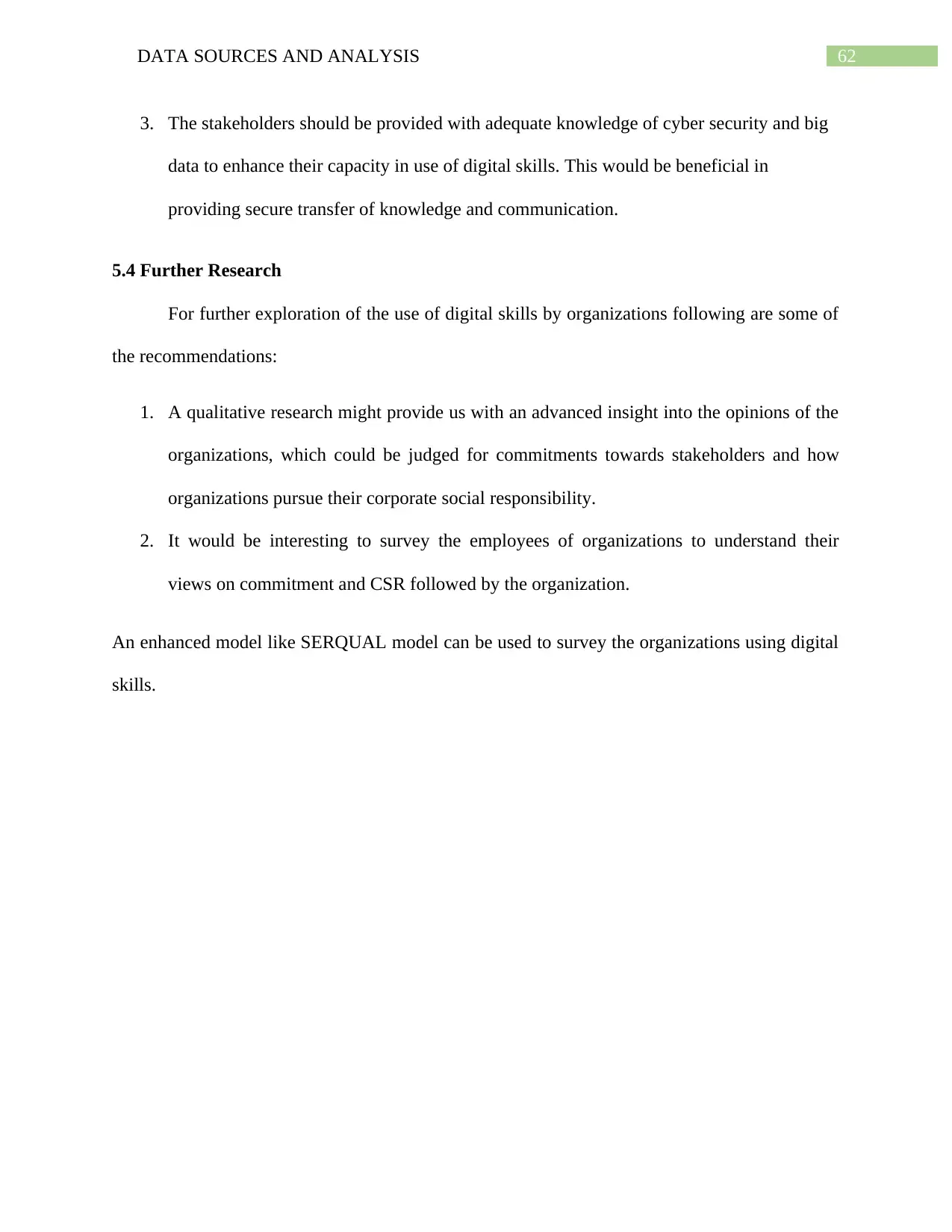
62DATA SOURCES AND ANALYSIS
3. The stakeholders should be provided with adequate knowledge of cyber security and big
data to enhance their capacity in use of digital skills. This would be beneficial in
providing secure transfer of knowledge and communication.
5.4 Further Research
For further exploration of the use of digital skills by organizations following are some of
the recommendations:
1. A qualitative research might provide us with an advanced insight into the opinions of the
organizations, which could be judged for commitments towards stakeholders and how
organizations pursue their corporate social responsibility.
2. It would be interesting to survey the employees of organizations to understand their
views on commitment and CSR followed by the organization.
An enhanced model like SERQUAL model can be used to survey the organizations using digital
skills.
3. The stakeholders should be provided with adequate knowledge of cyber security and big
data to enhance their capacity in use of digital skills. This would be beneficial in
providing secure transfer of knowledge and communication.
5.4 Further Research
For further exploration of the use of digital skills by organizations following are some of
the recommendations:
1. A qualitative research might provide us with an advanced insight into the opinions of the
organizations, which could be judged for commitments towards stakeholders and how
organizations pursue their corporate social responsibility.
2. It would be interesting to survey the employees of organizations to understand their
views on commitment and CSR followed by the organization.
An enhanced model like SERQUAL model can be used to survey the organizations using digital
skills.
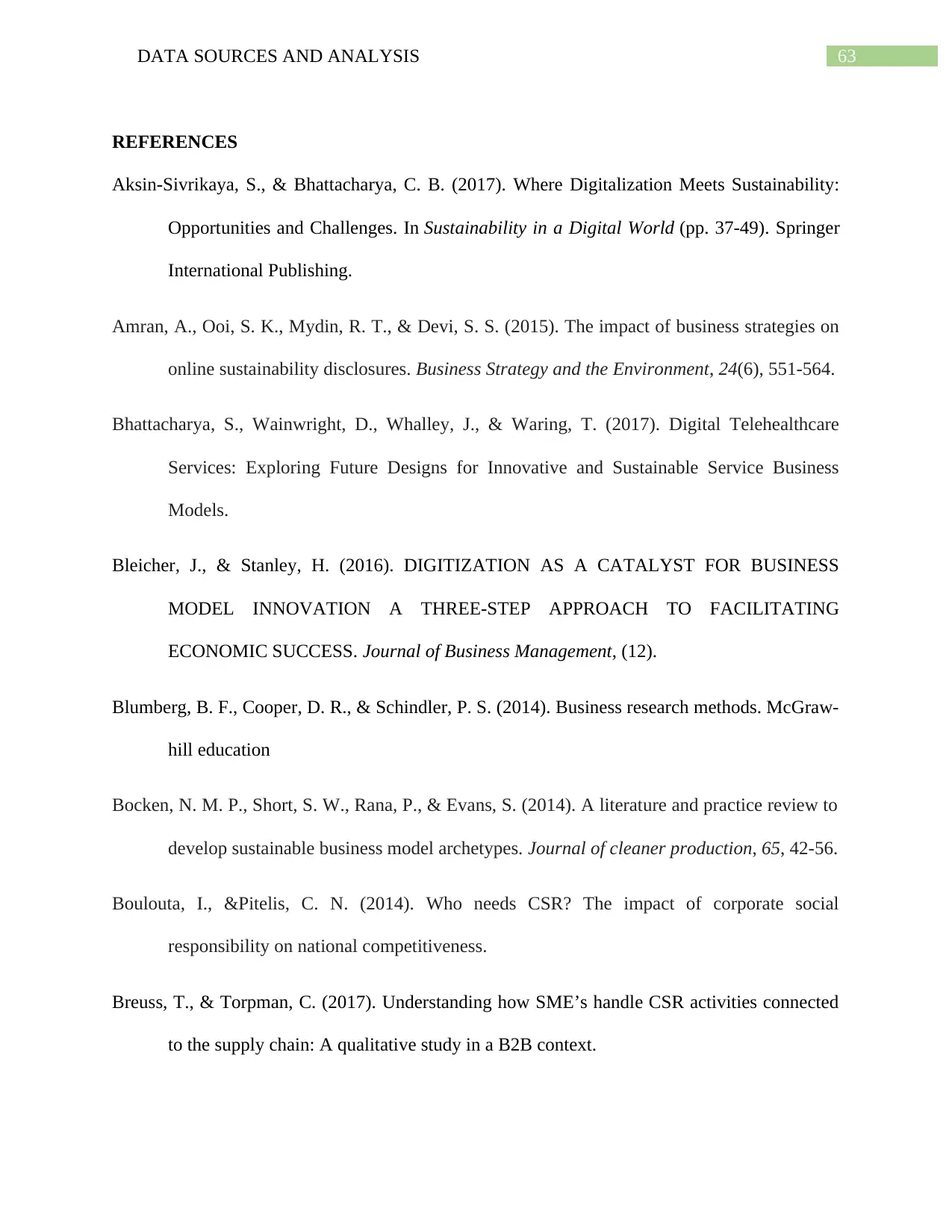
63DATA SOURCES AND ANALYSIS
REFERENCES
Aksin-Sivrikaya, S., & Bhattacharya, C. B. (2017). Where Digitalization Meets Sustainability:
Opportunities and Challenges. In Sustainability in a Digital World (pp. 37-49). Springer
International Publishing.
Amran, A., Ooi, S. K., Mydin, R. T., & Devi, S. S. (2015). The impact of business strategies on
online sustainability disclosures. Business Strategy and the Environment, 24(6), 551-564.
Bhattacharya, S., Wainwright, D., Whalley, J., & Waring, T. (2017). Digital Telehealthcare
Services: Exploring Future Designs for Innovative and Sustainable Service Business
Models.
Bleicher, J., & Stanley, H. (2016). DIGITIZATION AS A CATALYST FOR BUSINESS
MODEL INNOVATION A THREE-STEP APPROACH TO FACILITATING
ECONOMIC SUCCESS. Journal of Business Management, (12).
Blumberg, B. F., Cooper, D. R., & Schindler, P. S. (2014). Business research methods. McGraw-
hill education
Bocken, N. M. P., Short, S. W., Rana, P., & Evans, S. (2014). A literature and practice review to
develop sustainable business model archetypes. Journal of cleaner production, 65, 42-56.
Boulouta, I., &Pitelis, C. N. (2014). Who needs CSR? The impact of corporate social
responsibility on national competitiveness.
Breuss, T., & Torpman, C. (2017). Understanding how SME’s handle CSR activities connected
to the supply chain: A qualitative study in a B2B context.
REFERENCES
Aksin-Sivrikaya, S., & Bhattacharya, C. B. (2017). Where Digitalization Meets Sustainability:
Opportunities and Challenges. In Sustainability in a Digital World (pp. 37-49). Springer
International Publishing.
Amran, A., Ooi, S. K., Mydin, R. T., & Devi, S. S. (2015). The impact of business strategies on
online sustainability disclosures. Business Strategy and the Environment, 24(6), 551-564.
Bhattacharya, S., Wainwright, D., Whalley, J., & Waring, T. (2017). Digital Telehealthcare
Services: Exploring Future Designs for Innovative and Sustainable Service Business
Models.
Bleicher, J., & Stanley, H. (2016). DIGITIZATION AS A CATALYST FOR BUSINESS
MODEL INNOVATION A THREE-STEP APPROACH TO FACILITATING
ECONOMIC SUCCESS. Journal of Business Management, (12).
Blumberg, B. F., Cooper, D. R., & Schindler, P. S. (2014). Business research methods. McGraw-
hill education
Bocken, N. M. P., Short, S. W., Rana, P., & Evans, S. (2014). A literature and practice review to
develop sustainable business model archetypes. Journal of cleaner production, 65, 42-56.
Boulouta, I., &Pitelis, C. N. (2014). Who needs CSR? The impact of corporate social
responsibility on national competitiveness.
Breuss, T., & Torpman, C. (2017). Understanding how SME’s handle CSR activities connected
to the supply chain: A qualitative study in a B2B context.
Secure Best Marks with AI Grader
Need help grading? Try our AI Grader for instant feedback on your assignments.
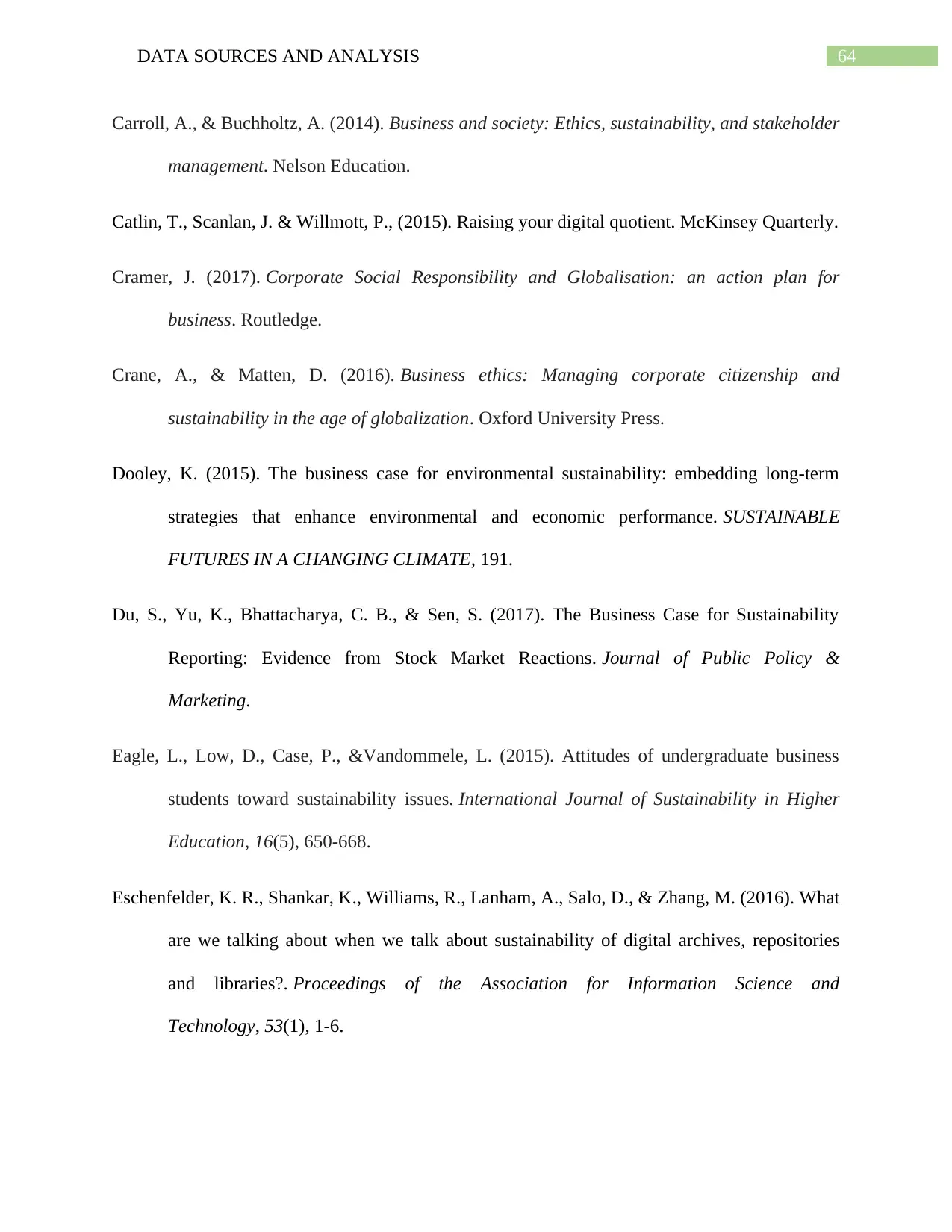
64DATA SOURCES AND ANALYSIS
Carroll, A., & Buchholtz, A. (2014). Business and society: Ethics, sustainability, and stakeholder
management. Nelson Education.
Catlin, T., Scanlan, J. & Willmott, P., (2015). Raising your digital quotient. McKinsey Quarterly.
Cramer, J. (2017). Corporate Social Responsibility and Globalisation: an action plan for
business. Routledge.
Crane, A., & Matten, D. (2016). Business ethics: Managing corporate citizenship and
sustainability in the age of globalization. Oxford University Press.
Dooley, K. (2015). The business case for environmental sustainability: embedding long-term
strategies that enhance environmental and economic performance. SUSTAINABLE
FUTURES IN A CHANGING CLIMATE, 191.
Du, S., Yu, K., Bhattacharya, C. B., & Sen, S. (2017). The Business Case for Sustainability
Reporting: Evidence from Stock Market Reactions. Journal of Public Policy &
Marketing.
Eagle, L., Low, D., Case, P., &Vandommele, L. (2015). Attitudes of undergraduate business
students toward sustainability issues. International Journal of Sustainability in Higher
Education, 16(5), 650-668.
Eschenfelder, K. R., Shankar, K., Williams, R., Lanham, A., Salo, D., & Zhang, M. (2016). What
are we talking about when we talk about sustainability of digital archives, repositories
and libraries?. Proceedings of the Association for Information Science and
Technology, 53(1), 1-6.
Carroll, A., & Buchholtz, A. (2014). Business and society: Ethics, sustainability, and stakeholder
management. Nelson Education.
Catlin, T., Scanlan, J. & Willmott, P., (2015). Raising your digital quotient. McKinsey Quarterly.
Cramer, J. (2017). Corporate Social Responsibility and Globalisation: an action plan for
business. Routledge.
Crane, A., & Matten, D. (2016). Business ethics: Managing corporate citizenship and
sustainability in the age of globalization. Oxford University Press.
Dooley, K. (2015). The business case for environmental sustainability: embedding long-term
strategies that enhance environmental and economic performance. SUSTAINABLE
FUTURES IN A CHANGING CLIMATE, 191.
Du, S., Yu, K., Bhattacharya, C. B., & Sen, S. (2017). The Business Case for Sustainability
Reporting: Evidence from Stock Market Reactions. Journal of Public Policy &
Marketing.
Eagle, L., Low, D., Case, P., &Vandommele, L. (2015). Attitudes of undergraduate business
students toward sustainability issues. International Journal of Sustainability in Higher
Education, 16(5), 650-668.
Eschenfelder, K. R., Shankar, K., Williams, R., Lanham, A., Salo, D., & Zhang, M. (2016). What
are we talking about when we talk about sustainability of digital archives, repositories
and libraries?. Proceedings of the Association for Information Science and
Technology, 53(1), 1-6.

65DATA SOURCES AND ANALYSIS
Flyverbom, M., Deibert, R., & Matten, D. (2017). The Governance of Digital Technology, Big
Data, and the Internet: New Roles and Responsibilities for Business. Business & Society,
0007650317727540.
Ganguly, A. (2015). Optimization of IT and Digital Transformation: Strategic Imperative for
Creating a New Value Delivery Mechanism and Sustainable Future in
Organization. European Journal of Business and Innovation Research, 3(2), 1-13.
Gulati, R., &Soni, T. (2015). Digitization: A strategic key to business. Journal of Advances in
Business Management, 1(2), 60-67.
Hahn, T., Preuss, L., Pinkse, J., &Figge, F. (2014). Cognitive frames in corporate sustainability:
Managerial sensemaking with paradoxical and business case frames. Academy of
Management Review, 39(4), 463-487.
Hashim, K. F., & Tan, F. B. (2015). The mediating role of trust and commitment on members’
continuous knowledge sharing intention: A commitment-trust theory
perspective. International Journal of Information Management, 35(2), 145-151.
Hedman, J., Sarker, S., &Veit, D. (2016). Digitization in business models and
entrepreneurship. Information Systems Journal, 26(5), 419-420.
Hirt, M. & Willmott, P., (2014). Strategic principles for competing in the digital age. McKinsey
Quarterly, 5, p.1.
Hockerts, K. (2015). A cognitive perspective on the business case for corporate
sustainability. Business Strategy and the Environment, 24(2), 102-122.
Flyverbom, M., Deibert, R., & Matten, D. (2017). The Governance of Digital Technology, Big
Data, and the Internet: New Roles and Responsibilities for Business. Business & Society,
0007650317727540.
Ganguly, A. (2015). Optimization of IT and Digital Transformation: Strategic Imperative for
Creating a New Value Delivery Mechanism and Sustainable Future in
Organization. European Journal of Business and Innovation Research, 3(2), 1-13.
Gulati, R., &Soni, T. (2015). Digitization: A strategic key to business. Journal of Advances in
Business Management, 1(2), 60-67.
Hahn, T., Preuss, L., Pinkse, J., &Figge, F. (2014). Cognitive frames in corporate sustainability:
Managerial sensemaking with paradoxical and business case frames. Academy of
Management Review, 39(4), 463-487.
Hashim, K. F., & Tan, F. B. (2015). The mediating role of trust and commitment on members’
continuous knowledge sharing intention: A commitment-trust theory
perspective. International Journal of Information Management, 35(2), 145-151.
Hedman, J., Sarker, S., &Veit, D. (2016). Digitization in business models and
entrepreneurship. Information Systems Journal, 26(5), 419-420.
Hirt, M. & Willmott, P., (2014). Strategic principles for competing in the digital age. McKinsey
Quarterly, 5, p.1.
Hockerts, K. (2015). A cognitive perspective on the business case for corporate
sustainability. Business Strategy and the Environment, 24(2), 102-122.
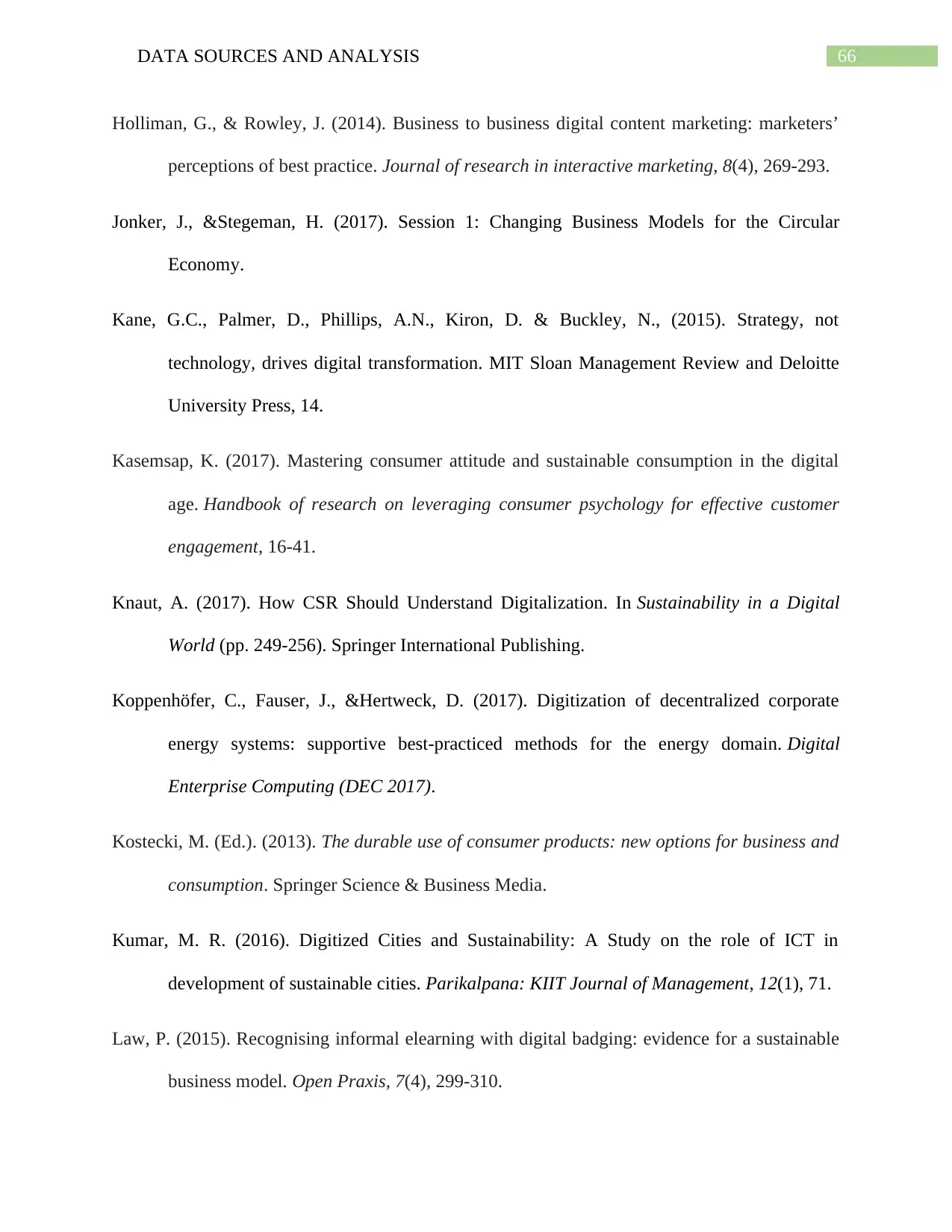
66DATA SOURCES AND ANALYSIS
Holliman, G., & Rowley, J. (2014). Business to business digital content marketing: marketers’
perceptions of best practice. Journal of research in interactive marketing, 8(4), 269-293.
Jonker, J., &Stegeman, H. (2017). Session 1: Changing Business Models for the Circular
Economy.
Kane, G.C., Palmer, D., Phillips, A.N., Kiron, D. & Buckley, N., (2015). Strategy, not
technology, drives digital transformation. MIT Sloan Management Review and Deloitte
University Press, 14.
Kasemsap, K. (2017). Mastering consumer attitude and sustainable consumption in the digital
age. Handbook of research on leveraging consumer psychology for effective customer
engagement, 16-41.
Knaut, A. (2017). How CSR Should Understand Digitalization. In Sustainability in a Digital
World (pp. 249-256). Springer International Publishing.
Koppenhöfer, C., Fauser, J., &Hertweck, D. (2017). Digitization of decentralized corporate
energy systems: supportive best-practiced methods for the energy domain. Digital
Enterprise Computing (DEC 2017).
Kostecki, M. (Ed.). (2013). The durable use of consumer products: new options for business and
consumption. Springer Science & Business Media.
Kumar, M. R. (2016). Digitized Cities and Sustainability: A Study on the role of ICT in
development of sustainable cities. Parikalpana: KIIT Journal of Management, 12(1), 71.
Law, P. (2015). Recognising informal elearning with digital badging: evidence for a sustainable
business model. Open Praxis, 7(4), 299-310.
Holliman, G., & Rowley, J. (2014). Business to business digital content marketing: marketers’
perceptions of best practice. Journal of research in interactive marketing, 8(4), 269-293.
Jonker, J., &Stegeman, H. (2017). Session 1: Changing Business Models for the Circular
Economy.
Kane, G.C., Palmer, D., Phillips, A.N., Kiron, D. & Buckley, N., (2015). Strategy, not
technology, drives digital transformation. MIT Sloan Management Review and Deloitte
University Press, 14.
Kasemsap, K. (2017). Mastering consumer attitude and sustainable consumption in the digital
age. Handbook of research on leveraging consumer psychology for effective customer
engagement, 16-41.
Knaut, A. (2017). How CSR Should Understand Digitalization. In Sustainability in a Digital
World (pp. 249-256). Springer International Publishing.
Koppenhöfer, C., Fauser, J., &Hertweck, D. (2017). Digitization of decentralized corporate
energy systems: supportive best-practiced methods for the energy domain. Digital
Enterprise Computing (DEC 2017).
Kostecki, M. (Ed.). (2013). The durable use of consumer products: new options for business and
consumption. Springer Science & Business Media.
Kumar, M. R. (2016). Digitized Cities and Sustainability: A Study on the role of ICT in
development of sustainable cities. Parikalpana: KIIT Journal of Management, 12(1), 71.
Law, P. (2015). Recognising informal elearning with digital badging: evidence for a sustainable
business model. Open Praxis, 7(4), 299-310.
Paraphrase This Document
Need a fresh take? Get an instant paraphrase of this document with our AI Paraphraser
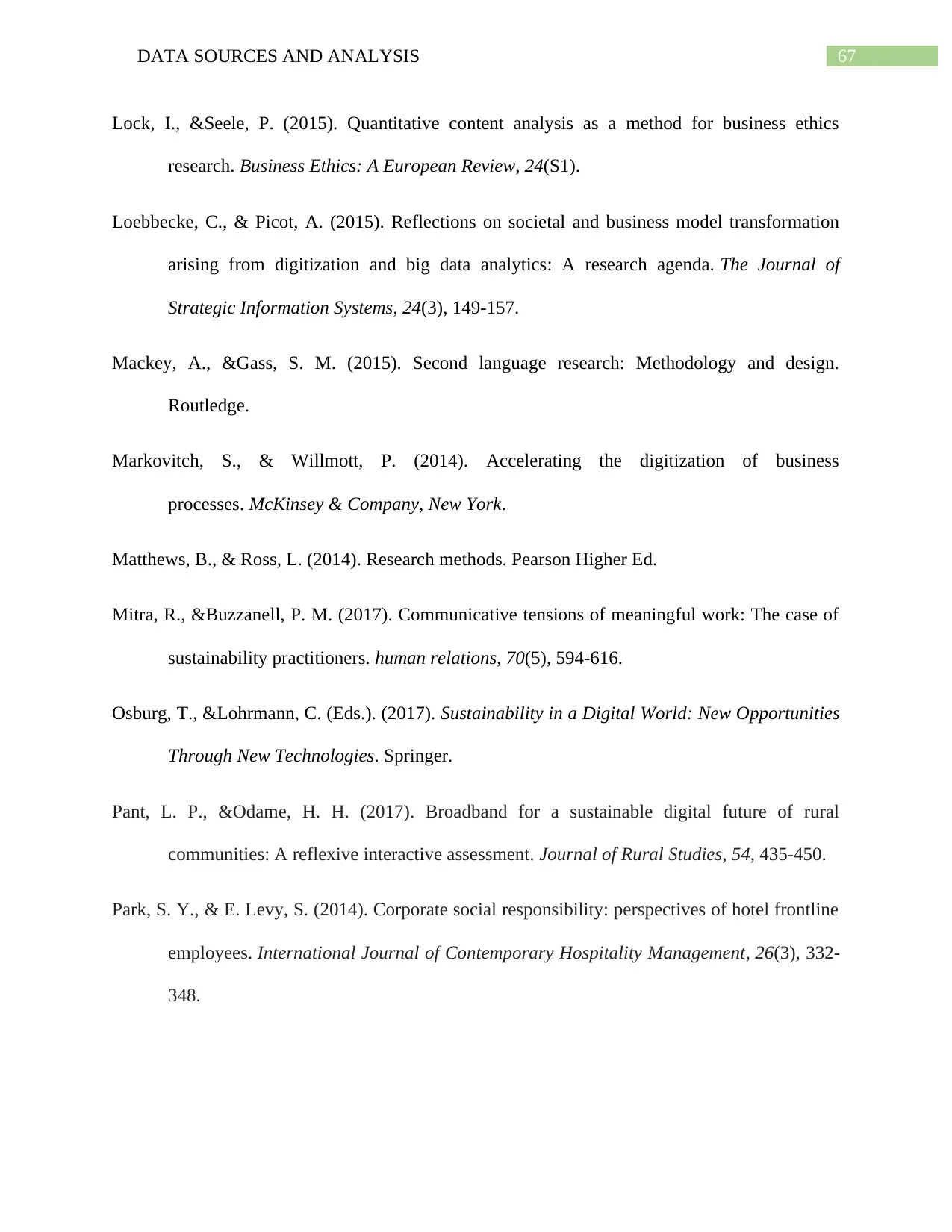
67DATA SOURCES AND ANALYSIS
Lock, I., &Seele, P. (2015). Quantitative content analysis as a method for business ethics
research. Business Ethics: A European Review, 24(S1).
Loebbecke, C., & Picot, A. (2015). Reflections on societal and business model transformation
arising from digitization and big data analytics: A research agenda. The Journal of
Strategic Information Systems, 24(3), 149-157.
Mackey, A., &Gass, S. M. (2015). Second language research: Methodology and design.
Routledge.
Markovitch, S., & Willmott, P. (2014). Accelerating the digitization of business
processes. McKinsey & Company, New York.
Matthews, B., & Ross, L. (2014). Research methods. Pearson Higher Ed.
Mitra, R., &Buzzanell, P. M. (2017). Communicative tensions of meaningful work: The case of
sustainability practitioners. human relations, 70(5), 594-616.
Osburg, T., &Lohrmann, C. (Eds.). (2017). Sustainability in a Digital World: New Opportunities
Through New Technologies. Springer.
Pant, L. P., &Odame, H. H. (2017). Broadband for a sustainable digital future of rural
communities: A reflexive interactive assessment. Journal of Rural Studies, 54, 435-450.
Park, S. Y., & E. Levy, S. (2014). Corporate social responsibility: perspectives of hotel frontline
employees. International Journal of Contemporary Hospitality Management, 26(3), 332-
348.
Lock, I., &Seele, P. (2015). Quantitative content analysis as a method for business ethics
research. Business Ethics: A European Review, 24(S1).
Loebbecke, C., & Picot, A. (2015). Reflections on societal and business model transformation
arising from digitization and big data analytics: A research agenda. The Journal of
Strategic Information Systems, 24(3), 149-157.
Mackey, A., &Gass, S. M. (2015). Second language research: Methodology and design.
Routledge.
Markovitch, S., & Willmott, P. (2014). Accelerating the digitization of business
processes. McKinsey & Company, New York.
Matthews, B., & Ross, L. (2014). Research methods. Pearson Higher Ed.
Mitra, R., &Buzzanell, P. M. (2017). Communicative tensions of meaningful work: The case of
sustainability practitioners. human relations, 70(5), 594-616.
Osburg, T., &Lohrmann, C. (Eds.). (2017). Sustainability in a Digital World: New Opportunities
Through New Technologies. Springer.
Pant, L. P., &Odame, H. H. (2017). Broadband for a sustainable digital future of rural
communities: A reflexive interactive assessment. Journal of Rural Studies, 54, 435-450.
Park, S. Y., & E. Levy, S. (2014). Corporate social responsibility: perspectives of hotel frontline
employees. International Journal of Contemporary Hospitality Management, 26(3), 332-
348.
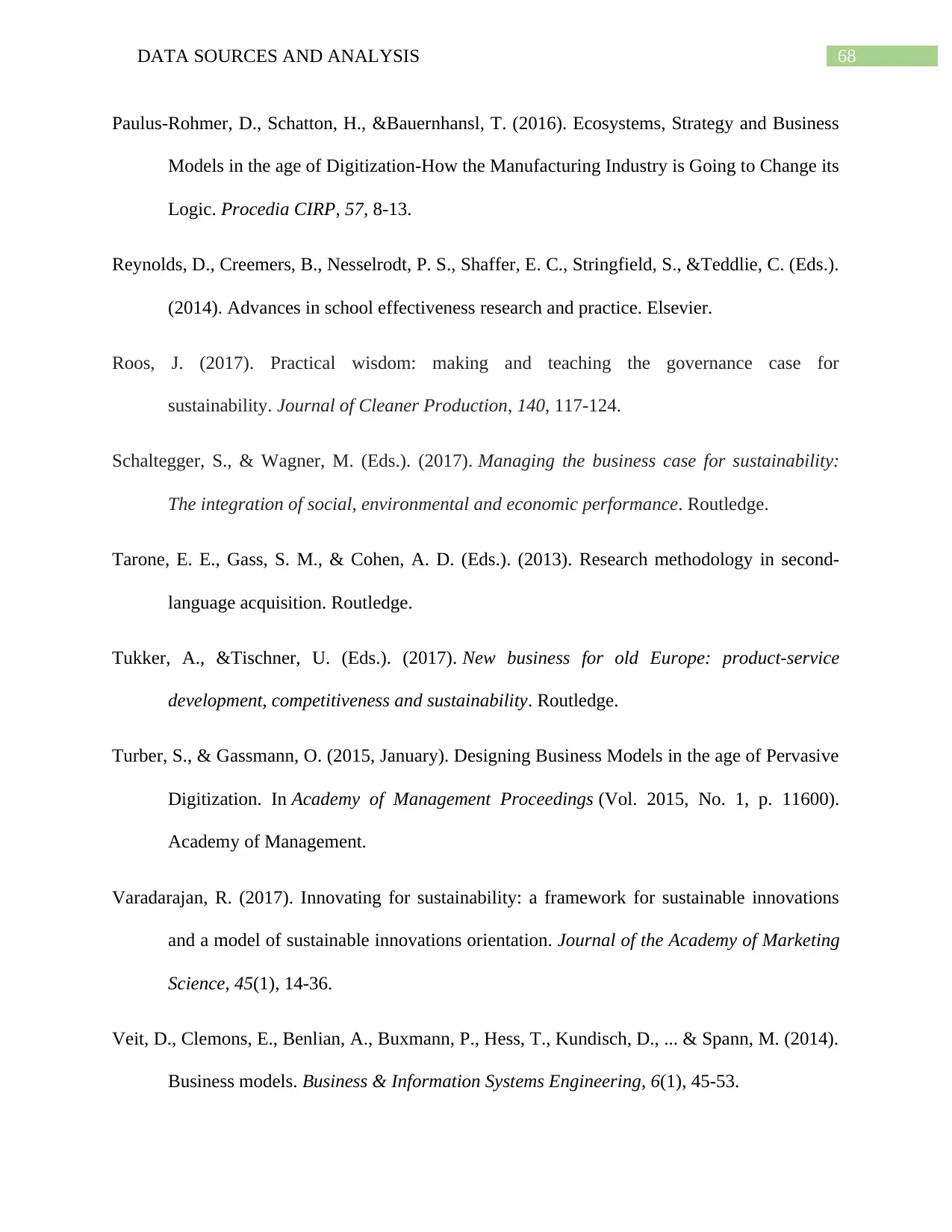
68DATA SOURCES AND ANALYSIS
Paulus-Rohmer, D., Schatton, H., &Bauernhansl, T. (2016). Ecosystems, Strategy and Business
Models in the age of Digitization-How the Manufacturing Industry is Going to Change its
Logic. Procedia CIRP, 57, 8-13.
Reynolds, D., Creemers, B., Nesselrodt, P. S., Shaffer, E. C., Stringfield, S., &Teddlie, C. (Eds.).
(2014). Advances in school effectiveness research and practice. Elsevier.
Roos, J. (2017). Practical wisdom: making and teaching the governance case for
sustainability. Journal of Cleaner Production, 140, 117-124.
Schaltegger, S., & Wagner, M. (Eds.). (2017). Managing the business case for sustainability:
The integration of social, environmental and economic performance. Routledge.
Tarone, E. E., Gass, S. M., & Cohen, A. D. (Eds.). (2013). Research methodology in second-
language acquisition. Routledge.
Tukker, A., &Tischner, U. (Eds.). (2017). New business for old Europe: product-service
development, competitiveness and sustainability. Routledge.
Turber, S., & Gassmann, O. (2015, January). Designing Business Models in the age of Pervasive
Digitization. In Academy of Management Proceedings (Vol. 2015, No. 1, p. 11600).
Academy of Management.
Varadarajan, R. (2017). Innovating for sustainability: a framework for sustainable innovations
and a model of sustainable innovations orientation. Journal of the Academy of Marketing
Science, 45(1), 14-36.
Veit, D., Clemons, E., Benlian, A., Buxmann, P., Hess, T., Kundisch, D., ... & Spann, M. (2014).
Business models. Business & Information Systems Engineering, 6(1), 45-53.
Paulus-Rohmer, D., Schatton, H., &Bauernhansl, T. (2016). Ecosystems, Strategy and Business
Models in the age of Digitization-How the Manufacturing Industry is Going to Change its
Logic. Procedia CIRP, 57, 8-13.
Reynolds, D., Creemers, B., Nesselrodt, P. S., Shaffer, E. C., Stringfield, S., &Teddlie, C. (Eds.).
(2014). Advances in school effectiveness research and practice. Elsevier.
Roos, J. (2017). Practical wisdom: making and teaching the governance case for
sustainability. Journal of Cleaner Production, 140, 117-124.
Schaltegger, S., & Wagner, M. (Eds.). (2017). Managing the business case for sustainability:
The integration of social, environmental and economic performance. Routledge.
Tarone, E. E., Gass, S. M., & Cohen, A. D. (Eds.). (2013). Research methodology in second-
language acquisition. Routledge.
Tukker, A., &Tischner, U. (Eds.). (2017). New business for old Europe: product-service
development, competitiveness and sustainability. Routledge.
Turber, S., & Gassmann, O. (2015, January). Designing Business Models in the age of Pervasive
Digitization. In Academy of Management Proceedings (Vol. 2015, No. 1, p. 11600).
Academy of Management.
Varadarajan, R. (2017). Innovating for sustainability: a framework for sustainable innovations
and a model of sustainable innovations orientation. Journal of the Academy of Marketing
Science, 45(1), 14-36.
Veit, D., Clemons, E., Benlian, A., Buxmann, P., Hess, T., Kundisch, D., ... & Spann, M. (2014).
Business models. Business & Information Systems Engineering, 6(1), 45-53.
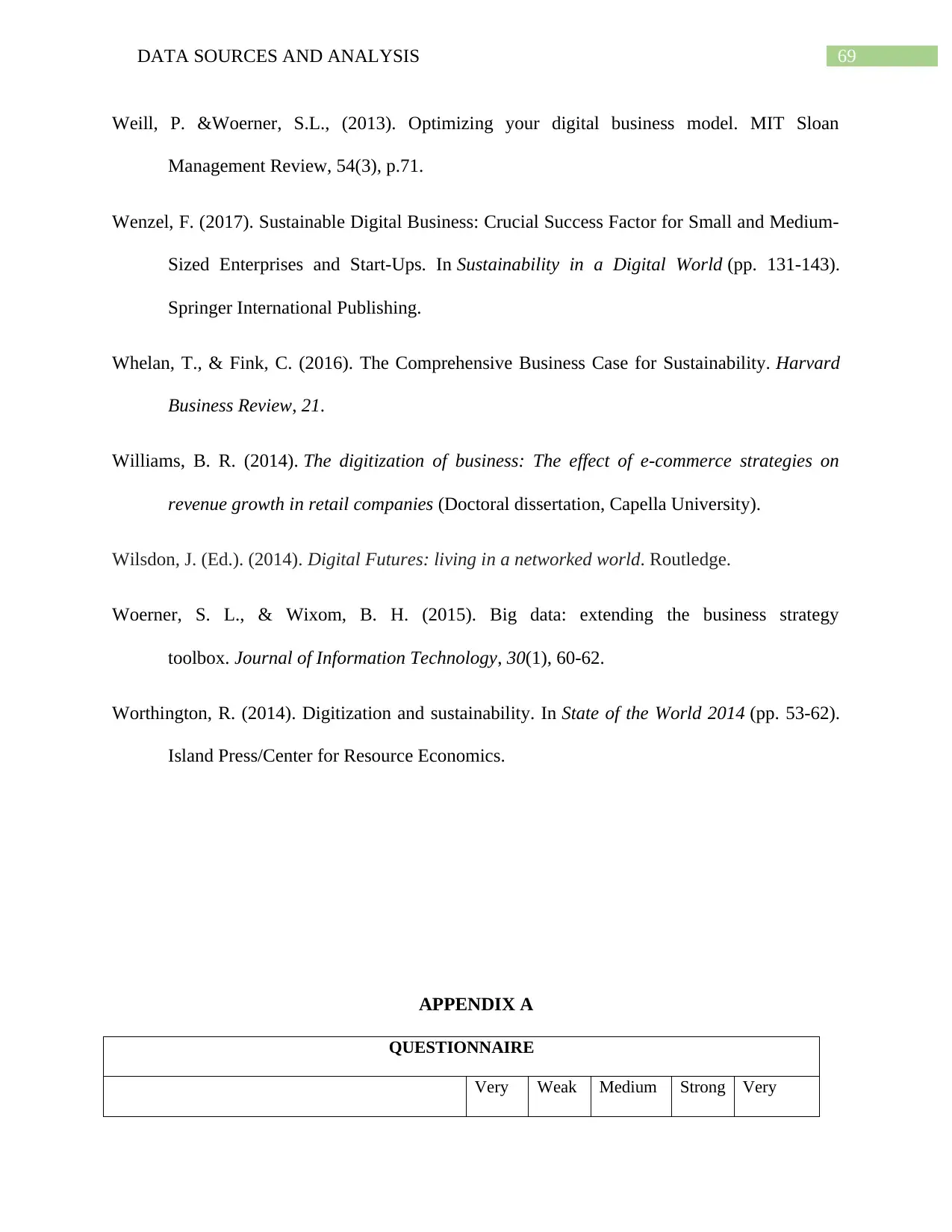
69DATA SOURCES AND ANALYSIS
Weill, P. &Woerner, S.L., (2013). Optimizing your digital business model. MIT Sloan
Management Review, 54(3), p.71.
Wenzel, F. (2017). Sustainable Digital Business: Crucial Success Factor for Small and Medium-
Sized Enterprises and Start-Ups. In Sustainability in a Digital World (pp. 131-143).
Springer International Publishing.
Whelan, T., & Fink, C. (2016). The Comprehensive Business Case for Sustainability. Harvard
Business Review, 21.
Williams, B. R. (2014). The digitization of business: The effect of e-commerce strategies on
revenue growth in retail companies (Doctoral dissertation, Capella University).
Wilsdon, J. (Ed.). (2014). Digital Futures: living in a networked world. Routledge.
Woerner, S. L., & Wixom, B. H. (2015). Big data: extending the business strategy
toolbox. Journal of Information Technology, 30(1), 60-62.
Worthington, R. (2014). Digitization and sustainability. In State of the World 2014 (pp. 53-62).
Island Press/Center for Resource Economics.
APPENDIX A
QUESTIONNAIRE
Very Weak Medium Strong Very
Weill, P. &Woerner, S.L., (2013). Optimizing your digital business model. MIT Sloan
Management Review, 54(3), p.71.
Wenzel, F. (2017). Sustainable Digital Business: Crucial Success Factor for Small and Medium-
Sized Enterprises and Start-Ups. In Sustainability in a Digital World (pp. 131-143).
Springer International Publishing.
Whelan, T., & Fink, C. (2016). The Comprehensive Business Case for Sustainability. Harvard
Business Review, 21.
Williams, B. R. (2014). The digitization of business: The effect of e-commerce strategies on
revenue growth in retail companies (Doctoral dissertation, Capella University).
Wilsdon, J. (Ed.). (2014). Digital Futures: living in a networked world. Routledge.
Woerner, S. L., & Wixom, B. H. (2015). Big data: extending the business strategy
toolbox. Journal of Information Technology, 30(1), 60-62.
Worthington, R. (2014). Digitization and sustainability. In State of the World 2014 (pp. 53-62).
Island Press/Center for Resource Economics.
APPENDIX A
QUESTIONNAIRE
Very Weak Medium Strong Very
Secure Best Marks with AI Grader
Need help grading? Try our AI Grader for instant feedback on your assignments.
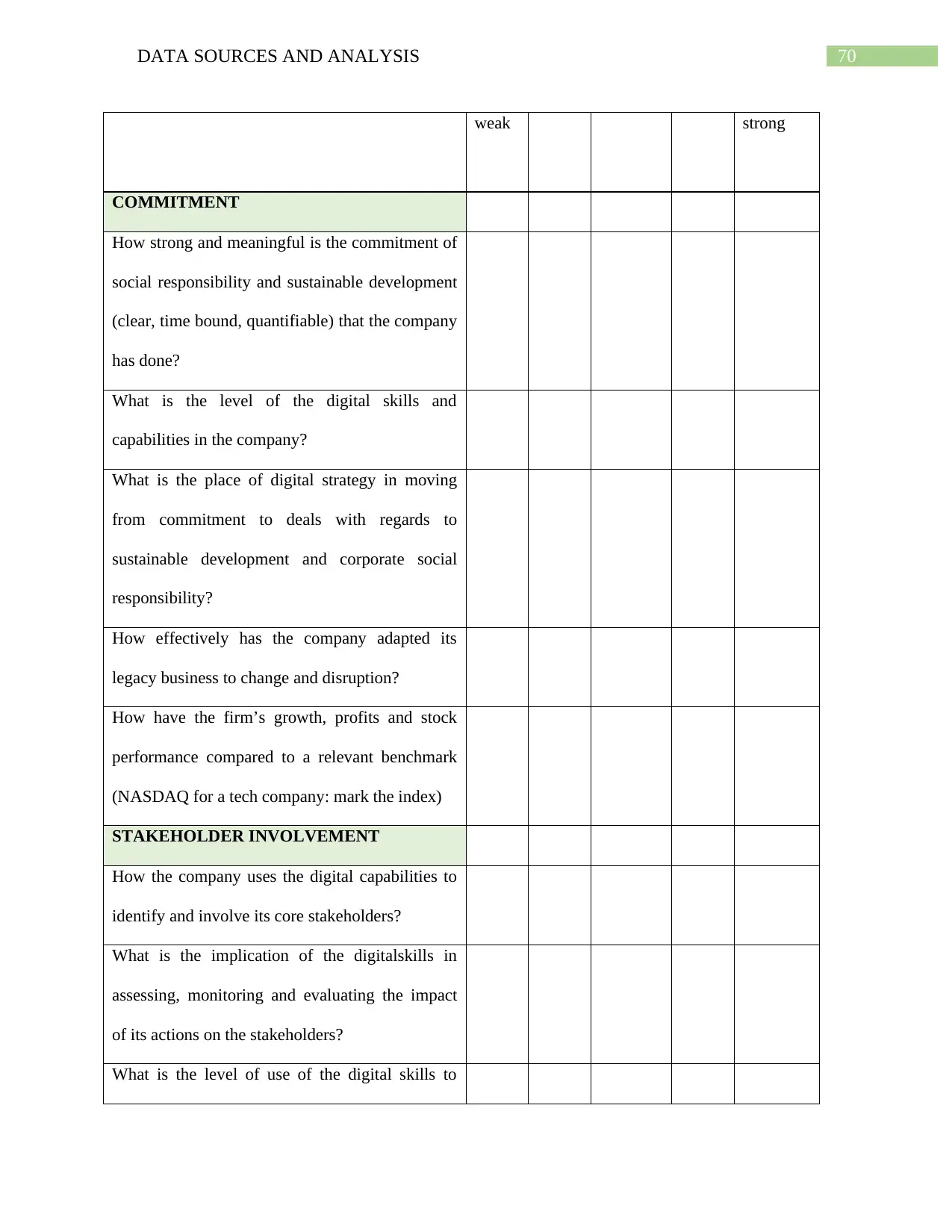
70DATA SOURCES AND ANALYSIS
weak strong
COMMITMENT
How strong and meaningful is the commitment of
social responsibility and sustainable development
(clear, time bound, quantifiable) that the company
has done?
What is the level of the digital skills and
capabilities in the company?
What is the place of digital strategy in moving
from commitment to deals with regards to
sustainable development and corporate social
responsibility?
How effectively has the company adapted its
legacy business to change and disruption?
How have the firm’s growth, profits and stock
performance compared to a relevant benchmark
(NASDAQ for a tech company: mark the index)
STAKEHOLDER INVOLVEMENT
How the company uses the digital capabilities to
identify and involve its core stakeholders?
What is the implication of the digitalskills in
assessing, monitoring and evaluating the impact
of its actions on the stakeholders?
What is the level of use of the digital skills to
weak strong
COMMITMENT
How strong and meaningful is the commitment of
social responsibility and sustainable development
(clear, time bound, quantifiable) that the company
has done?
What is the level of the digital skills and
capabilities in the company?
What is the place of digital strategy in moving
from commitment to deals with regards to
sustainable development and corporate social
responsibility?
How effectively has the company adapted its
legacy business to change and disruption?
How have the firm’s growth, profits and stock
performance compared to a relevant benchmark
(NASDAQ for a tech company: mark the index)
STAKEHOLDER INVOLVEMENT
How the company uses the digital capabilities to
identify and involve its core stakeholders?
What is the implication of the digitalskills in
assessing, monitoring and evaluating the impact
of its actions on the stakeholders?
What is the level of use of the digital skills to
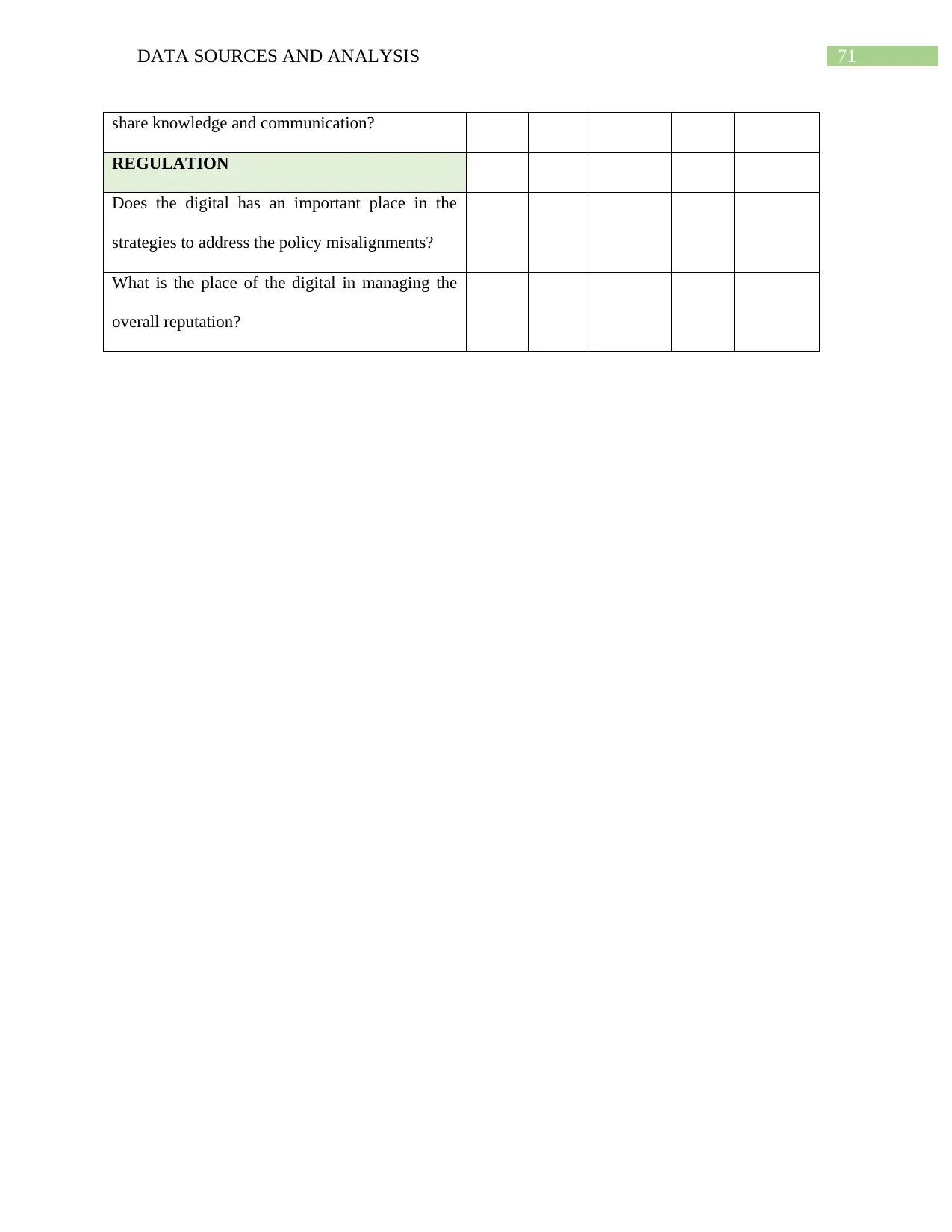
71DATA SOURCES AND ANALYSIS
share knowledge and communication?
REGULATION
Does the digital has an important place in the
strategies to address the policy misalignments?
What is the place of the digital in managing the
overall reputation?
share knowledge and communication?
REGULATION
Does the digital has an important place in the
strategies to address the policy misalignments?
What is the place of the digital in managing the
overall reputation?
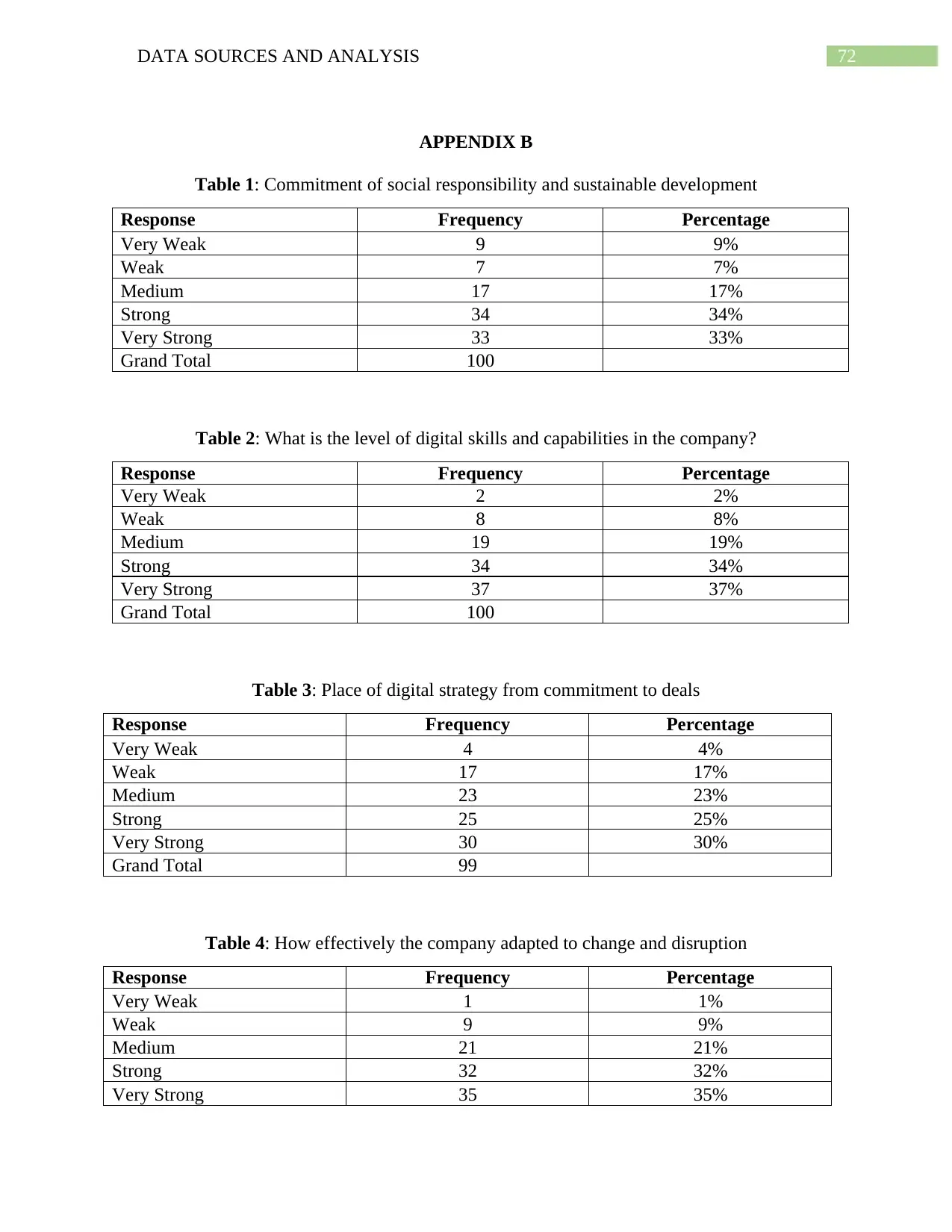
72DATA SOURCES AND ANALYSIS
APPENDIX B
Table 1: Commitment of social responsibility and sustainable development
Response Frequency Percentage
Very Weak 9 9%
Weak 7 7%
Medium 17 17%
Strong 34 34%
Very Strong 33 33%
Grand Total 100
Table 2: What is the level of digital skills and capabilities in the company?
Response Frequency Percentage
Very Weak 2 2%
Weak 8 8%
Medium 19 19%
Strong 34 34%
Very Strong 37 37%
Grand Total 100
Table 3: Place of digital strategy from commitment to deals
Response Frequency Percentage
Very Weak 4 4%
Weak 17 17%
Medium 23 23%
Strong 25 25%
Very Strong 30 30%
Grand Total 99
Table 4: How effectively the company adapted to change and disruption
Response Frequency Percentage
Very Weak 1 1%
Weak 9 9%
Medium 21 21%
Strong 32 32%
Very Strong 35 35%
APPENDIX B
Table 1: Commitment of social responsibility and sustainable development
Response Frequency Percentage
Very Weak 9 9%
Weak 7 7%
Medium 17 17%
Strong 34 34%
Very Strong 33 33%
Grand Total 100
Table 2: What is the level of digital skills and capabilities in the company?
Response Frequency Percentage
Very Weak 2 2%
Weak 8 8%
Medium 19 19%
Strong 34 34%
Very Strong 37 37%
Grand Total 100
Table 3: Place of digital strategy from commitment to deals
Response Frequency Percentage
Very Weak 4 4%
Weak 17 17%
Medium 23 23%
Strong 25 25%
Very Strong 30 30%
Grand Total 99
Table 4: How effectively the company adapted to change and disruption
Response Frequency Percentage
Very Weak 1 1%
Weak 9 9%
Medium 21 21%
Strong 32 32%
Very Strong 35 35%
Paraphrase This Document
Need a fresh take? Get an instant paraphrase of this document with our AI Paraphraser
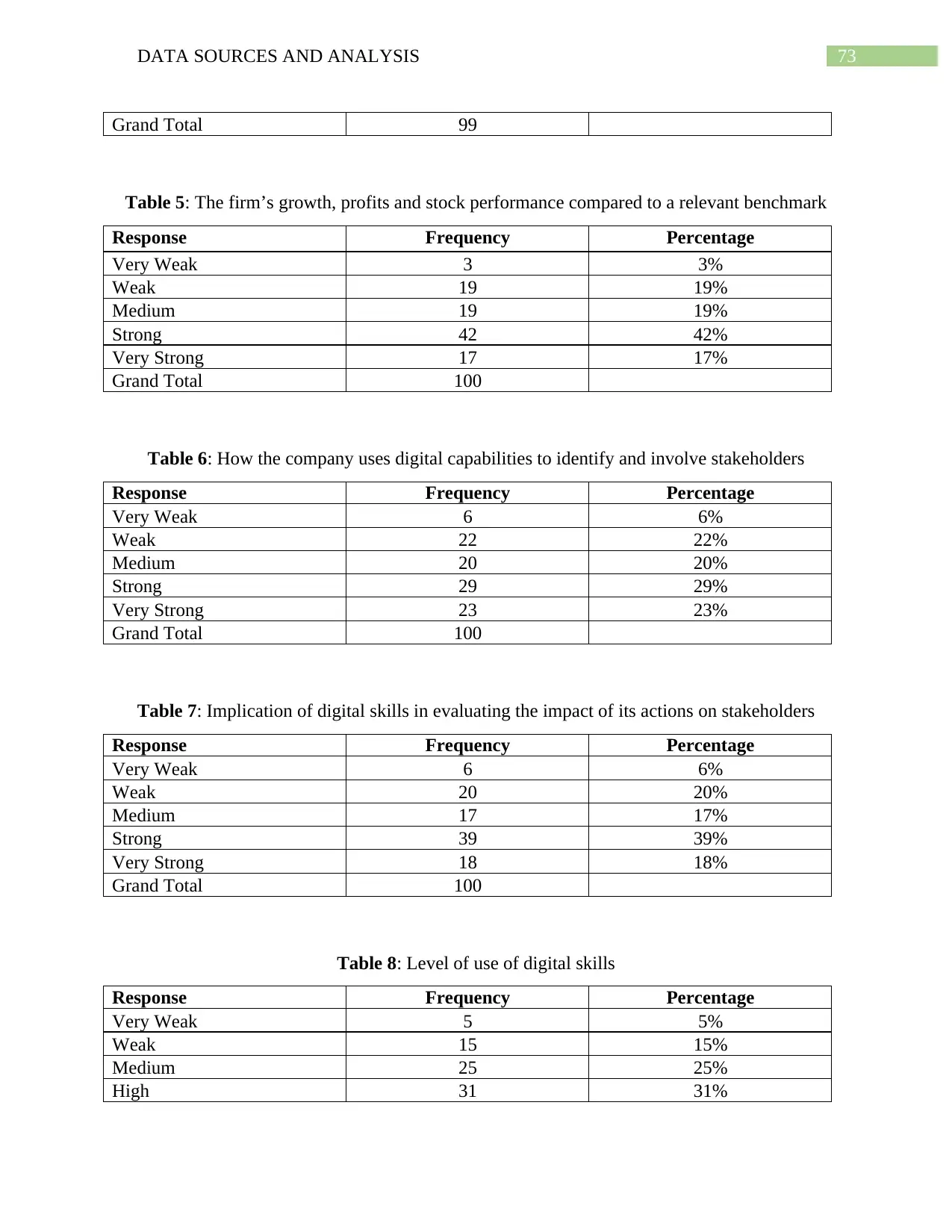
73DATA SOURCES AND ANALYSIS
Grand Total 99
Table 5: The firm’s growth, profits and stock performance compared to a relevant benchmark
Response Frequency Percentage
Very Weak 3 3%
Weak 19 19%
Medium 19 19%
Strong 42 42%
Very Strong 17 17%
Grand Total 100
Table 6: How the company uses digital capabilities to identify and involve stakeholders
Response Frequency Percentage
Very Weak 6 6%
Weak 22 22%
Medium 20 20%
Strong 29 29%
Very Strong 23 23%
Grand Total 100
Table 7: Implication of digital skills in evaluating the impact of its actions on stakeholders
Response Frequency Percentage
Very Weak 6 6%
Weak 20 20%
Medium 17 17%
Strong 39 39%
Very Strong 18 18%
Grand Total 100
Table 8: Level of use of digital skills
Response Frequency Percentage
Very Weak 5 5%
Weak 15 15%
Medium 25 25%
High 31 31%
Grand Total 99
Table 5: The firm’s growth, profits and stock performance compared to a relevant benchmark
Response Frequency Percentage
Very Weak 3 3%
Weak 19 19%
Medium 19 19%
Strong 42 42%
Very Strong 17 17%
Grand Total 100
Table 6: How the company uses digital capabilities to identify and involve stakeholders
Response Frequency Percentage
Very Weak 6 6%
Weak 22 22%
Medium 20 20%
Strong 29 29%
Very Strong 23 23%
Grand Total 100
Table 7: Implication of digital skills in evaluating the impact of its actions on stakeholders
Response Frequency Percentage
Very Weak 6 6%
Weak 20 20%
Medium 17 17%
Strong 39 39%
Very Strong 18 18%
Grand Total 100
Table 8: Level of use of digital skills
Response Frequency Percentage
Very Weak 5 5%
Weak 15 15%
Medium 25 25%
High 31 31%

74DATA SOURCES AND ANALYSIS
Very High 24 24%
Grand Total 100
Table 9: Digital has an important place in strategies to address policy misalignments
Response Frequency Percentage
Very Weak 5 5%
Weak 15 15%
Medium 27 27%
Strong 31 31%
Very Strong 22 22%
Grand Total 100
Table 10: Place of digital in managing overall reputation
Row Labels Frequency Percentage
Very Weak 3 3%
Weak 9 9%
Medium 24 24%
Strong 35 35%
Very Strong 19 19%
Grand Total 100
Table 11: Summary for difference in opinions in commitment in terms of industries
Groups Count Sum Average Variance
Accessories 2 8 4 0
Aerospace 2 9 4.5 0.5
Automotive 5 20 4 2
Beauty 4 12 3 0.67
Cloud Computing 3 11 3.67 2.33
Commodities 0 0 #DIV/0! #DIV/0!
Conglomerate 6 23 3.83 0.97
Consumer Goods 4 17 4.25 0.92
Content Management 1 5 5 #DIV/0!
Data Wartehousing 1 5 5 #DIV/0!
Digital Imaging 1 5 5 #DIV/0!
E-Commerce 3 8 2.67 0.33
Electronics 4 16 4 0.67
Energy 6 24 4 0.8
Very High 24 24%
Grand Total 100
Table 9: Digital has an important place in strategies to address policy misalignments
Response Frequency Percentage
Very Weak 5 5%
Weak 15 15%
Medium 27 27%
Strong 31 31%
Very Strong 22 22%
Grand Total 100
Table 10: Place of digital in managing overall reputation
Row Labels Frequency Percentage
Very Weak 3 3%
Weak 9 9%
Medium 24 24%
Strong 35 35%
Very Strong 19 19%
Grand Total 100
Table 11: Summary for difference in opinions in commitment in terms of industries
Groups Count Sum Average Variance
Accessories 2 8 4 0
Aerospace 2 9 4.5 0.5
Automotive 5 20 4 2
Beauty 4 12 3 0.67
Cloud Computing 3 11 3.67 2.33
Commodities 0 0 #DIV/0! #DIV/0!
Conglomerate 6 23 3.83 0.97
Consumer Goods 4 17 4.25 0.92
Content Management 1 5 5 #DIV/0!
Data Wartehousing 1 5 5 #DIV/0!
Digital Imaging 1 5 5 #DIV/0!
E-Commerce 3 8 2.67 0.33
Electronics 4 16 4 0.67
Energy 6 24 4 0.8

75DATA SOURCES AND ANALYSIS
Engineering and Services 1 3 3 #DIV/0!
Entertainent 1 2 2 #DIV/0!
Express Logistics 1 5 5 #DIV/0!
Fiber 1 4 4 #DIV/0!
Financial 5 17 3.4 0.8
Food 3 10 3.33 0.33
Telecommunication 7 25 3.57 1.29
Hardware 2 10 5 0
Heavy Equipment 2 10 5 0
IT 8 28 3.5 1.71
Manufacturing 7 25 3.57 0.95
metals and mining 2 7 3.5 4.5
pharmaceutical 3 10 3.33 0.33
real estate 1 5 5 #DIV/0!
retail 8 35 4.38 0.84
Transportation 6 24 4 0.4
Table 12: Summary for difference in opinions in stakeholders’ involvement in terms of
industries
Groups Count Sum Average Variance
Accessories 2 7 3.5 0.5
Aerospace 2 7 3.5 4.5
Automotive 5 17 3.4 3.3
Beauty 4 10 2.5 1.67
Cloud Computing 3 9 3 3
Conglomerate 6 22 3.67 1.47
Consumer Goods 4 17 4.25 0.25
Content Management 1 4 4 #DIV/0!
Data Wartehousing 1 2 2 #DIV/0!
Digital Imaging 1 5 5 #DIV/0!
E-Commerce 3 9 3 1
Electronics 4 16 4 0.67
Energy 6 19 3.17 0.97
Engineering and Services 1 4 4 #DIV/0!
Entertainent 1 4 4 #DIV/0!
Express Logistics 1 5 5 #DIV/0!
Fiber 1 3 3 #DIV/0!
Financial 5 15 3 1
Food 3 8 2.67 0.33
Telecommunication 7 23 3.29 2.24
Hardware 2 10 5 0
Engineering and Services 1 3 3 #DIV/0!
Entertainent 1 2 2 #DIV/0!
Express Logistics 1 5 5 #DIV/0!
Fiber 1 4 4 #DIV/0!
Financial 5 17 3.4 0.8
Food 3 10 3.33 0.33
Telecommunication 7 25 3.57 1.29
Hardware 2 10 5 0
Heavy Equipment 2 10 5 0
IT 8 28 3.5 1.71
Manufacturing 7 25 3.57 0.95
metals and mining 2 7 3.5 4.5
pharmaceutical 3 10 3.33 0.33
real estate 1 5 5 #DIV/0!
retail 8 35 4.38 0.84
Transportation 6 24 4 0.4
Table 12: Summary for difference in opinions in stakeholders’ involvement in terms of
industries
Groups Count Sum Average Variance
Accessories 2 7 3.5 0.5
Aerospace 2 7 3.5 4.5
Automotive 5 17 3.4 3.3
Beauty 4 10 2.5 1.67
Cloud Computing 3 9 3 3
Conglomerate 6 22 3.67 1.47
Consumer Goods 4 17 4.25 0.25
Content Management 1 4 4 #DIV/0!
Data Wartehousing 1 2 2 #DIV/0!
Digital Imaging 1 5 5 #DIV/0!
E-Commerce 3 9 3 1
Electronics 4 16 4 0.67
Energy 6 19 3.17 0.97
Engineering and Services 1 4 4 #DIV/0!
Entertainent 1 4 4 #DIV/0!
Express Logistics 1 5 5 #DIV/0!
Fiber 1 3 3 #DIV/0!
Financial 5 15 3 1
Food 3 8 2.67 0.33
Telecommunication 7 23 3.29 2.24
Hardware 2 10 5 0
1 out of 76
Related Documents
Your All-in-One AI-Powered Toolkit for Academic Success.
+13062052269
info@desklib.com
Available 24*7 on WhatsApp / Email
![[object Object]](/_next/static/media/star-bottom.7253800d.svg)
Unlock your academic potential
© 2024 | Zucol Services PVT LTD | All rights reserved.





